

Towing 101: What You Need to Know to Tow with Confidence
Need a towing tutorial we got you..
F or so many of us, towing has become a thing. We have cars and SUVs that can tow, and we have learned we really love adventure . And towing has become a year-round pursuit: boats in summer, snowmobiles in winter, campers to escape from the city all year long. Any time of the year is a good time to break out the ball hitch and breakaway chains and hook up the trailer !
If you have ever rented a trailer or Uhaul and the attendant checked your equipment and hooked it up for you, it may have seemed so easy, and no extra license or training is required for most recreational towing. But there is a lot to know about safe towing. An overly heavy load can pull your car off the road, and an improperly secured trailer is a danger to everyone. The key is to understand the details of towing – from your vehicle’s tow capacity to trailer hitch style to how to adjust your driving for your trailer.
It’s not as scary as it may seem, but it also isn’t something to go into blind. Here is what you need to know to keep yourself (and other drivers) safe while you are towing .
Related: Let’s Tow Everything!
Know your real towing capacity.
The first step to towing with your vehicle is to know your vehicle’s tow capacity. Tow capacity is the maximum amount of weight your vehicle can pull – not just the trailer but the actual vehicle, its contents, and the trailer weight.
While many calculations factor into a manufacturer’s tow capacity, let me simplify it for you. It starts with the GCVW, or gross combined vehicle weight. You can find this number, which factors in the engine power, transmission, and other specs to calculate the maximum amount of weight the vehicle can tow and haul. That is the number the manufacturer uses to calculate the maximum towing capacity for the vehicle .
This GCVW measure can be found on the manufacturer’s website, in your owner’s manual, or in the car itself. If you can’t find it, you can always run by your local dealership – always better safe than sorry.
Related: Why Girls Love Trucks and How the Best Trucks Make Us Feel
Can sedans and small suvs tow.
If you own a sedan or crossover that does not have a towing capacity listed in the owner’s manual (or it’s just so buried in the pages that you can’t find it), this does not mean you can’t tow. Almost any sedan or crossover can tow, even if they don’t come from the factory with a tow hitch. Companies like UHaul or any mechanic can fit one on a vehicle. Just be sure to know how much weight you can pull.
You can always Google search your vehicle’s tow capacity, but make sure the source is accurate and specific to your car, motor, and packages. The safest bet is always going straight to the source – the manufacturer or dealer.
Most sub-compacts, coupes , and roadsters will not have a rated tow capacity from the manufacturer and are deemed unsafe to tow with.
Once you know your vehicle’s towing capacity, do NOT exceed it. This can cause excess damage to your car and can be unsafe for you and other motorists on the road.
Related: Our Five Favorite Trucks, Minivans, and SUVs for Tailgating
How much can you tow figuring out your practical tow rating.
Remember that your towing capacity will be situational, so your practical tow rating – the actual weight you can tow – may be lower. For example, if your full-sized sedan is rated to town 1,500 lbs but your hitch is only rated for 1000 lbs, your practical tow rating is only 1,000 lbs. Or maybe you are driving a pickup truck with a 10,000 lb. towing capacity, but you have 7,000 lbs of bricks in the truck bed (for one heck of a garden makeover!). In this case, towing 10,000 lbs will exceed your truck’s GVCW, or gross vehicle combined weight (the total allowable weight of the car, passengers, cargo, payload, and trailers), so it is unsafe to combine this heavy payload with a heavy trailer.
For cars with lower towing capacities, especially sedans, even just having the car full of passengers could impact your towing capacity.
Consider the Trailer’s Weight in Your Calculations
You will, obviously, need to be aware of the weight you are towing. Most trailers are sold with documents displaying their unloaded weight — but don’t forget to add the weight of the items you carry in the trailer. For example, my race trailer weighs 3,600 lbs unloaded, and my car weighs 2,000 lbs. But I can’t forget about the hundreds of pounds of tools, tool boxes, tires, wheels, fuel, and other equipment also in the trailer.
The same goes for campers – if you add furniture and luggage to a camper, don’t forget to consider that weight. The easiest way to do this is to consider the trailer’s gross vehicle weight rating, or GVWR (remember, this is the TOTAL allowable weight of the trailer, including the weight of the trailer itself). Since your load should never exceed the trailer’s GVWR, if your vehicle can pull the GVWR, you will be a-okay.
Along this same thread, be aware of your trailer’s GVWR and be sure your load doesn’t exceed it. Remember, the GVWR includes the trailer’s weight itself. If a trailer’s GVWR is 5,000 lbs and the trailer weighs 1,000 lbs, you can only carry up to 4,000 lbs of cargo.
Equipment Calculations Matter, Too
Once you have confirmed that your vehicle can tow your desired trailer, it is time to consider the equipment you’ll need.
If your car does not have a tow hitch, technically called a receiver hitch, you must have one fitted. Receiver hitches do have weight limits, so ensure the receiver hitch you choose is rated for sufficient weight. Be careful here – there are receivers on the market that have little to no weight rating. These are designed for smaller, non-trailer accessories, like bike racks. If your receiver is installed at the factory, the manufacturer will ensure this receiver hitch is rated for the towing capacity of the vehicle.
Some vehicles are equipped with a fifth-wheel hitch, though these are mostly full-size heavy-duty pickup trucks and are less commonly intended for recreational use. They can tow up to 20,000 lbs., sometimes more, so if your tow needs are really hefty, it might be worth looking into a truck with this much capacity.
And, the Sticky Part: The Capacity of Trailer Components
Next, you will need to source a trailer hitch, which goes into the car’s receiver and connects to the tongue (the very front point) of the trailer. For most consumer trailers, you will use a ball hitch. While other hitches exist, they are uncommon on the trailers designated for consumer use.
There are a few considerations with your ball hitch. First of all, just as with the receiver, your ball hitch will have a weight rating. I always recommend buying something rated for a good bit more than the weight you are towing, too. If you are towing 5,000 lbs., I would generally recommend not purchasing a 5,000 lb. ball and instead look for the next step up (likely 7,500 lbs.).
This hitch is attached to the receiver using a large hitch pin. You can purchase a standard pin, which is secured with a cotter pin in one end, or a locking version to provide some extra security . Always double and triple-check that this pin is properly fitted and that the cotter pin or lock is secure.
Ball hitches also come in different sizes. You want your ball to be sized properly for your trailer, so check the size of the coupler or the trailer size of the ball hitch connection to know what size to purchase. Sizes range from 1 ⅞” to 3”, with most trailers falling at 2” or 2-5/16”. Generally speaking, the larger and heavier the trailer’s weight rating, the larger the ball.
The physical ball on the hitch is bolted on and can be swapped out, although I find, for simplicity’s sake, it is often easier to buy a hitch with the ball already attached. In this way, you only have to worry about the weight rating for the entire hitch instead of having to match the weight ratings on the components. It also saves you from having to purchase a VERY large wrench!
If your vehicle does not have trailer wire hookups for your brake lights and any other necessary electrical systems, you must purchase this. Generally speaking, if your vehicle has a factory-installed receiver, you likely have a plug for the wires. If you had to have a receiver installed, the installer should be able to install the plug as well.
Now, On to the Fun!
Once you’ve done the math and ensured you have all the right capacities and equipment, you’re ready to tow. And I promise, it’s not as difficult as it sounds, and it’s worth it for all the fun you can have once you have that boat on the water– or that race car on the track!
Have a thought or comment? Share it with us on social media! You can find us on Instagram , Facebook , Twitter and LinkedIn . And be sure to sign up for our email newsletter !


First Look Teaser for Time Capsule Doc Film 'One To One: John & Yoko'
by Alex Billington August 30, 2024 Source: YouTube

John & Yoko in NYC! Mercury Studios has revealed a first look teaser trailer for a compelling documentary film titled One To One: John & Yoko , which is premiering now at the 2024 Venice Film Festival. The doc is a time capsule that takes us back to the year of 1972 , when John Lennon & Yoko Ono appeared in New York City and riled up the culture and politics by getting involved in activism and showing up on TV (also see: Daytime Revolution ). Set in 1972 New York, this documentary explores John and Yoko's world amid a turbulent era. Centered on the " One to One " charity concert for special needs children, it features unseen archives, home movies, and restored footage. A unique take on a seminal time in the lives of one of music’s most famous couples, One To One: John & Yoko explores the 18 months that John Lennon and Yoko Ono spent living in Greenwich Village in the early 70s - and how their relationship is changed by their experience in America. This is also the time when they almost got kicked out of the US on a bogus marijuana charge. I've seen this doc and it's excellent - a fascinating look back at another turbulent time in America's history.
Here's the teaser trailer for Macdonald & Rice-Edwards' doc One To One: John & Yoko , on YouTube :

This time capsule documentary film , set in New York in 1972, explores John and Yoko’s musical, personal, artistic, social, and political world against the backdrop of a turbulent era in American history. At the core of the film is the One to One charity concert for special needs children, John Lennon’s only full-length concert between the final Beatles concert in 1966 and his death. The film includes a wealth of previously unseen Lennon archives, including personal phone calls, home movies filmed by John and Yoko as well as restored and remastered footage from the One to One concert with remixed audio overseen by Sean Ono Lennon. One To One: John & Yoko is co-directed by acclaimed doc filmmakers Kevin Macdonald ( The Last King of Scotland , State of Play , How I Live Now , Life in a Day , Marley , Sky Ladder , Whitney ) & Sam Rice-Edwards ( Meet Me in the Bathroom doc). It's produced by Plan B / Km Films (Peter Worsley, Kevin Macdonald) and Mercury Studios (Alice Webb). The film is premiering at the 2024 Venice Film Festival this fall in the Out of Competition section. No other release dates have been set yet - stay tuned. Who's curious?
Find more posts: Documentaries , To Watch , Trailer , Venice 24
FEATURED POSTS
FOLLOW FS HERE
Follow Alex's new account on Bluesky :
Add our posts to your Feedly : click here
Your Privacy Manager
LATEST TO WATCH
▶ Football Doc Series 'Evolution of the Black Quarterback' Prime Trailer ( Sep 2 ) ▶ Netflix's Japanese Pro-Wrestler Series 'The Queen of Villains' Trailer ( Sep 2 ) ▶ Award-Winning Doc About Palestine - 'No Other Land' Official Trailer ( Sep 1 ) ▶ Official Trailer for 'Mad About the Boy: The Noel Coward Story' Doc ( Sep 1 ) ▶ 'Blink' Doc Trailer - Following a Family Experiencing the World's Beauty ( Aug 31 )
Want emails instead? Subscribe to our daily newsletter updates:
© 2006-2024 First Showing® LLC. All rights reserved. Privacy Policy | Letterboxd ➚ | Bookshop ➚ | Support FS ➚
- Cast & crew

A high-powered CEO puts her career and family on the line when she begins a torrid affair with her much younger intern. A high-powered CEO puts her career and family on the line when she begins a torrid affair with her much younger intern. A high-powered CEO puts her career and family on the line when she begins a torrid affair with her much younger intern.
- Halina Reijn
- Nicole Kidman
- Harris Dickinson
- Antonio Banderas
- 20 Critic reviews
- 1 nomination

Top cast 38

- All cast & crew
- Production, box office & more at IMDbPro
More like this

User reviews
The 2024 festival films you need to know.

- December 25, 2024 (United States)
- Netherlands
- United States
- New York City, New York, USA (street scenes)
- Man Up Film
- See more company credits at IMDbPro
Technical specs
- Runtime 1 hour 54 minutes
Related news
Contribute to this page.

- See more gaps
- Learn more about contributing
More to explore
Recently viewed.

Towing a travel trailer for the first time – tips

- BEGINNERS GUIDE
G. Yoganand
One of the primary reasons why people own or buy travel trailer is because they cost much less than a motorhome. Most people with tight budget get attracted to the price at which a trailer comes. It is not only the initial cots that is higher for motorhome but also the maintenance cost.
Travel Trailer would not cost for maintenance as much as a motorhome would. It also depends on how much you use your rv though and also a bit of luck. Owning a motorhome may not be possible for everyone considering the maintenance and cost related issues.
Another thing with motorhome is that you may not be able to take it everywhere you want to go where as if you owned a travel trailer you can always disconnect it from your towing vehicle and proceed with the towing vehicle.
Owning a travel trailer however means you need to have proper arrangements for towing it with your car or truck. It could sometimes become a difficult task at hand and it also offers its own obstacles.
This article is a travel trailer towing guide for new Rvers. Lets explore all the in-and-outs about towing a travel trailer or 5th wheel.
Towing trailer for the first time. What you need for towing.
Towing a travel trailer in itself is a challenge even if you have been doing it for years. For first timers this could be a headache if one is not enough aware of all the things around towing. Important thing is to get the right set of equipment for towing from reputed dealers.
Hithces are needed for towing the trailer and should be well connected at the rear end of the car or truck. For towing a small trailer a car can be enough but for bigger trailers or fifth wheels a truck is needed
One has to fully understand and learn all things about towing, right from getting the correct vehicle to tow to actually driving the vehicle on road following all the rules. Before even you start thinking about owning a travel trailer go through below pointers.
What kind of vehicle you need to tow a travel trailer.
One can tow a travel trailer or a 5th wheel or even a larger trailer. Depending on the kind of trailer you have you will have to decide on the vehicle to tow it. You can use a simple car, or an suv or also a truck that can handle high weight.
The kind of weight your trailer has will decide whether you go for a car or suv or bigger high capacity truck. You need to be careful before deciding on the towing vehicle and should not go ahead with your existing vehicle just because your car has a towing hitch to it.
Cars generally have thier own towing capcity and it is mentioned by the manufacturer on manual. Get to know the capacity of your car and comapre it with GVWR of the travel trailer.
What weight travel trailer can you tow
When you talk about weight of trailer you need to check the gross vehicle weight ratio for your towing vehicle. Infact even before you buy the trailer make sure you meet the GVWR with your vehicle. This is an important parameter and do not overlook it, as an extra weight may cause accidents.
To check the GWVR of your vehicle you may have to check for the official documentation of the vehicle or check with the dealer. Get the manual from your manufacturer and read all weight related specification and make sure you fully understand what it means.
After considering all the weight calculations (which should also include maximum number of people that can travel, including the full tank fuel weight) try to develop a combination of your travel trailer and vehicle that will meet all the weight needs and towing will be smooth.
Your trailer can carry only certain amount of weight and overloading in it will cause issues, always pack things that are necessary and do not cross the weight capacity of your trailer.
Distribute the weight
Apart from knowing and sticking to GWVR related limitations you will have to also try to distribute the load of vehicle as well as travel trailer. You need to learn about GAWR which means gross axle weight rating and get the measurements of wheel position loads.
Your tire pressure should also be adjusted in such a manner that it does not overload them with all the setup of towing. Make sure weight distribution is proper for front, back and sides for both, the vehicle as well as travel trailer.
When buying a new or used travel trailer the best thing you can do is check before hand about the capacity of your existing vehicle can tow. Then decide on the kind of travel trailer you want or else you will end up buying another vehicle just for towing the travel trailer.
All you need to know about hitches to connect both the vehicle and the travel trailer.
The element that connects both the vehicle and travel trailer is the hitch and infact the most important part in the whole process of towing a travel trailer. Most of the times your travel trailer would come with pre-installed hitch that can be used but one can go for an upgrade if needed.
Also, if you bought an old used travel trailer that didn’t have the hitch installed then you may want to buy a new one. Your hitch need to be selected carefully considering both the vehicle and travel trailer in mind.
Do proper research, study your travel trailer, towing vehicle, your usage and how much weight your travel trailer handles before deciding on the type of hitch you want installed.
The highest capacity weight that a hitch can handle depends on its lowest rated element in the chain. When selecting a hitch you need to consider two parameters, one is the GTW (gross trailer weight) and second is the maximum tongue weight.
Hitch Types
Depending on this, one can chose the hitch but its always better to go for heavy duty hitch even if you were to pull a light weight travel trailer. The five type of hitches include class 1 through class 5.
- Class 1 : This kind of hitch can handle a weigt f upto 2000 pounds
- Class 2 : Class 2 hitches are for a 3500 pounds capacity
- Class 3 : These are generally used for vans and have a capcity of 6500 pounds.
- Class 4 : They can be used for a weight of upto 12000 pound and are most suited for the travel trailers.
- Class 5 : They have the largest capacity among all. They are suited for heavy loads and handle the weights of upto 18000 pounds. They can be used for all travel trailers types and hence many people go for this type of hitch.
Things to keep in mind once you hit the road with towed travel trailer
Deciding on what kind of vehicle to tow your travel trailer, type of hitch and working on weight of your travel trailer are thing of importance. But, taking care while actually driving on the road is of utmost importance.
Towing a travel trailer is not and cannot be same as driving your car, suv, truck or even your big-bulky-lengthy motorhome. Driving a vehicle that has travel trailer towed needs different considerations, thinking and execution on road.
Here are some of things that you need to pay special attention to
Towing a travel trailer or even smaller RV like pop up camper should be done with care. You need to check the hitch, exterior everytime you start the travel. Lets see some of the basic thing you need to follow and be vary of.
1. Be cautioned while turning
Making turns while pulling a travel trailer or fifth wheel can be intimidating. You need to keep in mind the overall length of your moving combination of vehicles.
The length of both vehicle and RV will be much higher than your vehicle alone. Hence you will need extra space while making turns. Travel traielr can be lenghty and with both car and trailer togethert the entier lenght increases. Towing a 32 foot or 40 foot trailer can be really hard unless you have been doing it for years.
2. Drive slowly
You have to drive slower than you would normally while making turns else you could be in danger of overturning or going out of road or hitting another vehicle on road.
Towing a travel trailer or camper with wind can also be difficult and thus driving fast should be avoided with high winds. You will need advance planning in your mind about how much space you will need to make a turn.
3. Slow down for sharp turns
Making sharp turns with a towed vehicle can cause your anxiety levels, trying to keep calm and moving slower can help a lot.
4. Safety while Backing
Backing up is little tricky and you need special attention while doing this in towed travel trailer because it may be difficult to judge the length sometimes.
Also, your vision is blocked unless you have the camera to check the rear side on your screen. Not to mention you need to be slower than you would be without a towed travel trailer.
5. Careful while parking
Like backing up, parking too will need care and its better to have someone outside to help you with it. The dimensions will be different and you may not be able to judge the size of the vehicle especially if you are not used to it and doing it for the first time.
6. Use proper braking when traveling with a towed travel trailer
Having a travel trailer or camper towed means you are driving with a lot of weight. A high weight means your vehicle will take extra time to stop once you apply the breaks.
Make sure you keep this in mind and apply break with sufficient time when you want to stop. Also, do not apply sharp breaks rather plan and apply them so much that the vehicle would stop exactly where you want it to.
7. Practice
Braking, parking, turning all of these things would become easy tasks for you when you have got sufficient experience driving your vehicle with a travel trailer towed.
Breaking, parking, turning all of these things would become easy tasks for you when you have got sufficient experience driving your vehicle with a travel trailer behind.
Setting up a travel trailer for the first time can be little difficult. But, as you continue camping you can become proficient in that. Specially, with travel trailers you need to do the set up at camping sites which includes hitching and unhitching the trailer. It also includes how to level the trailer at campsite.
8. Do not overload
Many a time RVers pack items that are heavy or unnecessary. This leads to extra weight that can go out of limits. Every car has certain limit for towing and you should not go beyound that.
Make sure your trailer is not overloaded and stays within weight limits. When the weight exceeds the limits it can cause the travel trailer to sway.
Summarizing on the Safety for towing a travel trailer
- Drive slowly when towing a travel trailer
- Apply breaks thinking in mind the time it would take to stop. Don’t slam them.
- Avoid overloading your travel trailer
- Make yourself aware of length of your travel trailer plus the vehicle
- Don’t go for a hitch that handles the weight cut to cut. Instead go for a stronger one like class 5
- Distribute the weight in your RV camper as well as in your towing vehicle
- Park your vehicle with assistance as far as possible
- Chose your towing vehicle after careful considerations of the travel trailer weight
- Take special care when making sharp turns with your travel trailer towed vehicle
- Make sure your safety accessories are in proper shape. Have good rear mirrors, camera in place
- A towed travel trailer should not have anybody traveling in it. It can also be illegal to do so.
- When traveling with a towed trailer one can also have checklist and check each thing twice so as to keep everything thing safe.
Towing a travel trailer for the first time can be intimidating. With proper setup and help you can always make things easy for you. Experience is also important, with time one can surely master the travel trailer towing.
Untill you become can experiene one, do the practice of towing the tarvel trailer as much as possible. Apart from making proper setup and taking care getting right equipment is also important. Install hitches, backup camera, and do proper maintenance as well.
Hopefully this travel trailer towing guide has educated you enough and you are fully ready and prepared to tow your trailer or pop up camper or fifth wheel.
You Might Also Like
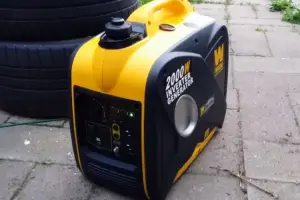
How much fuel does an rv generator use
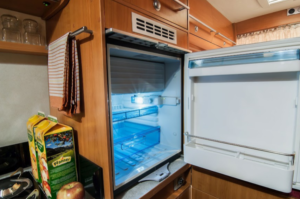
How many amps does an RV refrigerator draw
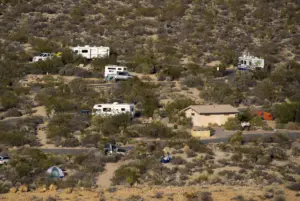
How Many Acres are needed to make an RV Park?
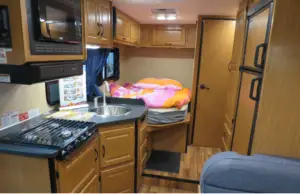
How to keep mold out of camper trailer (19 Ways to Prevent)

This post may contain affiliate links or mention our own products, please check out our disclosure policy
Everything You Need To Know About Towing A Travel Trailer
- Bruce Smith
- July 3, 2021
Table of Contents
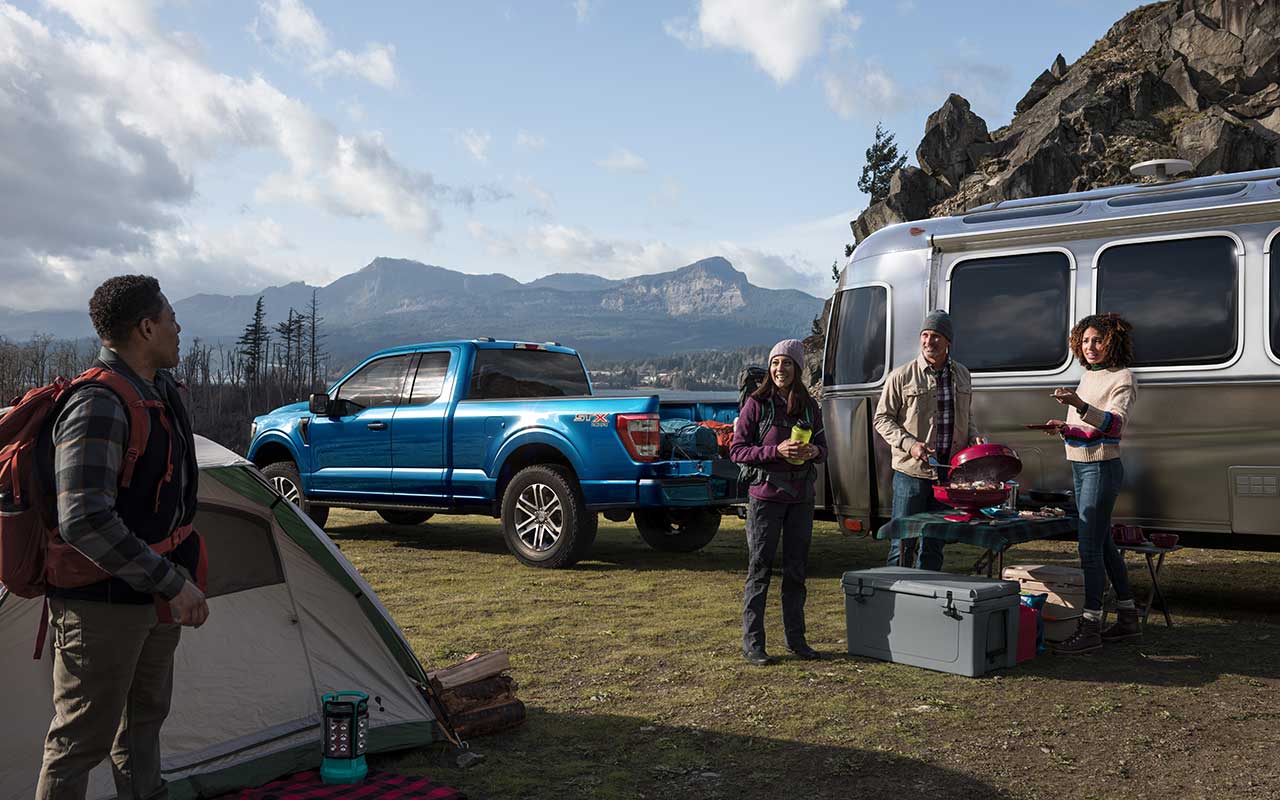
Photo courtesy Ford
Hitch Up the Easy Way With Our Travel Trailer Towing Guide
Some 56 million Americans are expected to hit the highways, byways, and backroads this summer with a recreational vehicle, according to the latest RV Industry Association (RVIA) surveys. Another 10 million RVers will join them in 2022. About 1-in-5 of those hitting the road will be hitching up and towing a travel trailer—everything from teardrops to tent trailers and travel trailers to toy haulers as individuals, families, and friends head out to enjoy all the freedom and adventure our great country offers.
For more than 110 years, automobile owners have been towing recreational vehicles so they can explore America. Towing a travel trailer is part of adventure-seekers’ DNA, and we’ve been doing it as long as automobiles have been around.
The urge to explore at one’s own pace with a travel trailer in tow was hugely popular in the 1950s and ‘60s . Today, that popularity in RVing is once again thriving as Americans look for ways to travel the nation comfortably and safely.
The safest way to travel
“More and more Americans are ready to travel this summer, and 56 million of them are planning to go RVing in an RV they rent, own, or borrow,” said Craig Kirby, President and CEO of RVIA . “Even with other forms of travel returning, the desire to use an RV to get outdoors and experience an active outdoor lifestyle is stronger than ever. RVing has been cemented as a mainstream travel option that is here to stay.”
The appeal of exploring the country while towing a travel trailer appeals to all age groups and interests, too. The popularity of RVing has even attracted media attention from the Wall Street Journal , which ran “ The Safest Way To Travel This Summer ” in a May 2020 issue.
This surge in the popularity of RVing comes to light when you try to book reservations for an RV campground space at county, state, and national parks . You can also see it on the road; the number of cars, pickups, vans, SUVs , and crossovers towing travel trailers has never been greater.
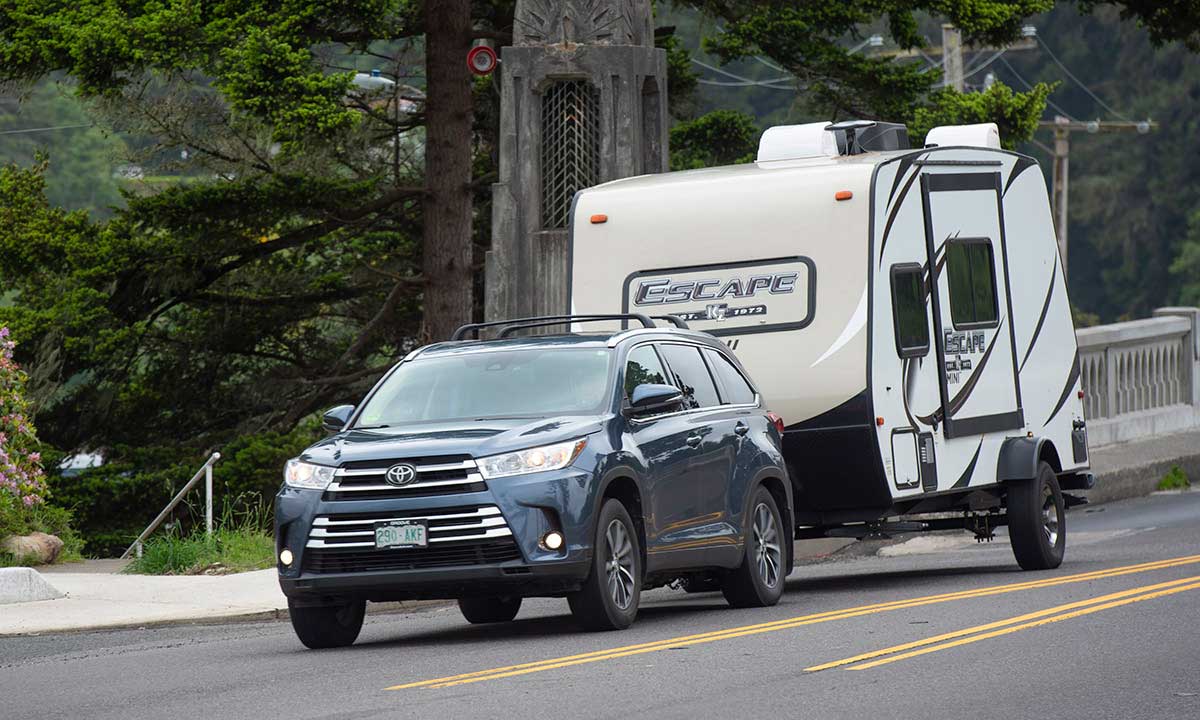
Americans hitting the road to vacation with an RV trailer in tow is at an all-time high. Make sure your travel trailer is the proper Gross Vehicle Weight Rating (GVWR) and doesn’t exceed the maximum tow rating of the vehicle towing it.
Safety concerns towing a travel trailer
From Gen Z to Boomers, RVing via a travel trailer of any type offers freedom and a sense of self-sufficiency. It’s both a practical and comfortable form of lodging. You can disconnect your tow vehicle and have a base camp to explore the area around you.
But towing a travel trailer can bring some unexpected drama and safety concerns for millions of first-time RVers. Trailers add weight to the back of the tow vehicle, and that added weight changes the handling dynamics and braking of the tow vehicle. That’s why you need to make sure your trailer and tow vehicle are properly matched.
This guide explains the basics of towing a travel trailer so your RVing experience is easier, safer, and more enjoyable.
The basics of towing a travel trailer
Towing a travel trailer consists of three components: the vehicle, the hitch, and the RV.
Within those components are variations based on the vehicle’s towing capacity, the weight of the RV , the hitch setup, and towing-related accessories to tie everything together safely.
In this towing guide, we are specifically talking about “tow-behind” or “bumper-pull” RV trailers that attach to the hitch ball on a hitch mounted under the bumper of a pickup, SUV, crossover SUV, or car, not a 5th wheel or gooseneck hitch that mounts in the bed of a pickup truck.
You can easily avoid drama and stress by properly matching the tow vehicle, hitch, and travel trailer. But get one of those wrong, and you have a recipe for disaster.
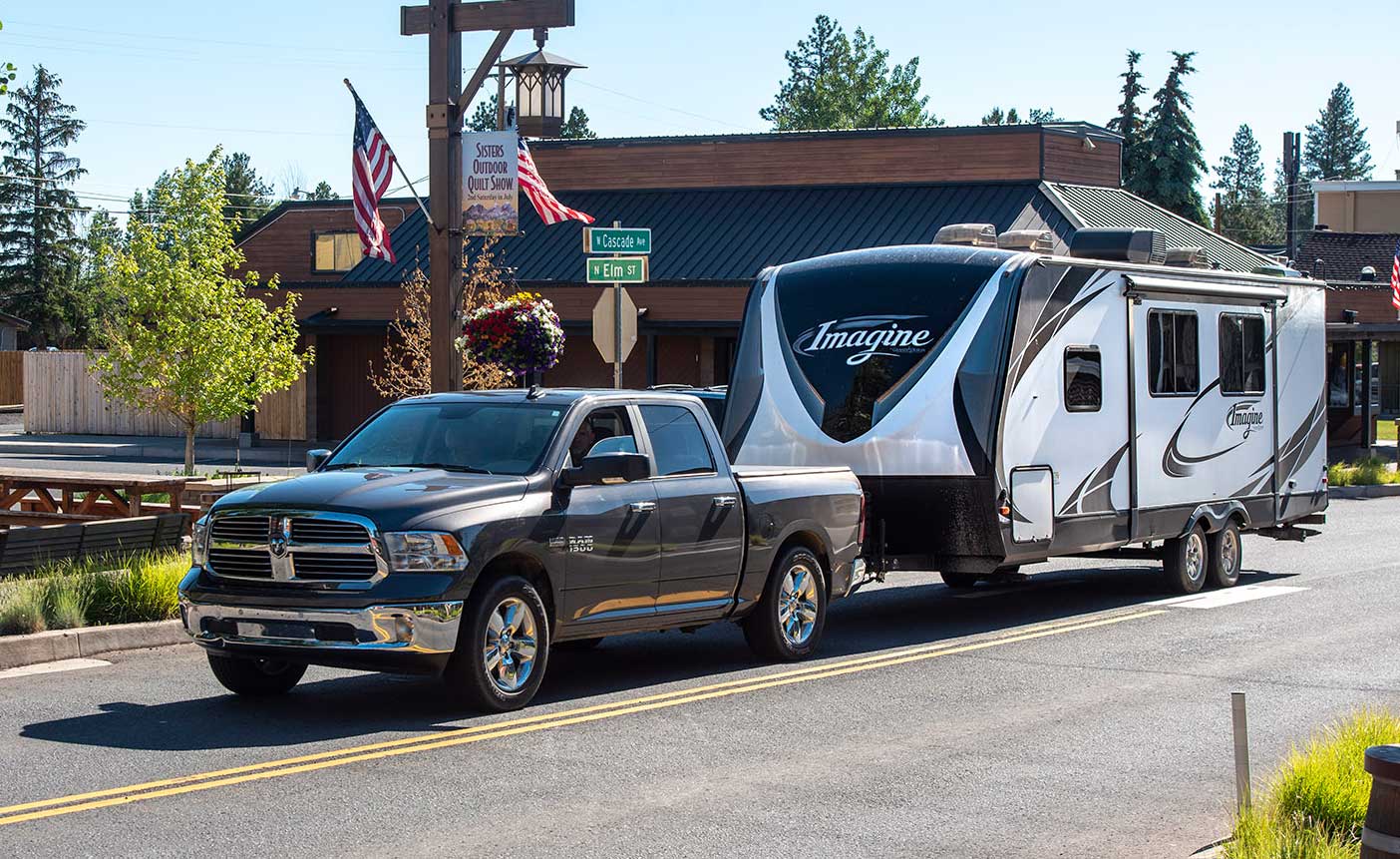
The best vehicle for towing any trailer is the one that fits both your personal needs and requirements while the trailer falls within the limitations set by the vehicle’s manufacturer.
What is the best vehicle for towing a travel trailer?
So, let’s begin with the tow vehicle. One question I get a lot from first-time RVers is, “What’s the best vehicle for towing a travel trailer?” The answer is, “It all depends.”
It all depends on what type of trailer you want to tow, whether you intend to tow with a vehicle you currently own, or maybe you have neither a tow vehicle nor a travel trailer and want to get both.
The most important aspect of towing a travel trailer is making sure the vehicle is up to the task of towing the trailer you plan on attaching to the hitch ball.
Here’s the deal when it comes to tow vehicles: The vehicle manufacturer determines how big (heavy) a trailer the vehicle can safely tow—not you. From a legal standpoint, that’s it, but I’ll explain more later in this RV trailer towing guide.
RV trailer numbers you need to know
There are two important weight-related factors when it comes to RV trailers: GVWR (Gross Vehicle Weight Rating) and tongue weight (TW).
GVWR is the safe maximum weight of the trailer when it’s loaded for camping with water, fuel, supplies, and cargo. The TW is how much downforce the loaded trailer places on the hitch.
Both numbers are displayed on the metal Federal Certification / VIN ID tag located on the front left side of a travel trailer. You can also find the specifications listed on the trailer manufacturer’s website.
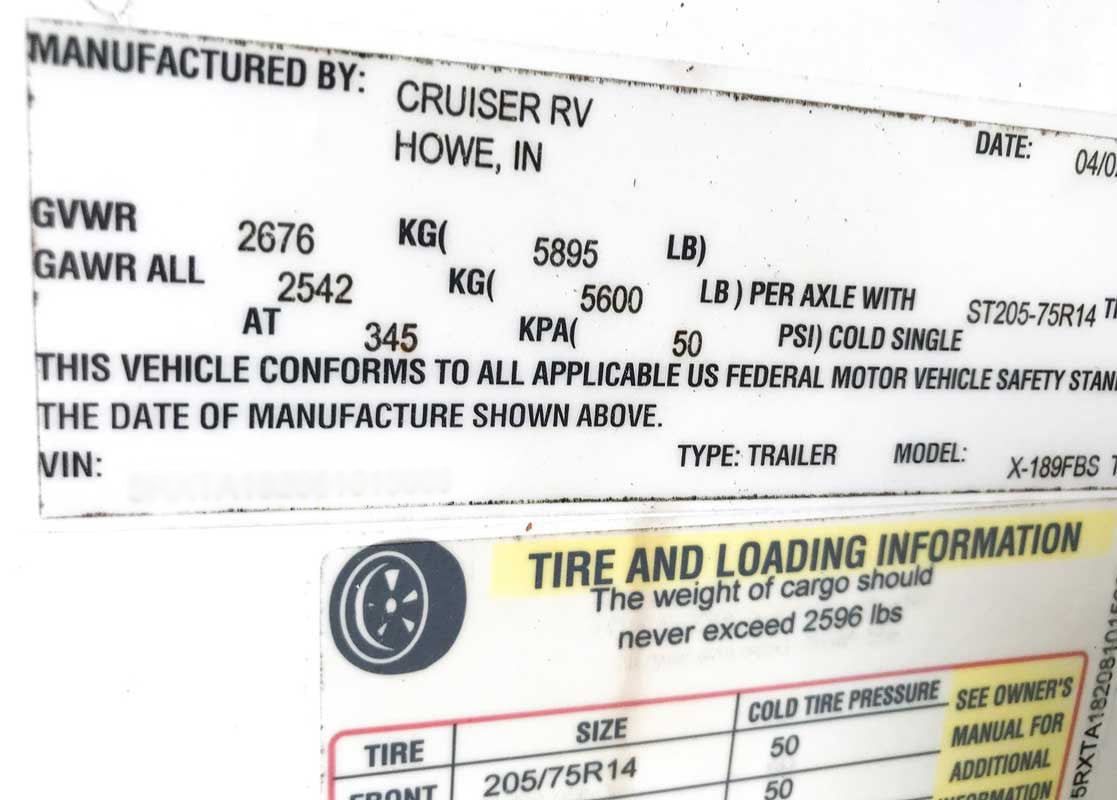
Every RV trailer has an ID/VIN decal or metal tag somewhere on the left front. It shows the trailer’s GVWR, which is the maximum it can weigh fully loaded. This is a critical number to know when matching a tow vehicle to a trailer. The trailer’s GVWR should never exceed the tow vehicle’s maximum tow rating.
Concentrate on those two weights, not the RV’s bells and whistles or nice furnishings. Those two numbers set the basis for choosing the vehicle best suited for towing a travel trailer.
Tongue weight of RV trailers, sometimes referred to as “hitch weight,” will be typically between 10- and 15-percent of the trailer’s GVWR.
For example, a 32-foot trailer like the Forest River Aurora 28BHS , weighing 7,600 pounds GVWR, has a TW of 730 pounds, while the 32-foot Grand Design Imagine 2800BH has a GVWR of 7,995 pounds and a hitch weight of only 604 pounds.
So, do your research. RV trailer weights can vary widely by brand, type, and size. That’s why it’s important to narrow down these numbers to the specific trailer you plan to tow and then make sure those weights match your vehicle’s towing limitations.
Payload calculator
A website called Keep Your Daydream Today does a great job of explaining all the weight-related towing nuances, and the site has a nice payload calculator that can be downloaded to figure out what you can safely tow per the vehicle manufacturer’s listed tow ratings.
How big of an RV trailer can my vehicle tow?
Now that you know the trailer’s GVWR and TW, it’s time to focus on the tow vehicle. Towing a travel trailer from your home to a campground begins with dropping the trailer tongue on a hitch ball. But the most critical aspect of safely getting from Point A to Point B is having the right vehicle for towing.
Your tow vehicle needs to have the power to pull the trailer up hills and maintain reasonable speeds over the open road. More importantly, the tow vehicle has to be properly equipped for towing, per the vehicle manufacturer’s guidelines, and have the factory tow rating capacity to handle the load it’s towing.
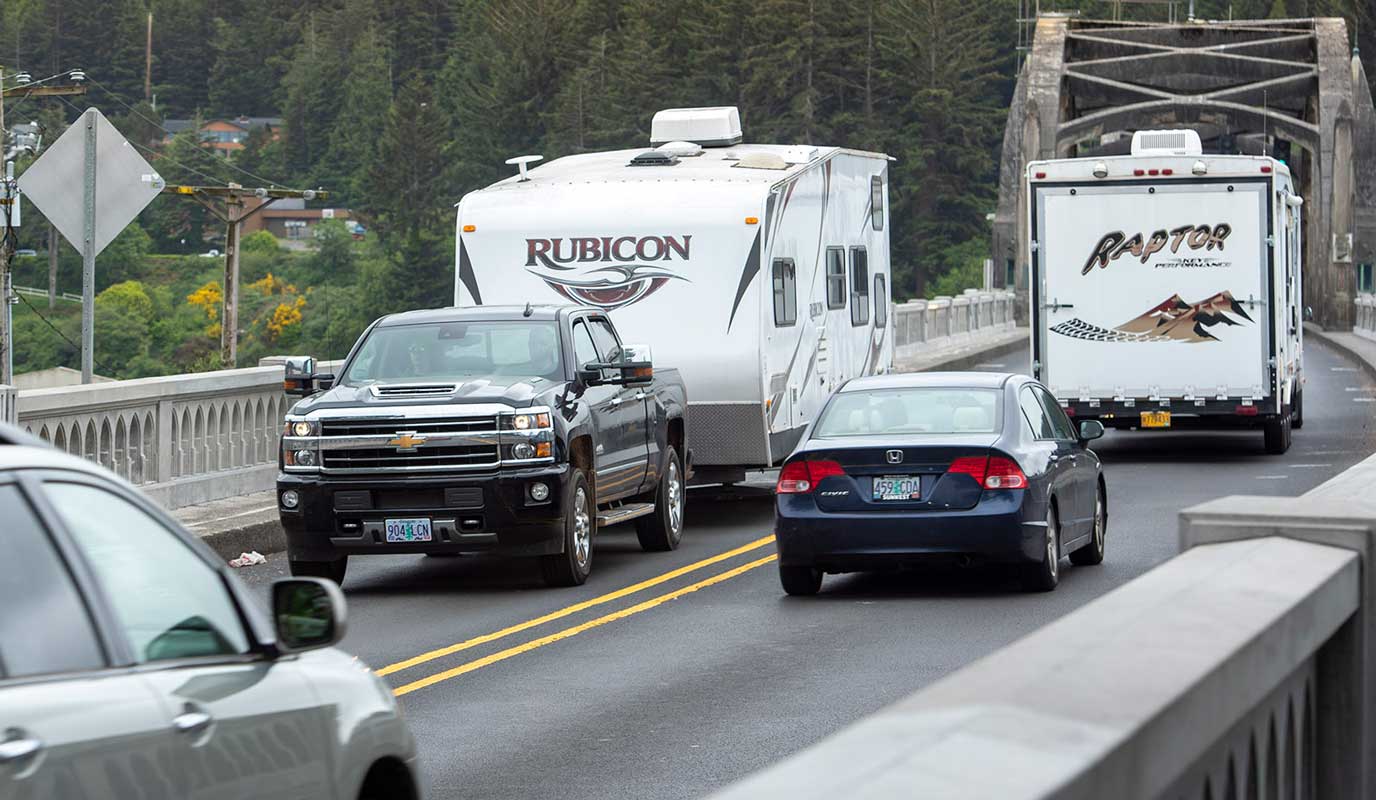
Having the right tow vehicle for the trailer takes all the drama out of the RVing experience and maximizes the safety factor for others on the road.
The only one who can set the limit on how much weight any vehicle can tow is the vehicle manufacturer.
To find your tow vehicle’s maximum trailer towing capacity, and what it needs to be properly equipped per the vehicle manufacturer’s specifications, dive into the towing/trailering section of the owner’s manual. There you’ll find the bare-bones information.
RV tow rating information
But what you really want is the detailed tow rating information. For that, you’ll have to dig deeper. The information is usually on the vehicle manufacturer’s fleet/commercial website under a heading like “RV & Trailer Towing Guide.”
When matching a trailer to a tow vehicle, a good rule-of-thumb is to keep the trailer’s GVWR at less than 75 percent of the tow vehicle’s trailer towing capacity.
So, if the tow vehicle is rated for a maximum of 6,000 pounds, the chosen trailer should have a GVWR of 4,500 pounds or less. Likewise, if the tow vehicle is rated to tow 10,000 pounds, a good trailer weight is 7,500 pounds or less.
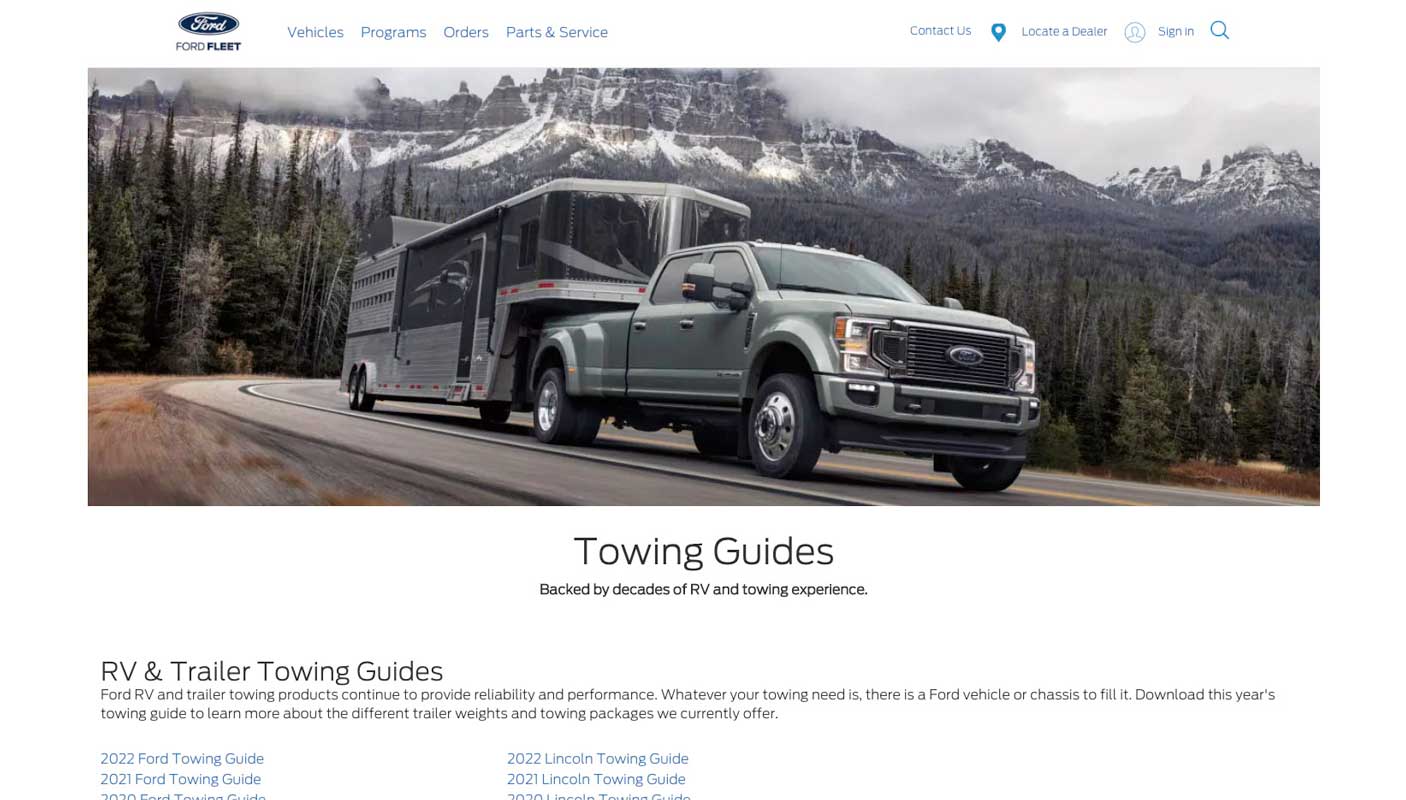
You can find detailed trailer towing information on the vehicle manufacturer’s fleet/commercial website under a heading like “RV and Trailer Towing Guide,” “Towing Guides,” or “Trailering Guide.”
Where to find pickup truck manufacturer trailer towing ratings
To make tracking down trailer tow ratings of the Big Three pickup manufacturers easy, here are those website links:
- Chevrolet: www.gmfleet.com/Guides
- Ford: www.fleet.ford.com/towing-guides
- GMC: www.gmfleet.com/GMC Trailering Guide
- Ram Truck: www.fcausfleet.com/ramtrucks/towing-guide
It’s easy to find the trailer towing limits for cars, SUVs, and crossover SUVs. Pickups are a whole different story.
Pickup truck ratings for towing a travel trailer vary by year, make, model, cab configuration, transmission, and axle ratio. They can also vary related to the type of hitch setup, whether “conventional weight-carrying” (towing-on-the-ball) or using a weight-distributing hitch system. So read the numbers and annotated information carefully.
Vehicle’s trailer tow ratings can’t be changed
As you review trailer tow ratings, you’ll see that just because a vehicle has a hitch doesn’t mean it can tow whatever is attached to the hitch ball. Every vehicle that rolls off the assembly line has a towing limitation, just as it has a unique VIN.
Once a vehicle leaves the manufacturing assembly line, its tow ratings and cargo-carrying capacities are set in stone—just like the VIN. Those ratings could have higher/lower capacities, depending on the engine and transmission package, axle ratio, and other options available on that particular model vehicle. This is especially true of pickup trucks.
Even though installing aftermarket products like air bags and anti-sway bars can improve the ride and handling when towing a travel trailer, such modifications do not change that particular tow vehicle’s limitations as set by its manufacturer.
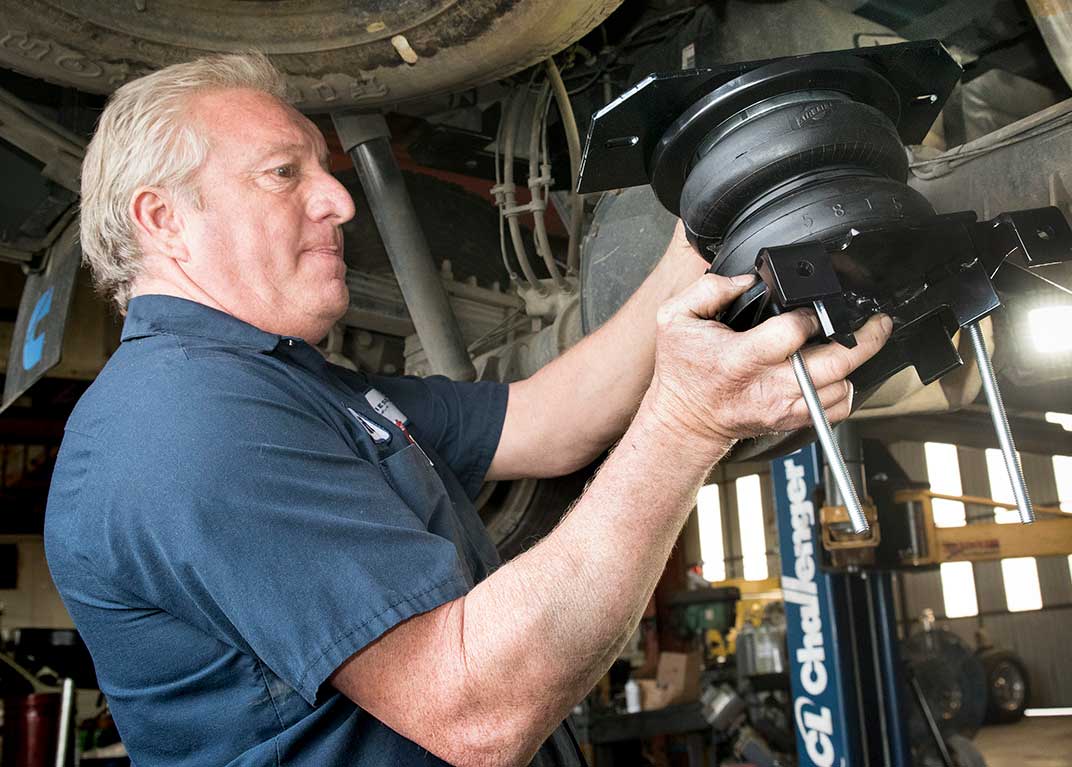
Installing overload springs, anti-sway bars, air helper springs, a heavier-duty hitch, or making other vehicle suspension, drivetrain, or engine modifications does NOT change the vehicle’s tow rating or load capacity. Those ratings are set by the vehicle manufacturer when the vehicle is built.
Why are vehicle manufacturer trailer towing ratings important?
Why is it important to know the trailer towing limits of your vehicle? Safety. Warranty. Liability.
Vehicle manufacturers set vehicle tow ratings and load capacities with safety, warranty, and liability at the forefront. They do so using special test procedures specified under SAE J2807 , which is a strict vehicle manufacturing safety standard focused on keeping the driver and occupants reasonably safe when towing trailers.
At the same time, SAE J2807 testing protocols allow the vehicle manufacturer to set a comfortable weight limit for the vehicle to function reliably through the warranty period when used for such towing and cargo-carrying tasks.
Among the battery of tests within SAE J2807 are emergency accident-avoidance and vehicle control tests with a loaded trailer in tow. If the vehicle being tested doesn’t pass these tests in a manner deemed safe by the vehicle engineering team, then the trailered weight is reduced and the vehicle re-tested until it meets the safety standards. When it meets the safe standard, that’s the maximum trailer towing capacity for that particular vehicle.
Towing a travel trailer that’s heavier than the vehicle is rated for towing, or not having the tow vehicle properly equipped, can put the burden of liability on you if you’re in an accident. Your insurance company could very well deny coverage because under the law, you, the driver, are considered negligent .
Trailer tow ratings can be confusing. But they are very important from a safety and vehicle handling standpoint.
Real-world lessons in trailer weight ratings
A neighbor recently joined the millions of Americans towing a travel trailer on his family’s first RV adventure. He hitched a beautiful Forest River 2021 rPod 190 travel trailer to the hitch of his 2017 Lexus RX 350 AWD. His first weekend on the road towing the trailer “scared him to death” because of trailer sway. He couldn’t understand why his Lexus handled so poorly when it was “rated” to tow 3,500 pounds—according to the trailer salesperson—and the trailer only weighed 2,900 pounds.
We looked at the numbers. He had two issues. First, the “dry weight” of the rPod was 2,900 pounds, but the GVWR was 3,800 pounds. Second, his Lexus was rated to tow 3,500 pounds only if equipped with “a sway control device with sufficient capacity” per the owner’s manual. Otherwise, the trailer towing capacity was limited to 2,000 pounds.
So, he installed a Blue Ox SwayPro 350 weight distribution hitch and made sure the trailer’s GVWR didn’t exceed 3,500 pounds.
He and his wife have spent anywhere from 3 to 5 days traveling around the Pacific Northwest at least twice a month, loving the RV life! For now, the Lexus and rPod are a happy match for their lifestyle.

Even though a salesperson says the vehicle you are buying is “perfectly capable” of towing such-and-such trailer, have the trailer’s GVWR number memorized, and then have the salesperson show you the maximum towing specs for the specific vehicle. In pickups, the difference in axle ratios alone can make a 2,000-pound or greater difference in a tow rating. In smaller vehicles, the same can be true for different engines.
Don’t rely on salespeople for accurate towing info
Another friend bought a 2021 Ram 1500 Laramie 4×4 Quad Cab and an equally nice 26-foot Backcountry Mountain TRX trailer so the family of four could enjoy the outdoor lifestyle during summer and fall. The salesperson at the Ram dealer said the Hemi-powered 4×4 could tow as much as 12,750 pounds, so no problem towing the 9,995-pound Outdoors RV camper.
But what he found out later when looking up the maximum trailer tow ratings in the Ram towing guide was that his particular pickup, with the standard 3.21 axle ratio, was limited to just 8,330 pounds. Fortunately, he persuaded the dealer to swap his new pickup for an identical one that was equipped with the “premium” 3.92 axle ratio, which was rated to tow 11,430 pounds—a much better match to the trailer and much safer for his family.
To that end, you must go back to the basics of weight when it comes to how much your vehicle can tow. You need to know the GVWR of the trailer and the maximum trailer capacity of your specific tow vehicle.
If the trailer’s GVWR is more than the trailer tow rating of your tow vehicle, find a lighter trailer or a tow vehicle with a higher trailer towing capacity.
A good rule-of-thumb in choosing a trailer is its GVWR be no more than two-thirds the max trailer tow rating of the vehicle. This gives you a margin of error on the safe side. Your tow vehicle must also be properly equipped as specified by its manufacturer.
What is the best 4X4 for off-grid RVing?
So what’s the best 4×4 vehicle for towing trailers when camping off the grid and exploring roads less traveled? Most people think the obvious answer is one of the many Jeep models, such as the iconic Wrangler Unlimited Rubicon or Grand Cherokee. They’re partially correct.
Jeep Models
Setting fuel economy and price aside, the Jeep Rubicon 392 is king, setting the highest bar among the Jeep line when it comes to overall backcountry and off-road performance. Its V8 power, technology, and agility are amazing.
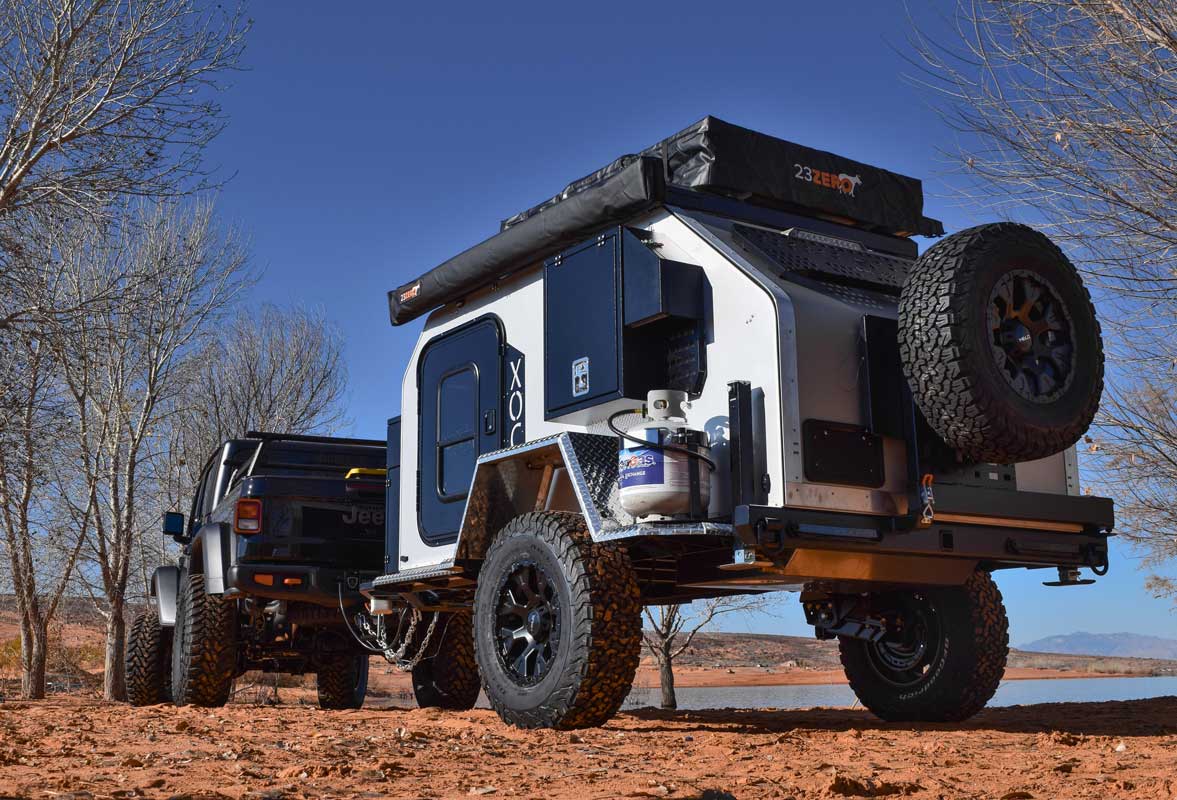
Jeeps are the icon for off-pavement/off-road travel. But the soft, pliant suspension takes away some of their towing ability, limiting most models to towing trailers less than 3,500 pounds. Off-road trailer manufacturers such as Vorsheer, which makes the 2,600-pound (GVWR) XOC, build their trailers to accommodate these tow ratings. Photo courtesy Vorsheer Mfg
But the Jeep Wrangler’s soft, pliant suspension, across all models, is also its downfall when it comes to tow ratings. They are among the lowest in this class of SUV, with a maximum towing capacity of just 3,500 pounds for the 6.4L V8-powered Rubicon 392 to as little as 2,000 pounds for the base model two-door Wrangler Sport with the 3.6L V6.

Jeep’s Grand Cherokee is an excellent tow vehicle for those who do a lot of highway RVing and backcountry travel with “light off-roading.” Some models can tow up to 7,650 pounds.
The Jeep Grand Cherokee has higher tow ratings ranging from 4,000 to 7,200 pounds (Hemi V8-powered SRT). But the Jeep Gladiator pickup is the best choice with a trailer towing capacity of up to 7,650 pounds, depending, of course, on the model and axle ratio.
Ford Bronco
A new contender when it comes to the best 4×4 for RVing off-grid is the latest iteration of the iconic Ford Bronco . Ford’s new SUV leads the pack for four-wheeling in overall performance, with excellent fuel economy, suspension travel, and traction capabilities.
Broncos equipped with the 2.7L EcoBoost V6 and 10-speed automatic combo are ideal for towing. The trade-off for the Ford Bronco’s off-road prowess is a limited trailering capacity of up to 3,500 pounds when equipped with the optional Class II Trailer Tow Package.
If money isn’t an option and you want the very best 4×4 for off-grid travel and towing RV trailers, the 702hp Ram 1500 TRX , with a tow rating of 8,100 pounds, wins. Hands-down. It’s won both Four Wheeler and MotorTrend magazine’s Truck of the Year and several other prestigious automotive pickup awards this year.
Hitch types and hitch capacities
The term “properly equipped” means the vehicle has the factory towing package, which can vary from vehicle to vehicle and from manufacturer to manufacturer. But it always includes a factory-installed receiver hitch and wiring to connect between the tow vehicle and the trailer.
Properly equipped also means using the proper hitch type for the weight of the trailer. There are two hitch types for towing a trailer using a receiver-type hitch: weight carrying and weight distributing.
Attaching the trailer to the hitch ball bolted on the shank that comes out of the hitch is called “weight carrying” because the full load of the trailer’s tongue weight is carried by the hitch assembly.
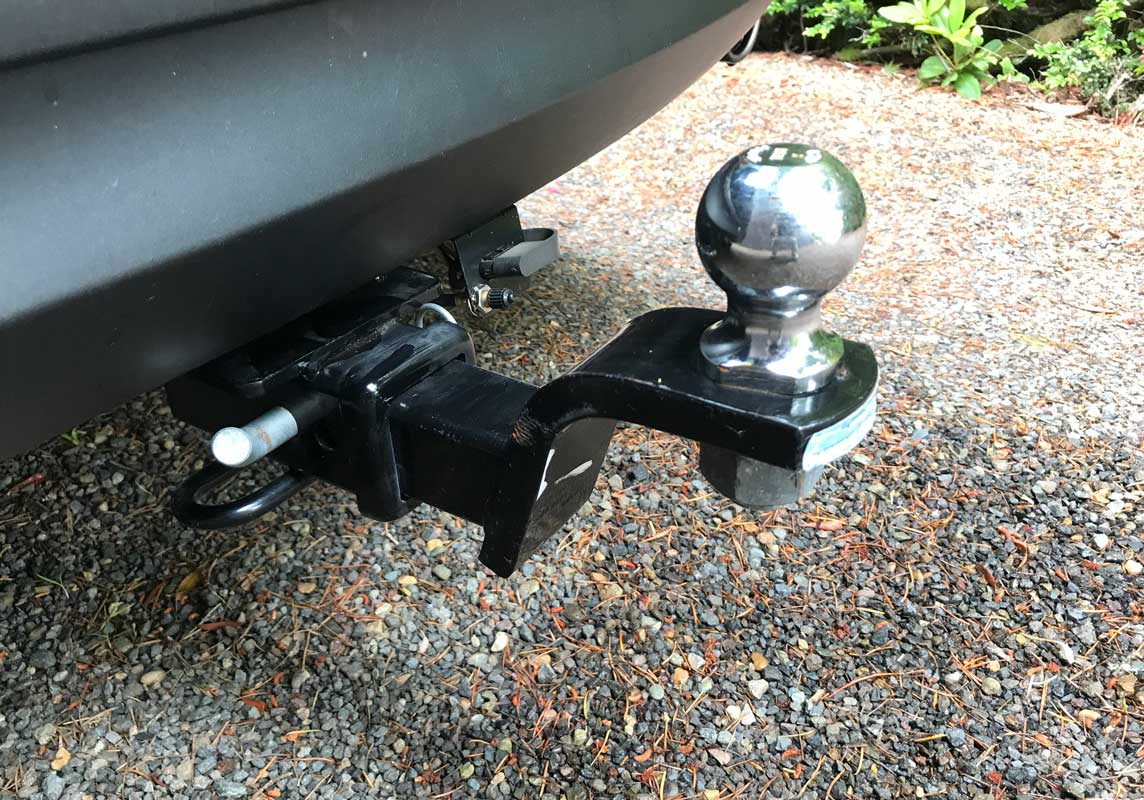
This is a typical “weight-carrying” hitch setup that comes from the factory. It accommodates a “shank” with a trailer ball mount. The load capacity of a hitch can be found on the hitch manual’s decal—the same with the shank. The hitch ball capacity is imprinted on the top of the ball.
The towing capacity of the hitch is determined by the hitch manufacturer, and the maximum load/towing capacities are listed on the hitch, the hitch shank, and on top of the hitch ball. Hitches come in five classifications depending on the size of the opening for the receiver (shank) and load capacity.
The typical factory hitch on cars, crossovers, smaller SUVs is Class I or II.
Midsize pickups, SUVs, and vans generally come with a Class III hitch.
Full-size pickups usually have a Class IV hitch, while some 1-ton diesels use a Class V hitch.
Hitch classes and Gross Trailer Weight
NOTE: Changing the size of the hitch to one with a higher capacity DOES NOT change your vehicle’s tow rating.
Understanding hitch balls and capacity
The most important connection point between the tow vehicle and the trailer is the shiny round thing sticking up from under the bumper—the hitch ball. You’ll have a big problem if the ball isn’t the correct size to fit the trailer coupler, or the ball isn’t installed on the shank (mount) with the correct amount of torque on the nut.
Standard RV trailer hitch balls come in three different diameters: 1-7/8″, 2”, and 2-5/16″, while shank sizes varying from ¾” to 3″ depending on the hitch capacity. The smaller 1-7/8″ hitch balls have a towing capacity of up to 3,500 pounds and are typically found on cars, smaller SUVs, minivans, and crossovers.
Hitches equipped with 2″ tow balls are rated for 8,000 pounds and are typical of that used on smaller travel trailers and overlanding/adventure-style off-road trailers. The larger 2-5/16″ hitch balls are rated from 12,500 pounds to 21,000 pounds and are common on RV trailers that weigh more than 8,000 pounds.
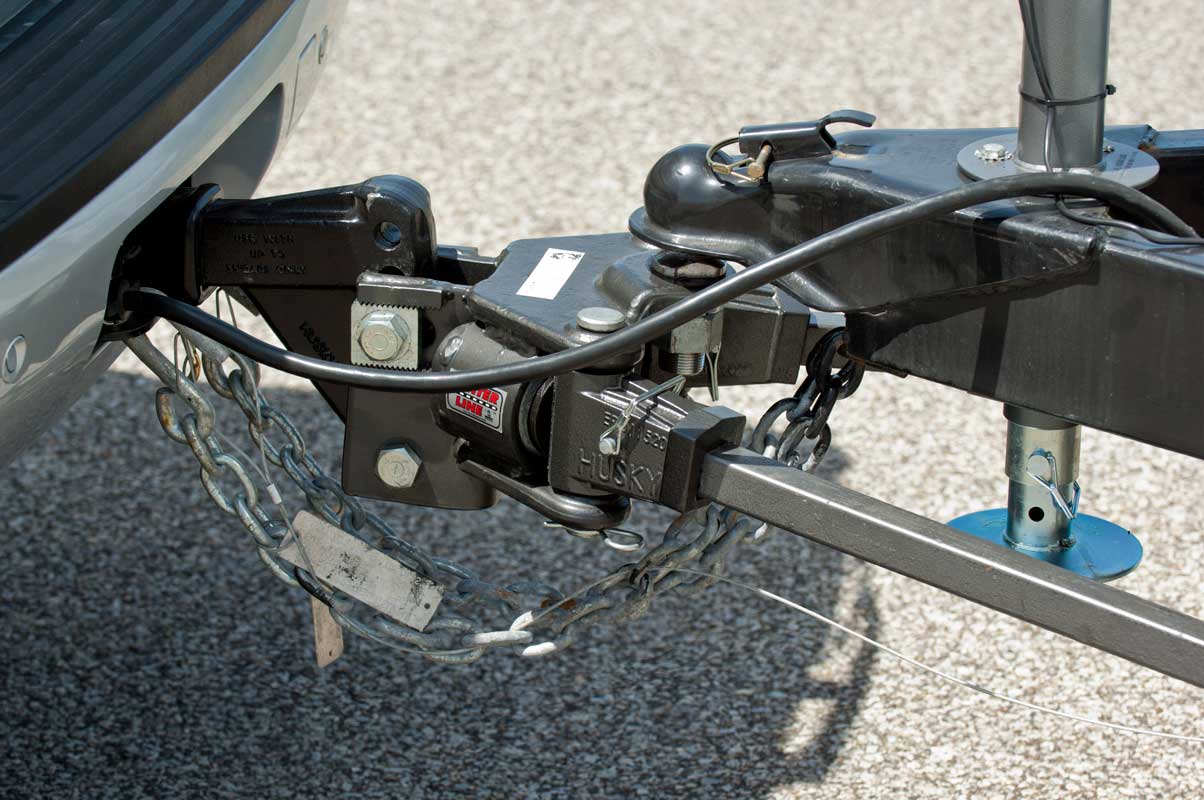
A typical weight-distribution (WD) hitch has two “spring bars” that extend from the hitch head to the trailer. The bars act like wheelbarrow handles, so some of the weight of the trailer on the hitch can be shifted fore and aft to better balance the tow vehicle/trailer combo. A WD hitch also greatly reduces trailer sway.
How do weight distribution hitches work?
A weight distributing hitch , or weight distribution hitch, uses a special head with provisions for attaching one or two long arms that attach to the trailer frame that can be adjusted to transfer some of that tongue weight fore and aft so the tow vehicle is better balanced.
The typical WD hitch also incorporates an anti-sway device or design for better trailer control.
“The weight distribution feature will transfer some of the weight to the front axle, as well as some being transferred back to the trailer’s axle(s)” explains Josh Jones, a customer service rep at Progress Manufacturing , makers of the Equl-i-zer Hitch and Fastway trailer towing components. “Basically, 1/3 of the tongue weight is transferred from your tow vehicle back to the trailer, and the remaining 2/3 is evenly distributed on the front and rear axles of your truck. This gives all four tires equal contact with the road, improving steering and braking, and the hitch’s built-in sway control eliminates sway before it starts so you have a smoother, more enjoyable towing experience.”
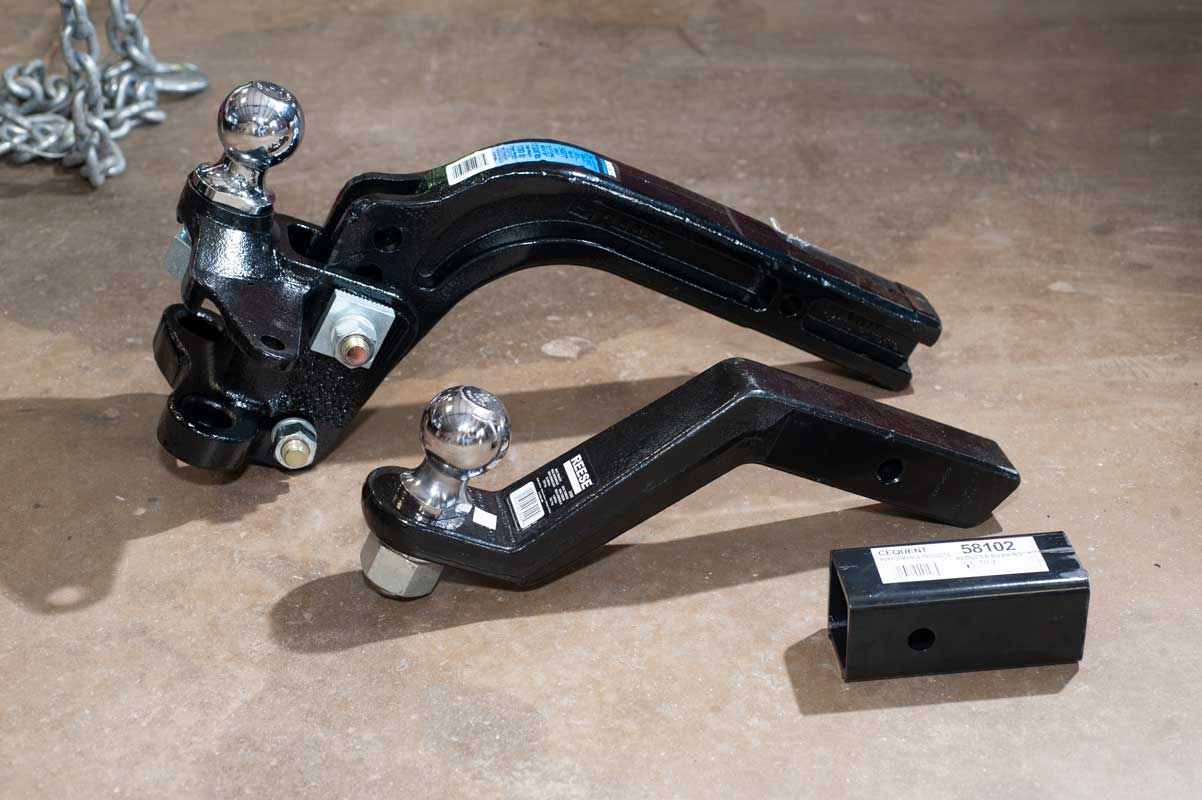
Both weight-distributing (top) and standard hitches have maximum trailer towing ratings. Using a reducer sleeve (bottom) to step down from 2.5” or 3” hitch receivers to 2” also reduces trailer towing capacity.
That’s why the “weigh-carrying” tow capacities of a vehicle, especially full-size pickups, vans, and SUVs, are usually considerably less than a “weight-distributing” setup because more weight is put on the rear axle when one is just towing on the ball.
These dual-capacity tow ratings really apply to pre-2018 and older heavy-duty pickups with some max trailer towing limits of 5,000 pounds towing-on-the ball unless a weight-distributing hitch is used. Also, using the 2″ adapter sleeve in newer pickups’ 2.5″ receiver hitches significantly reduces both the weight-carrying tow limit and maximum tongue weight.
The Best 2022 Pickups For Towing Trailers With GVWR Under 5,000 Pounds
Brake requirements for rv travel trailers.
Attaching a trailer to your tow vehicle places an additional load on its braking system. That means the heavier the trailer, the less responsive the brakes and the longer it takes to stop the vehicle. That’s why most state motor vehicle laws require trailers over a certain gross weight must have their own trailer braking system .
Some state trailer laws require a braking system on trailers with a GVW of 1,500, some 3,000 pounds, and some 6,000 pounds GVW. Other states require the tow vehicle/trailer combo must stop within a certain distance from a designated speed, or the tow vehicle be able to hold the trailer while stopped on a “hill of any grade under all conditions.”
Thankfully the RV trailer manufacturers make the braking aspect of towing a travel trailer easy by equipping their trailers, even the lighter off-road/overlanding camp trailers, with electric brakes on trailers that weigh more than 1,500 pounds. This way, the trailer can be sold in any state and meet the legal brake requirements.
As for trailer brakes, the typical RV trailer has electric-actuated brakes along with a “breakaway” system in the event the trailer decides to go for a little side trip on its own. (Breakaway systems are required on trailers with a GVW greater than 3,000 pounds.)
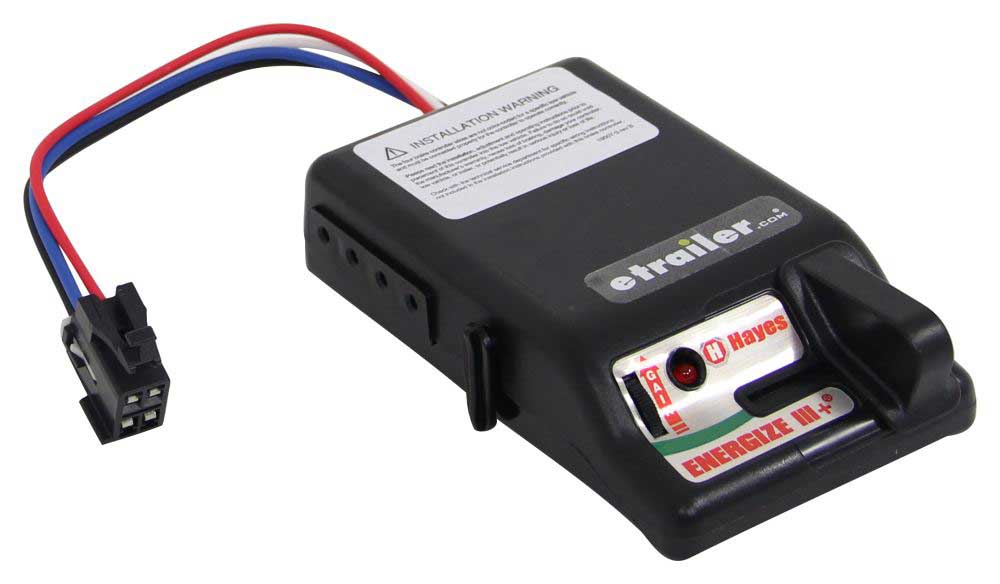
Aftermarket electric brake controllers send electronic signals to the trailer brakes when the driver hits the tow vehicle’s brake pedal. There are lots of types of controllers, and most allow the driver to manually apply the trailer brakes via a dash-mounted controller if needed. Photo courtesy eTrailer.com
How do RV trailer brakes work?
Electric-actuated RV trailer brakes on bumper-pull can be either drum or disc, much like those that stop your tow vehicle. The braking is applied when an electrical signal is transmitted from the brake pedal to a separate device in the vehicle called a brake controller , which then signals and activates the trailer’s brakes.
In an electric drum brake system, the braking signal goes to an electromagnetic actuator inside the brake drum that pushes the brake linings into the drum. On an electric-over-hydraulic disc braking system, the signal from the controller activates a hydraulic pump that pushes fluid in the brake lines to the calipers that engage the brake rotor.
Some of the newest pickups and SUVs have built-in brake controllers, while older pickups and most cars, crossovers, and SUVs will need an aftermarket brake controller unit installed. Either way, it’ll be up to you to make the proper brake controller adjustments per that particular brake controller’s instructions.
Both braking systems require the proper trailer plug, the correct trailer wiring setup in the tow vehicle, and a charged battery in the trailer to operate safely. Part of most vehicle manufacturers’ “Towing Package” includes such wiring and plug for the trailer wiring harness.
Typical travel trailer weights
When you shop for RV travel trailers, you’ll see a wide range in gross vehicle weight ratings (GVWR), even in the tiny trailers and off-road trailers. For instance, the typical teardrop trailer comes in between 1,500 and 2,500 pounds, with the more robust overlanding off-road trailers coming in with a GVWR between 2,500 to 4,500 pounds. Pop-up tent and hard-sided campers generally have GVWRs between 2,000–4,000 pounds.
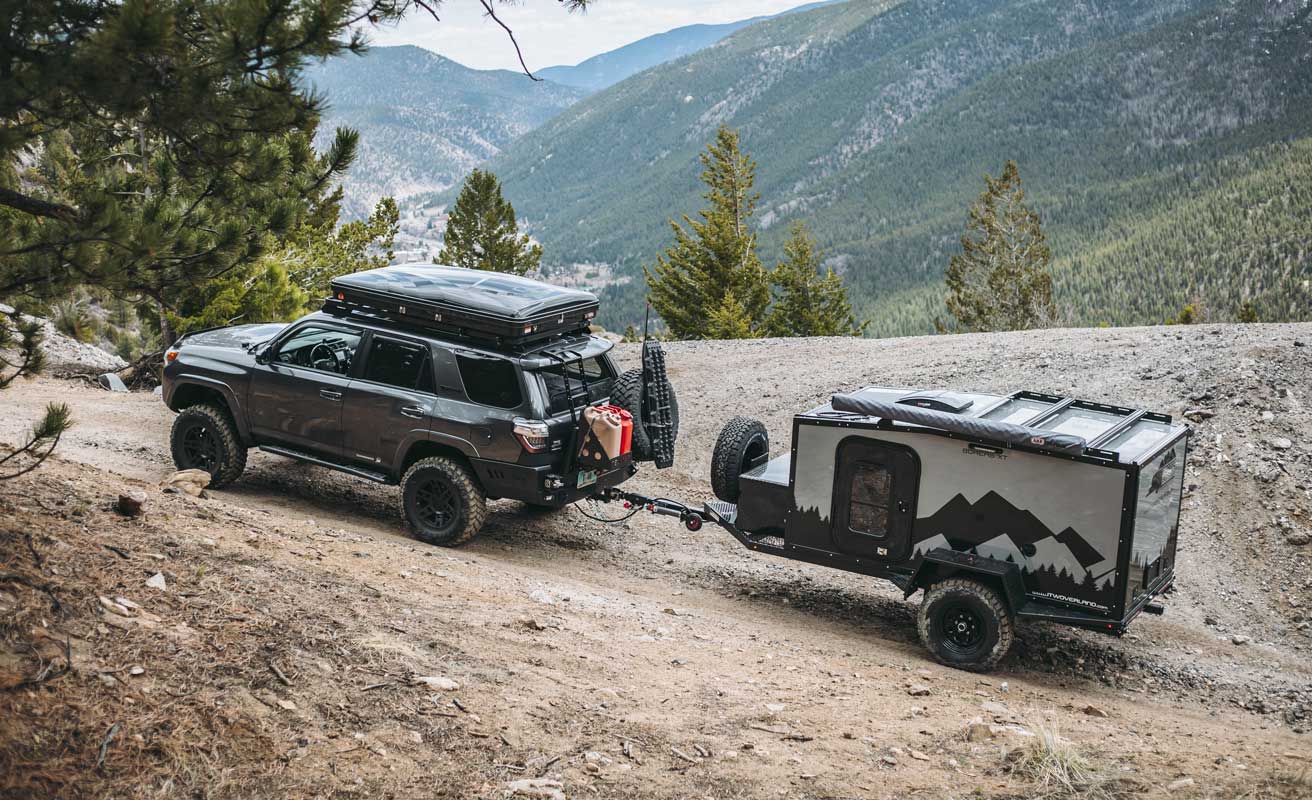
RV trailers are available to fit just about any lifestyle. They also vary in weight, so it’s easy to find the perfect travel trailer to fit your tow vehicle. Some adventuresome RVers—of an estimated 10 million taking vacations with a trailer in tow—will be doing so on roads less traveled. Photo courtesy Boreas Campers
More traditional bumper-pull RV trailers have an average GVWR range related to their length, design (camper or toy hauler), and number of slideouts. Midsize RV trailers in the 23- to 28-foot range have a maximum loaded weight between 6,000 and 8,000 pounds.
Start shopping around for the 30-foot-plus bumper-pull trailers and the GVWRs can top 10,000 pounds, which is nearing the upper limit for most full-size pickups and SUVs towing with a weight-distributing hitch.
Popular trailers for towing and average weights
While there are hundreds of travel trailer brand and specification combinations we could list, we’ll focus on some well-known RVs to give you a sense of what to look for when shopping for a trailer to tow:
Where do electric pickups fit in with towing RV trailers?
Electric vehicles, aka EVs, are slowly making their way into the automotive market but still only make up less than 2 percent of the new car market in the U.S., according to Pew Research and other market watchers.
EVs, whether car, SUV, crossover, or pickup, are excellent modes of transportation for city and urban settings. Not so much so in rural America, where the availability of designated plug-in sites is few and far between. EV vehicles also cost a lot more than their gas and diesel counterparts. If the current federal tax incentives or EV tax credits are phased out, that price disparity will be even greater.
Then there’s the cost of EV ownership over the life of the vehicle to consider, along with trade-in value. After all, all batteries wear out, and the packs in EVs are no different.
What will it cost to replace an EV’s battery pack in 100,000 miles or 10 years? It’s not going to be cheap. A Greencars.com article claims that cost could be as high as $15,000, not including labor.
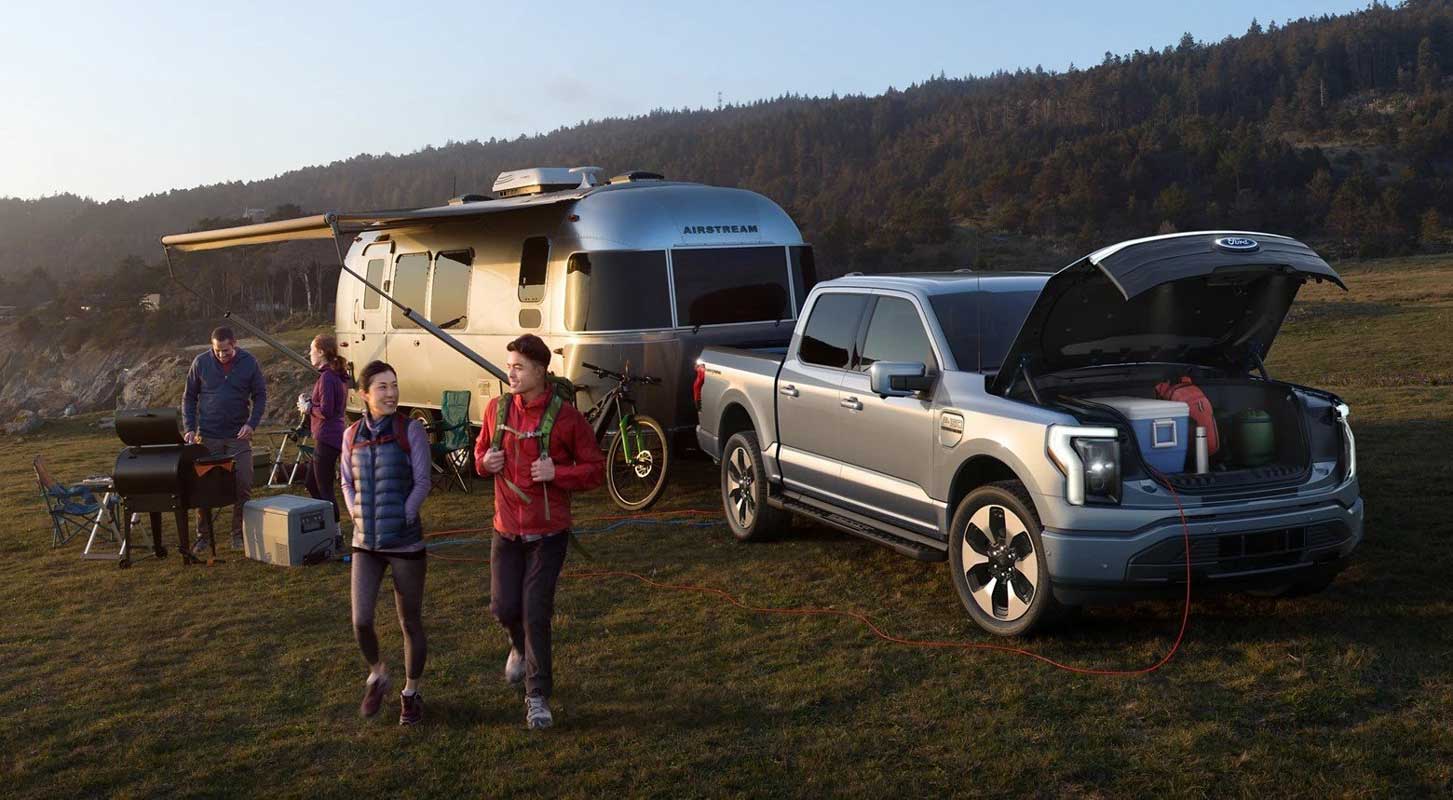
All-electric (EV) pickups are emerging from different vehicle manufacturers as battery technology advances. One of the great things about EV pickups and SUVs is the engine compartment becomes a big trunk! Photo courtesy Ford
RV trailer towing range for EV pickups
Trailer towing brings up another matter: driving range. EV pickup’s capability in distance between charges is cut by 1/3 to ½ when towing a travel trailer. So instead of being able to drive 250–300 miles unloaded, you’ll need to look for a place to plug in every 3 to 4 hours. That’s not convenient and not what most RVers want in a tow vehicle.
Ford’s 2022 F-150 Lightning , with a towing capacity of 10,000 pounds, sports EPA range numbers of 230 miles for the “standard” battery pack and 300 miles with the optional “extended range” pack. The trailering range is probably going to be around 150–200 miles depending on the battery pack.
The F-150 EV battery packs require 10 to 13 hours to fully recharge with the Ford Charge Station Pro , which plugs into either 120V or 240V outlets. We’ll probably see EV charges common as their evolution continues.
Sure, the EV F-150 can be turned into a backup power station, but that power comes from the battery pack, good for off-grid camping but shortening the driving range even more. So, if you’re keen on going green by towing your travel trailer with an EV, keep the driving range in mind.

EV pickups are hitting the road, and RVers are taking note. The 2022 Ford Lightning EV has a trailer towing capacity of 10,000 pounds and a range estimated at 150–200 miles between charges when towing, depending on the battery pack option. Photo courtesy Ford
Tow ratings for EV pickups & SUVs
*Unloaded **GM has not released final numbers
Now that you know how to match a tow vehicle to a travel trailer and set it up safely, you’re ready to tow like a pro. It’s time to head out on the road, have fun, and make wonderful memories. That’s what the RV life is all about!
Make your next RV trip even easier and more enjoyable with an RV-safe GPS . With it, you can get directions custom tailored to the height and weight of your tow vehicle and travel trailer. The turn-by-turn navigation, including voice- and lane-guidance, works even when you’re offline. No more worrying about steep mountain passes, low clearances, bridge weight limits, or propane-restricted tunnels.
Continue reading:
- 7 Things You Need To Know For Safe RV Towing
- What Is Your Gross Vehicle Weight (And Why Does It Matter)?
- 4 Trailer Safety Tips That Could Save Your Life
You May Also Like:
Know how to prevent a space heater fire in your rv, safety devices that every rv owner should have, watch out for these fire hazards in your rv, dust storm safety: what to do if you’re camping or driving, how to detect a dangerous rv propane leak, tips for getting on the runaway ramp in an rv, 6 things you need to know about camping in a storm, avoid these 10 dangerous routes in your big rig, the dangers of driving on wet fall leaves.

RV and automotive journalist Bruce W. Smith has held numerous editorial titles at automotive and boating magazines, and authored more than 1,000 articles, from tech to trailering. He considers his home state of Oregon a paradise for RVing and outdoor adventure.
16 thoughts on “ Everything You Need To Know About Towing A Travel Trailer ”
Hello Bruce, . You stated “So, if the tow vehicle is rated for a maximum of 6,000 pounds, the chosen trailer should have a GVWR of 4,500 pounds or less. Likewise, if the tow vehicle is rated to tow 10,000 pounds, a good trailer weight is 7,500 pounds or less.”
Then you went on and stated ” But the Jeep Gladiator pickup is the best choice with a trailer towing capacity of up to 7,650 pounds, depending, of course, on the model and axle ratio.” I checked the Gladiator and it have Towing capacity (lbs.) 4,000. I don’t see how you can tow a trailer 7,000 pounds with the Gladiator. .
The Jeep Gladiator’s tow rating is up to 7,650 pounds, but you need to select the right configuration (engine, transmission, optional packages). You probably looked at the base version.
Of course you can’t actually tow a 7,650 pound trailer with a Gladiator having a 7,650 pound trailer weight rating unless you have no passengers or cargo in the truck, but that’s a major issue that the article’s author completely missed.
To get the maximum tow rating on a Gladiator, you add the “max tow package” which includes (along with some unnecessary stuff): 245/75R17 All-Terrain Tires 4.10 Axle Ratio Heavy-Duty 4-Wheel Disc Anti-Lock Brakes Heavy-Duty Dana® 44 Wide Front Axle Heavy-Duty Dana® 44 Wide Rear Axle GVW Rating – 6,250 Pounds 240-Amp Alternator Class IV Receiver Hitch Heavy-Duty Engine Cooling
Half of the trailer weight class information is wrong. The limit for Class 3 (or Class III) as defined by both VESC-5 and SAE J684 is 5,000, not 6,500 pounds. The range for Class 4 (or Class IV) is 5,000 to 10,000 pounds, not 10,000 to 12,000 pounds. There is no Class 5 (or Class V) in these standards, although towing equipment companies pretend that there is.
The standards do not define tongue weight limits; there are limits for specific hitch equipment, and the table gives somewhat typical values.
The author correctly notes (apparently copying from somewhere) that “GVWR is the safe maximum weight of the trailer when it’s loaded for camping with water, fuel, supplies, and cargo.” Then this stupidity follows: “When matching a trailer to a tow vehicle, a good rule-of-thumb is to keep the trailer’s GVWR at less than 75 percent of the tow vehicle’s trailer towing capacity. This gives you some leeway to load up the RV with water, food, and other items you need for your trip…such as grill, charcoal, lawn chairs, etc. and still stay under your max towing capacity.” That means that the author is advising people to overload the trailer (beyond GVWR) by 25% of the tow vehicle’s rated capacity!
This would make some sense if the advice were to keep the empty trailer weight below 75% of the tow vehicle’s rated capacity, so that when loaded the gross trailer weight is still within the tow vehicle’s capacity… and always within the trailer’s GVW Rating.
The quote from the person at Progress Mfg is nonsense: ““Basically, 1/3 of the tongue weight is transferred from your tow vehicle back to the trailer, and the remaining 2/3 is evenly distributed on the front and rear axles of your truck. This gives all four tires equal contact with the road…”
In fact, the weight-distributing hitch system does not determine the ratio of loads transferred to the tow vehicle’s front axle and the trailer axle – that’s entirely controlled by the distances between axles. Also, the amount of load transferred depends on how the hitch is adjusted.
Best off-grid tow vehicle? Land Rover Discovery.
LOL at the idea of using a half-ton truck to pull a trailer. You’ll meet more mechanics in more places than you ever imagined
You do not mention the limitation of payload, or maximum axle weight of the tow vehicle. The TW of the trailer adds to the total weight of the TV. When you load the TV with people, equipment and the TW, you will likely exceed the maximum weights of SUV or 1/2 ton pickup even though you have not exceeded the “tow” rating of the vehicle.
Right on Steve! As most articles about towing, like this one, payload is rarely discussed or emphasized. When towing with a SUV or 1/2 ton truck, you will almost always run out of payload before the max tow weight of the TV is reached.
Well written article. However, there is one area that always seems to get overlooked when it comes to towing safety. THE TIRES. My Tahoe came with the towing package however the factory tires were only soft passenger tires. And it did not feel safe towing my camper which is setup correctly with a Reese heavy duty equalizer hitch. CGVW is 10,000 lbs. max CGVW is 14,000 for my vehicle. Tahoe weighs 6000 lbs, camper weighs 4000 lbs. I changed all the tires on the Tahoe to Light Truck tires 10 ply BF Goodrich All Terrain A/T KO2, LT265 / 70 R17. I run my Tahoe tires at 60 psi cold. Now the tow vehicle is rock solid driving down the road. And this year 2021 there is a new 8 ply, max 65 psi cold, trailer tire available. Previously you could only get 6 ply, max 50 psi cold. I’m confident the 8 ply trailer tires will also significantly improve handling and safety. side note: I have towed my camper nearly 20,000 miles Western US, Canada, Yukon, & Alaska. Yes, the entire Al-Can Highway. Incident free.
I’ve never understood the blanket statement that your trailer’s GVWR should automatically be x% less than your truck’s tow rating. First, if that’s true, then they would just rate the tow capacity less. Second, that blanket adjustment is just hoping it meets payload capacity. My truck is rated to 10,600 lbs. I tow a 9,600 lb rated trailer that weights 9000 lbs how we travel. I am inside every rating on my vehicle.
“Both numbers are displayed on the metal Federal Certification / VIN ID tag located on the front left side of a travel trailer.”
I do not see the tongue weight on the tag that you showed above.
I now know that trailers have unchanging tow ratings depending on the transmission and the engine variation. So, I now understand why some people prefer to hire towing truck companies to get this job done since not everyone knows about these limitations. I just hope that these service providers also do the appropriate measures depending on the vehicle’s specifications.
My Subaru Outback’s tow capacity is 2,700. 2.5L engine. The trailer I’m wanting weighs (dry weight) 1,800 lbs. but the GVWR is 3,500, because it’s a mini toy hauler (Sunray 139T), however I don’t plan on putting anything like that in there, I just like it for the small area of open space. Do you think that’d be an ok move?
You didn’t cover Land Rover at all. The LR4 has 7,000 tow capacity and is a great vehicle for trailering.
Comments are closed.
Recent Posts

- 10 Essential Tips to Keep Your RV Fridge Cool in Hot Weather
Browse By Category
Towing a Trailer for the First Time: Everything You Need to Know from a Full-Time RVer
By Alexis Chateau \ December 05, 2023
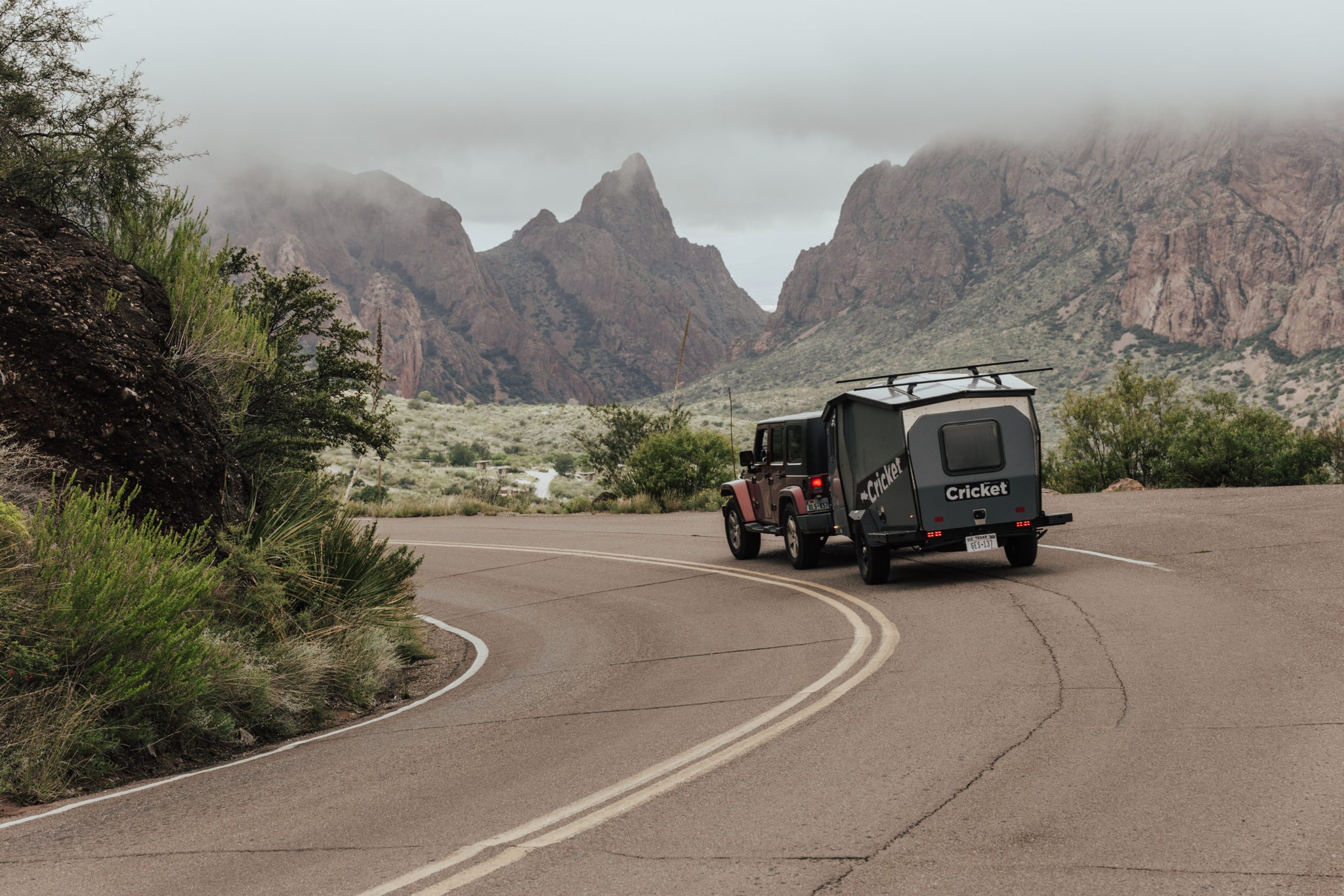
So, you’ve finally done it! You’ve bought the TAXA habitat of your dreams . Already, you can envision yourself towing your trailer along mountain roads and parking up next to beautiful lakes and waterfalls. There’s just one teeny-tiny problem — you’ve never towed a day in your life. Now what?
The good news is it’s really not that hard to learn. Take it from me! I learned to tow my 22-foot RV in just three weeks before taking off on a full-time adventure. I’ve been on the road since September 2020 and have had an amazing experience.
Find what you’re looking for:
Why understanding towing safety is important
Before you attach your trailer, how to hook up your trailer, how to drive while towing, parking your trailer, other towing faqs.
Ready for your first towing adventure with that new camper or trailer? Exciting, right? But, pump the brakes a little — safety comes first, not just for you but for everyone on the road. Without the right knowledge, accidents, vehicle damage, and unnecessary stress can lurk around the corner.
Is it hard to tow a trailer for the first time?
Towing a trailer for the first time may seem daunting, but with the right knowledge and preparation, it doesn't have to be difficult. Like any new skill, practice and patience are key. Take the time to familiarize yourself with your vehicle and trailer, and practice towing in a controlled environment before hitting the open road.
Thankfully, this guide's got your back. It's your shortcut to essential towing know-how, ensuring a safe and enjoyable journey. Buckle up for a smooth towing debut!
Before you start getting your trailer hitched up to your vehicle, there are some checks and items you should consider first:
Make sure your vehicle can actually tow your trailer
Understanding your vehicle's towing capacity is the first step to safe towing. Check your vehicle's manual or consult the manufacturer's guidelines to find its maximum towing capacity. This figure will help you assess whether your camper or trailer falls within the acceptable weight range. Exceeding the towing capacity can strain your vehicle's engine, transmission, and brakes, leading to safety hazards and potential damage.
For more information, see our in-depth guide on understanding trailer weights , or check out our guide to common tow vehicles .
Check your tires
Before hitting the road, thoroughly inspect the tires on both your tow vehicle and trailer. Underinflated or worn-out tires can compromise stability and increase the risk of blowouts, especially when towing heavy loads.
During a long trip up to Wyoming from California , I almost had a double blow-out. I did check my tires, but when you’re still learning, you’re not always sure what to look for. Here’s my advice:
- Check the tread of your tires to ensure they haven’t worn down
- Check the sidewall of the tires for cracks
- Check the seams of the tires to see if you see any splitting or lifting
- Check the PSI of your tires to ensure they match the recommendations for your trailer or for that specific tire
- Make it a habit to regularly monitor tire pressure throughout your journey
- Remember to check the spare tire
Get tow mirrors
When it comes to towing, visibility is king, and regular mirrors might not cut it. Enter clip-on or extended mirrors — absolute must-haves that latch onto your existing side mirrors (although TAXA campers are skinny enough that these typically aren’t necessary). Adjust them just right, and voila! Those pesky blind spots are history, giving you the upper hand for lane changes, merges, and parking with confidence.
Get safety chains
These are crucial safety features, providing a backup connection between your tow vehicle and trailer in case the primary hitch fails. Cross the safety chains under the trailer tongue and attach them to the hitch on either side. Make sure they're snug but not dragging on the ground. These chains are your fail-safe, ensuring your tow vehicle and trailer stay connected, no matter what.
Follow the 60 / 40 rule
Have you ever heard of the tail wagging the dog? It happens when you fail to load a trailer properly. To prevent this from happening, use your axle as a marker. Then, enter the camper and make a note of where the axle runs underneath. When you load your personal items, try to keep 60% of the weight toward the front of the camper and 40% of the weight toward the back (this doesn’t have to be exact, just do a rough estimate).
Plan gas stops ahead of time
Before hitting the road, factor in the refueling game plan with your trailer in tow. Opt for larger gas stations, as they offer more elbow room for smoothly maneuvering your vehicle and trailer. Assess the accessibility of gas stations along your route, ensuring their entrances and exits can handle your entire setup.
While every trailer is different, the broad steps you’ll need to follow for hooking your camper up to your vehicle are:
- Position Your Vehicle: Back your vehicle up to the trailer, aligning the hitch ball with the trailer coupler. Take your time and make precise adjustments to ensure a proper connection.
- Lower the Trailer onto the Hitch: Use the trailer jack to gradually lower the trailer onto the hitch ball. Be attentive to prevent any sudden drops that may damage the hitch or trailer.
- Lock the Coupler: Once the trailer is securely on the hitch ball, lock the coupler in place. Double-check that the locking mechanism is engaged, providing an extra layer of security.
- Connect Safety Chains: Cross the safety chains under the trailer tongue and attach them to the hitch on either side. Ensure they are crisscrossed to form an "X" shape, providing stability in case of a hitch failure.
- Attach Trailer Wiring: Connect the trailer's wiring harness to your vehicle. Test all lights and signals to confirm they are functioning correctly. Proper lighting is essential for safe towing, making your intentions clear to other drivers.
Taking your trailer on that first trip is an exciting but nerve-wracking experience. I still remember my sweaty palms and the butterflies in my tummy the first time I merged into Atlanta’s 16-lane highway traffic with my 22-foot trailer. I had an incident-free towing experience, so let’s do our best to ensure you do too.
Calm yourself before towing your trailer
When you finally take your camper out for that first trip, you need to be calm. If you’re too tense at the wheel, you run the risk of over-correcting at the smallest provocation, which can be dangerous. Once you’ve been on the road for about 15 minutes or so, you’ll likely start to relax and feel more at ease.
Adjust your brakes
Your trailer or truck may or may not have adjustable brakes. For example, I can adjust my trailer brakes from inside the truck. If yours are adjustable, put your hazards on and drive a few feet down the street. Then, use the brakes normally. If your trailer stops too suddenly, turn the brake strength down. If you feel no assistance in braking from the trailer, up the number.
Practice towing your trailer
Once or twice per week, I would drive 1 hour and 15 minutes to the acreage I stored my trailer on. At first, I only towed it around the property. On the second solo trip, I took the trailer back to a Walmart parking lot that I used to practice parking to get used to a different environment.
Keep it steady and moderate. Going too fast can lead to trailer sway, where your trailer oscillates from side to side, playing havoc with your stability. Stick to the speed limits set by your vehicle's maker for towing. If sway does sneak in, gently ease off the gas and avoid heavy braking. You can also consider investing in a trailer sway control system, which enhances stability and control during your journey.
Turning with a trailer requires a different approach compared to solo driving. Given the extended length of your setup, opting for wider turns is key to avoid the trailer cutting corners or colliding with obstacles (and other vehicles). Consistently check your tow mirrors to track the trailer's position and ensure it sticks to the planned swing path. A bit of practice in an open area before venturing onto the road can go a long way in getting comfortable with the nuances of turning while towing.
Hills and inclines
Navigating inclines with a camper or trailer demands a careful approach. When heading uphill, keep a consistent speed and avoid abrupt accelerations. If your vehicle is struggling with the incline, think about downshifting to a lower gear for that extra torque. On the way down, opt for lower gears to manage your speed, minimizing reliance on brakes that might overheat and jeopardize safety.
Be aware of how things feel
While on the road with your trailer, keep an eye on how your vehicle and trailer behave and feel. If you sense odd vibrations or catch unfamiliar sounds, don't brush them off — tackle them right away. Any shifts in handling, responsiveness, or stability warrant attention. If things seem off, find a safe spot to pull over and give your setup a thorough once-over.
Follow road etiquette
Stick to the right lane on highways, giving faster-moving vehicles a clear path to pass safely. Signal your intentions well ahead of any maneuvers and exercise caution when changing lanes. Keep a safe following distance, allowing for ample reaction time, and steer clear of tailgating. A touch of consideration for fellow drivers ensures a smoother and safer experience for everyone sharing the road.
Towing in inclement weather
Navigating difficult weather while towing demands extra care. Rain or snow means slippery roads, so ease up on the accelerator, reduce your speed, and extend your following distance to accommodate longer braking distances. Keep a steady grip on the steering wheel, especially in gusty winds that can sway or push your trailer. If conditions turn too perilous, consider delaying your journey. Safety should always be your compass, guiding adjustments to your driving to match the weather conditions.
Parking a trailer can be a challenging task for first-time towers, but with practice and patience, it becomes more manageable. Take the time to develop your skills in various scenarios, and soon you'll be confidently navigating parking spaces and campsites on your outdoor adventures.
- Understand Your Trailer's Dimensions: Familiarize yourself with the dimensions of your trailer, especially its length and width. Knowing these dimensions will help you gauge the space needed for parking.
- Choose an Open Area for Practice: Before attempting to park your trailer in a tight space, find an open area like an empty parking lot. This allows you to practice maneuvering without the pressure of obstacles.
- Practice Straight-Line Backing: Start by practicing straight-line backing. Align your vehicle and trailer in a straight line, then slowly reverse while keeping an eye on both side mirrors. This fundamental skill will serve as the foundation for more complex parking maneuvers.
- Master Angled Parking: As you gain confidence with straight-line backing, progress to angled parking. Choose an open space with lines or markers and practice parking your trailer at various angles. Use your mirrors to guide you and pay attention to the relationship between your vehicle and the trailer.
- Use a Spotter When Available: If possible, have a spotter assist you when parking to provide guidance and help you avoid obstacles. Communication is key — establish clear signals beforehand, such as hand gestures or two-way radios.
- Use Reference Points: Develop reference points to gauge your trailer's position. For example, identify a spot on your vehicle or trailer that aligns with a specific point on the ground. This helps you maintain control and accuracy during parking.
Other tried and true advice
There was one YouTube video that changed my life:
It is half an hour long, but it’s worth watching. The video taught me the theory behind backing in, which made the practical aspect of it much easier. I watched it every day for a week before I first attempted to back up my trailer.
Some of these tips I learned from watching the video. Others, I’ve learned during my travels:
- If possible, install a backup camera on your camper , but only use it to ensure you aren’t about to hit something.
- When backing in, always start with the site on the driver’s side . This is much easier because you have better visibility.
- If you’re backing up solo, do it at an angle . It’s easier to monitor the turning radius than it is to guess what’s directly behind your trailer.
- Even if you have the world’s best spotter, always get out and look at the site for yourself .
- If you have a spotter, agree from the start what they mean by left or right . This might sound silly right now, but it will make sense once you try it.
- Use the bottom of your steering wheel as a guide . If you turn from the bottom to the left or right, the back end of your trailer will do the same.
- Your trailer will not turn immediately , so budget for it to go the wrong way first when getting into tight spaces.
Congratulations! You now have all the basic information you need for towing your trailer. Need some one-on-one advice? Talk to a TAXA Adventure Specialist today!
Are there age restrictions for towing?
Age restrictions for towing vary by location. In many places, you need to be at least 18 years old to tow a trailer. Check local regulations to ensure compliance.
Can you tow in the left lane?
In most cases, it's recommended to stay in the right lane while towing. Use the left lane for passing only, as driving in the left lane can impede traffic.
What causes fishtailing?
Fishtailing (or trailer sway) occurs when a trailer swings from side to side. It can result from uneven weight distribution, improper loading, or high speeds. Properly distribute weight, load your trailer evenly, and drive at a safe and moderate speed to prevent fishtailing.
Can you tow with a full water tank?
Towing with a full water tank adds extra weight and can impact your vehicle's towing capacity. Consider emptying the tank before towing and fill it at your destination if needed.


Beginner’s guide: Tips for First-Time Travel Trailer Adventurers
Heading out camping for your first time can be both a scary and exciting experience. If you’re new to travel trailer camping you’ve probably spend a lot of time reading and asking and learning how best camping should be done. But, there’s no better way to learn than by doing.
Here you’ll find one mom’s story of what they learned and why you should take note of these first time travel trailer tips!
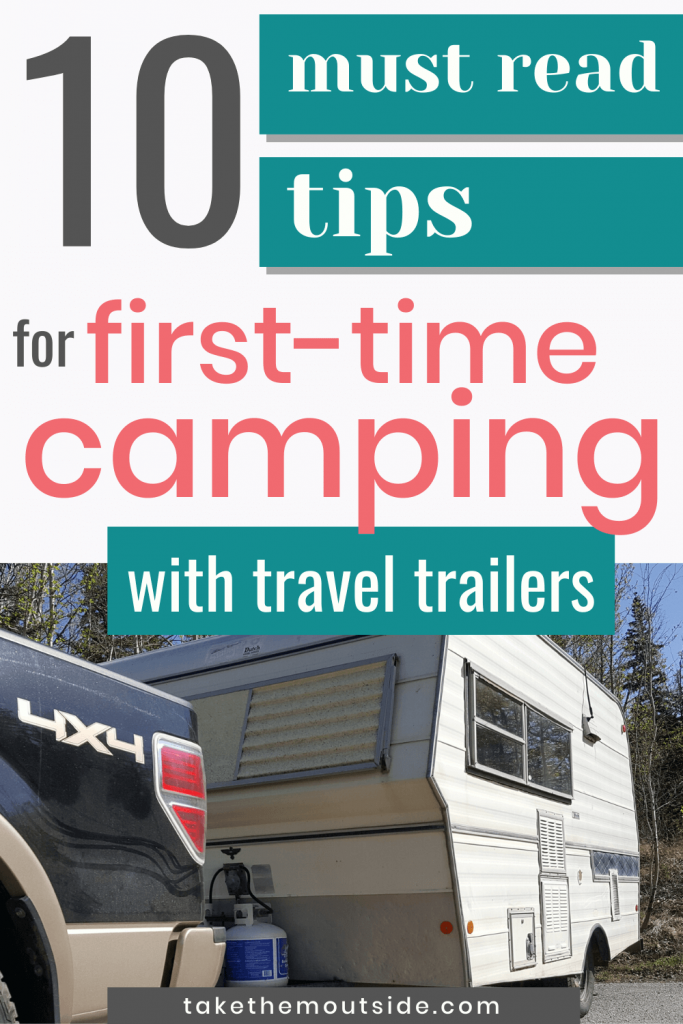
(This post contains affiliate links for your convenience. As an Amazon Associate I earn from qualifying purchases . If you make a purchase through my link I receive a small commission at no added cost to you. See my policy page for more information)

A first time travel trailer camping story by Heather of Nesting Intentionally
As first time travel trailer campers, we have learned a lot! …mainly what NOT to do!
Even though we had expert campers to help guide us, we still managed to learn a ton of lessons, the hard way. We have many, many tips to share. There are a few camping tips that you may have heard before that you should not ignore. Then we have a couple lessons we learned that we hope will help you in your camping adventures too.
When I was a kid we didn’t camp much. When we did camp it was in a tent with 3 kids and my mom for the weekend. I grew up in Florida. It’s hot there. Especially in a tent, in the summer, with 4 people. My memories of camping are okay. We had fun playing in the dirt and going on scavenger hunts , but it was so hot!
My husband went camping all the time as a kid. His family had a camper. They had a pop up first, then a trailer, then a 5th wheel, and now his parents have an RV. But if you were to ask him if he liked camping as a kid…. he’d tell you no. It was hot and there were too many bugs. Oh and he doesn’t like to eat outside… strange, I know.
So naturally, two people who didn’t like camping as kids, what do they do?
They go out and buy a camper!
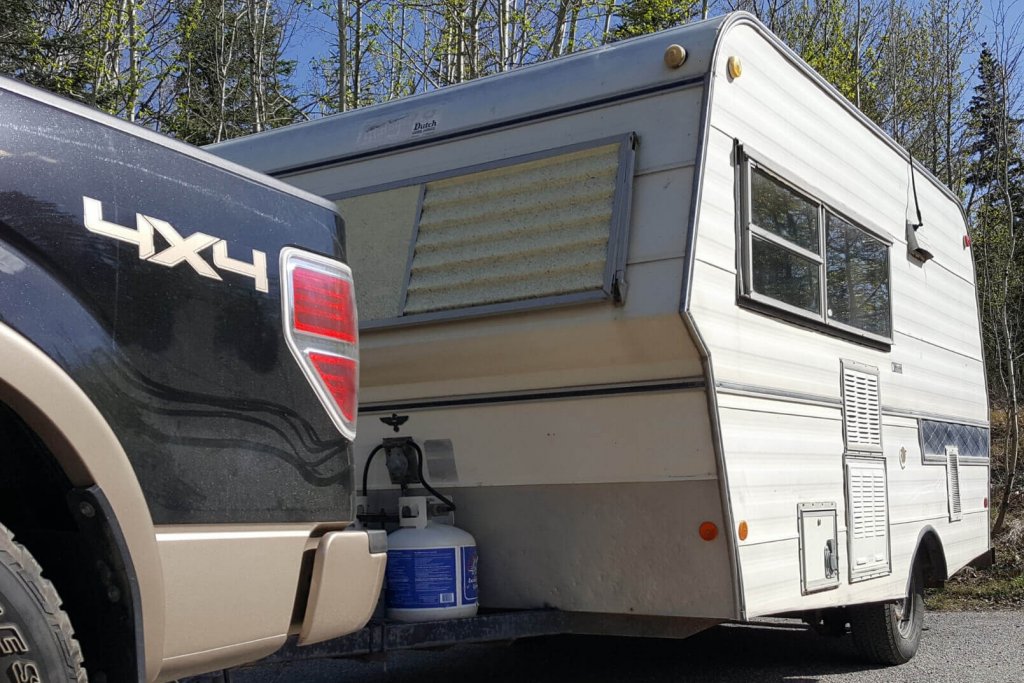
We talked about it for YEARS before we bought one. The memories that we made as kids surpass all the negative feelings we had toward camping.
As a kid you love getting outside, playing with dirt, experiencing the outdoors. Whether you live in bug infested Florida or the snowy mountains, there is always fun to be had outside. That is what we want for our kids. We want them to have the experiences that we had and then more.
The camper we bought is a 2005 KZ Coyote Hybrid. It’s a cross between a pop up and a travel trailer. The beds pop out like a pop up trailer does. But the whole trailer is hard sided like a regular travel trailer. It’s very spacious inside, compared to most travel trailers.
First, passing along some travel trailer camper trailer advice:
Some camper tips that we did because we were told to by expert campers…..
- Park the camper at the house at least 2 days before you leave so you can pack the camper and turn the fridge on .
- Do a running check of everything before you leave to make sure that all brake lights, appliances and camper is all in working order. ( Here’s an RV checklist to help you make sure you’ve done and checked everything before you head out)
- Pack a level…. Yes, the level tool you use to hang pictures on the wall . When you put the stabilizers down you have to make sure the trailer is level and not too high or low on a side.
- Practice towing and backing up the camper…every camper has a story or two. You’ll thank yourself later for doing a couple (or a couple dozen) practice runs.
Now, for the first time travel trailer tips and tricks:
1. pack everything in totes .
Put food, bedding, and camper parts in separate totes.
Once you get to camp you can unpack all that needs to get put away. Then all the totes can go outside and be stored under the travel trailer. You’ll want to pack the camper well and totes are the answer.
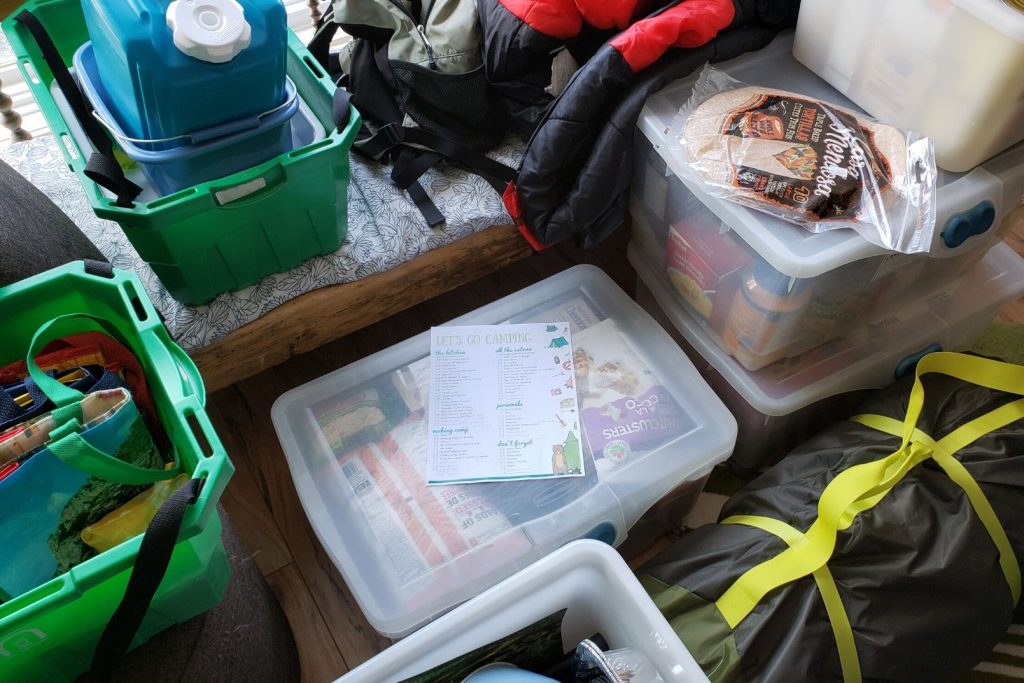
2. Once you get to camp, put everything away
Make all the beds, put all the food away, put all the clothes and towels in a place, make the beds, make sure everything has a place where everyone can get to them as needed.
Get everything nice, neat and organized. Everything needs a place or you’ll feel like the walls are caving in with all the stuff everywhere.
3. Get some command hooks
We have command hooks for our keys by the door. There are 5 in the itty bitty bathroom for our towels. There is one near the door for the fly swatter. And a couple others spread throughout the camper.
Yes, command hooks are super handy!

- INCLUDES - 2 hooks and 4 medium indoor strips; 1 hook holds 3 lbs
- ORGANIZE DAMAGE-FREE - Say goodbye to holes, marks, or sticky residue on your walls, doors, cabinets, or closets; Command Hooks by 3M are easy to use and help keep your walls looking beautiful
- NO TOOLS REQUIRED- Hang hats, bags, dog leashes, scarves, and accessories where you want without nails or a hammer
- STRONG AND VERSATILE- Command Designer Hooks hold strongly on a variety of indoor surfaces including painted walls, finished wood, glass, tile, metal, and other smooth surfaces
- REMOVES CLEANLY- Reorganize when inspiration strikes; These wall hooks leave no sticky adhesive behind; Perfect to use inside cabinets and closets, in your college dorm, apartment, home, and office
4. Bring extra shoes for the kids
My kids get so muddy…. They must gravitate to the mud. They literally had to wear wet, muddy shoes for about a day until the sun came out for a couple hours to dry them up.
5. Bring cash for laundry
There is usually a change machine in the laundry room to exchange your dollar bills for coins. But if you don’t have cash…. you’ll need to find some. If you’re camping at an older facility, the laundry machines vending machines might also only take coins…not cards.
6. Do research on your campsite
Do you want to be near the bathrooms? Does it have a general store in case you forgot salt & pepper? Are there trees for shade? Does it have a laundry room? Does the campsite have full hook up (cable, sewer, electric, water)? Does it have a picnic table or fire pit? Does it have cell service or Wifi?
These may not be things you need/want but if you are looking for something specific, I’d check, because not all campgrounds are the same… (don’t ignore this one)!
READ MORE: This article will give you some tips and suggestions for choosing the best campsite for your family’s needs.
7. Don’t remove the yellow blocks too early
…not until everything is hooked up and you are about to pull the trailer out of the driveway. I took those little yellow triangles out too early. The trailer was on the ball. It managed to get pushed off the ball and roll almost into the back of the truck. (don’t ignore this one either)!
8. Get a big outdoor rug
You’ll want a rug for the outside of the camper . Trust me: the bigger the better. You’ll need it for everyone’s muddy, dirty shoes/feet.
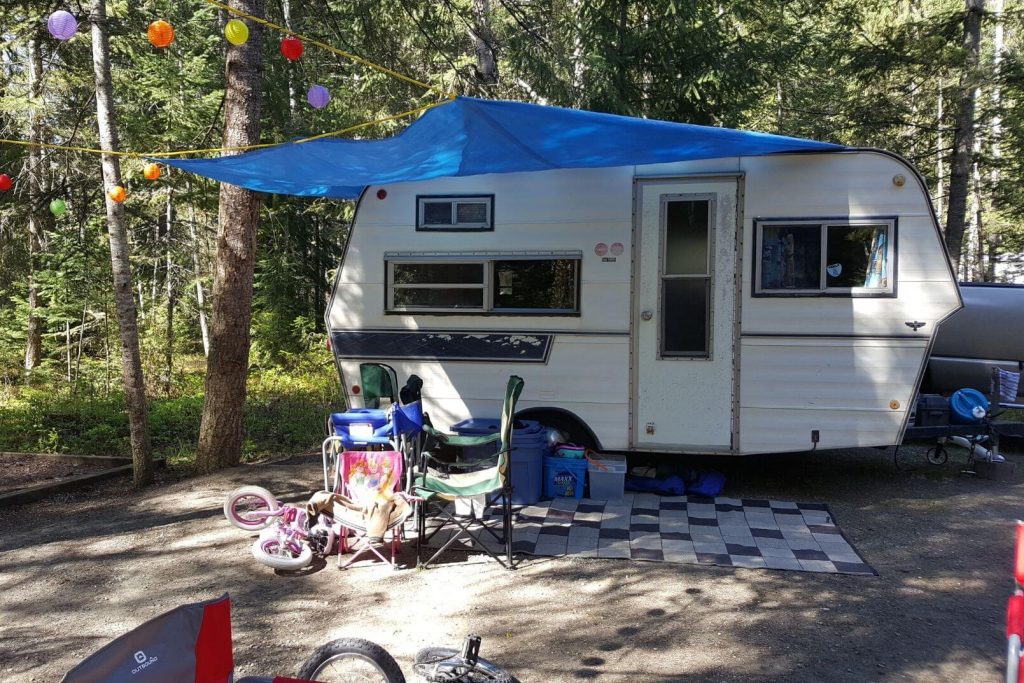
9. Make a list for everything
You need a checklist to make sure that your camper is ready to leave your driveway. You need a list of kitchen stuff and food. You need a list of clothes and accessories to bring. It’s overwhelming if you don’t have a list for it all. You will forget something!
My in-laws… who have been camping like 40 years, still have a list. It’s a lot smaller than mine, but you get the point. (don’t ignore this one)
Here’s a free printable camping packing checklist you might want to check out if you’re looking for a starting place.
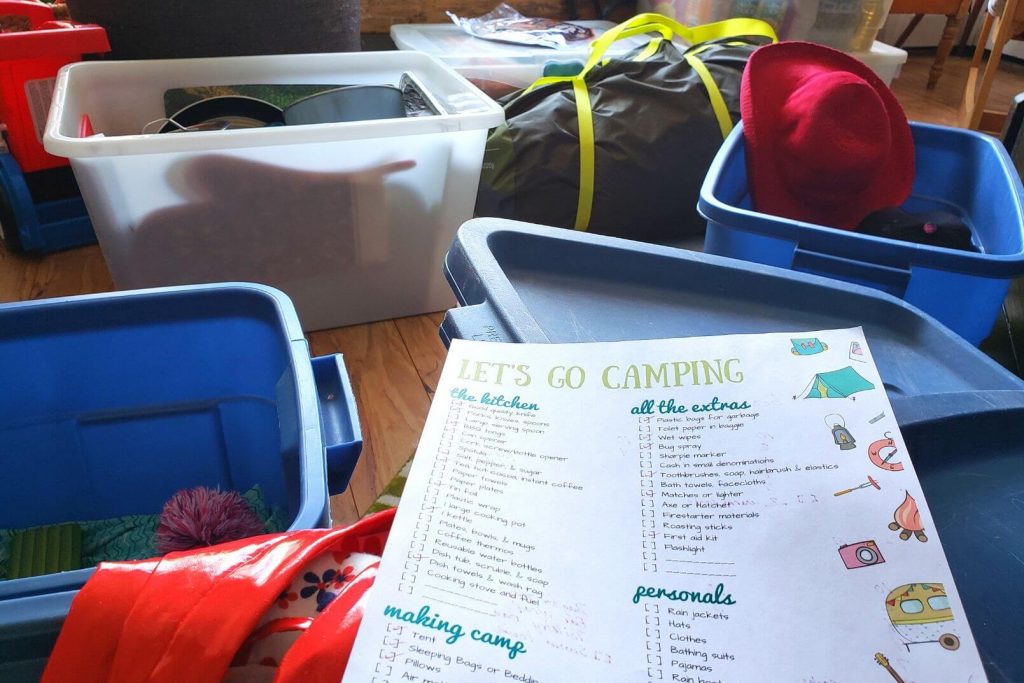
10. Don’t pack too many rainy day games
Don’t pack 3 board games, 2 movies, and a deck of cards for the kids, in case it rains or they get bored.
If it rains, go play in it. If they get bored, go outside and explore. All that extra stuff only takes up space.
Travel trailers don’t have a ton of space to begin with, so use it wisely and leave that extra stuff at home.
But, here’s a post full of camping games and camping toy ideas in case you do want a few suggestions.
I hope our mistakes and lessons learned help you on your first travel trailer camping trip or your next one!

Written by Heather
Also written by Heather is this article, Surviving Quarantine with kids
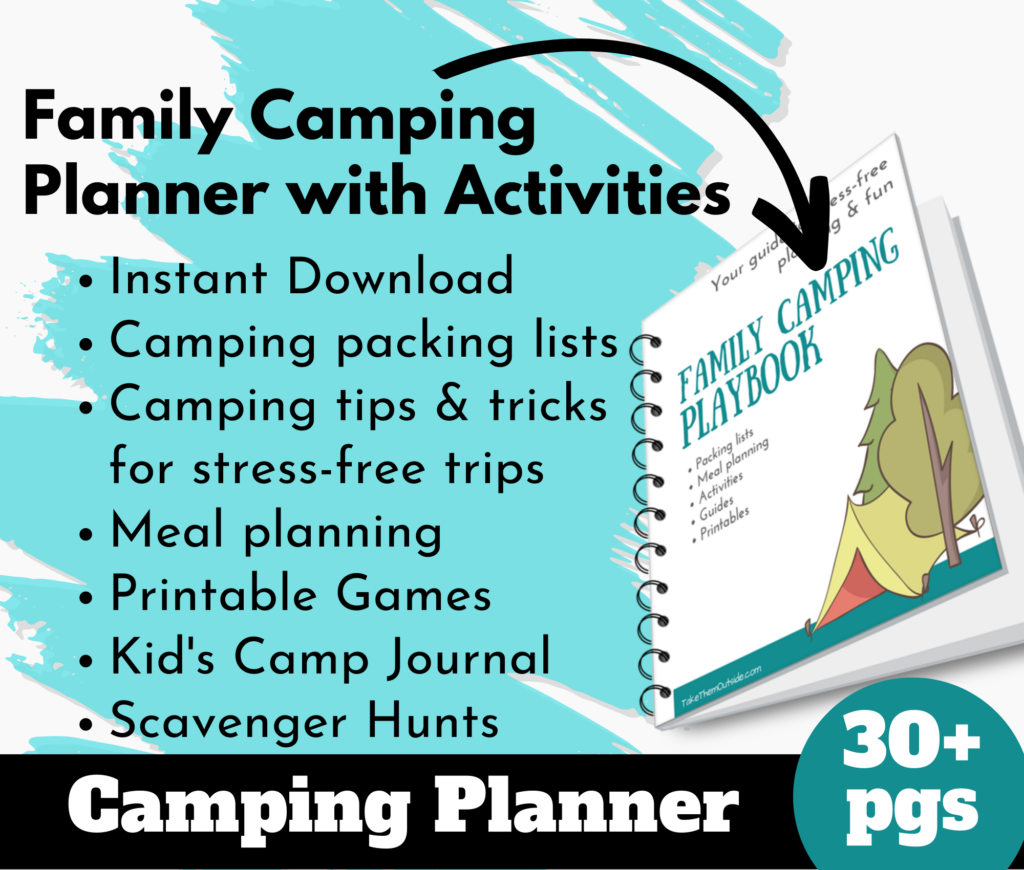
For more camping reading, check these out next:
- No more bored kids! – how to keep them busy and having fun at the campground
- Camping in bear country – how to teach kids bear safety
- Super important and often over-looked RV camper trailer tips
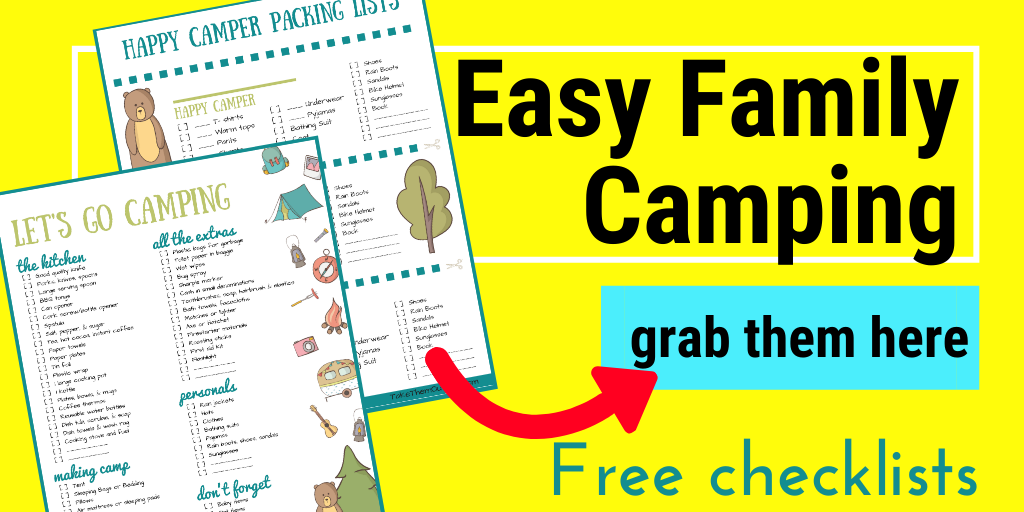
5 thoughts on “Beginner’s guide: Tips for First-Time Travel Trailer Adventurers”
I agree with your point about making a list of everything because it is very important to make sure that we don’t forget any essentials during our trip. So thank you for sharing this checklist, I like the way you make a separate section for everything.
Great article! Your Tip 9 (Make a list for everything ) is great because when we make a list we take everything we need to camp with us. I agree with you all. Thanks for providing such information
Thanks for the tips! But I disagree on leaving the games and movies at home. On a stormy night, those were some of our best memories! I’d rather have them and not need them (keep ‘em in a bag in the car) then have restless kids and grumpy parents in a small space.
Yeah, that’s a tricky one! I agree that I don’t want my kids to just hang out inside an watch movies. If this were me (and I actually had something to watch videos on in a camper) I’d probably just tuck them away as a last resort option instead of the first choice… but, you’re right, cuddling and movies can be great family time together!
I can’t wait for the next articles
Leave a Comment Cancel Reply
Your email address will not be published. Required fields are marked *

Travel Trailer Tips for Beginners
Last Updated on February 22, 2024 by Grant
Owning a travel trailer has been one of the best experiences of our lives. We bought ours back in 2016 and have taken it out each summer on some pretty epic road trips as well as shorter trips throughout the year. That said, owning a travel trailer definitely has a learning curve. Now, we know what we’re doing and are happy to share our travel trailer tips with you.
It has taken us quite a bit of trial and error to figure out how to make the best of the camper. To help you avoid some of the headaches we endured, we’re bringing you these travel trailer tips for beginners. In this guide, you’ll find everything you need to know about buying and owning a travel trailer.
We hope this post helps you smooth out the problems when you first take out your travel trailer.
(Disclaimer: When we link to places where you can buy our stuff or places we stayed, we are using special codes that earn us commissions on the sales at no additional cost to you. Please see our Review Policy for more information.)
Before You Buy a Travel Trailer
My number one tip before buying a travel trailer is to make sure your vehicle can tow it. Check with your vehicle’s manufacturer to determine the towing capacity of your vehicle. Then go through the step using this app to see your real tow capacity. Just because your vehicle says it can tow something doesn’t mean it actually can do it safely.
Once you have determined how much you can safely tow, you need to prep your vehicle to tow.
For all but the lightest trailers, you are going to want a Class IV hitch at the very least. If the camper weighs more than 3,000 pounds, you will need to have a trailer brake controller. If you are towing a camper over 5,000 pounds, you are gonna need a weight-distributing hitch. This keeps the trailer and the back end of the truck level. Most also have some anti-sway capability as well.
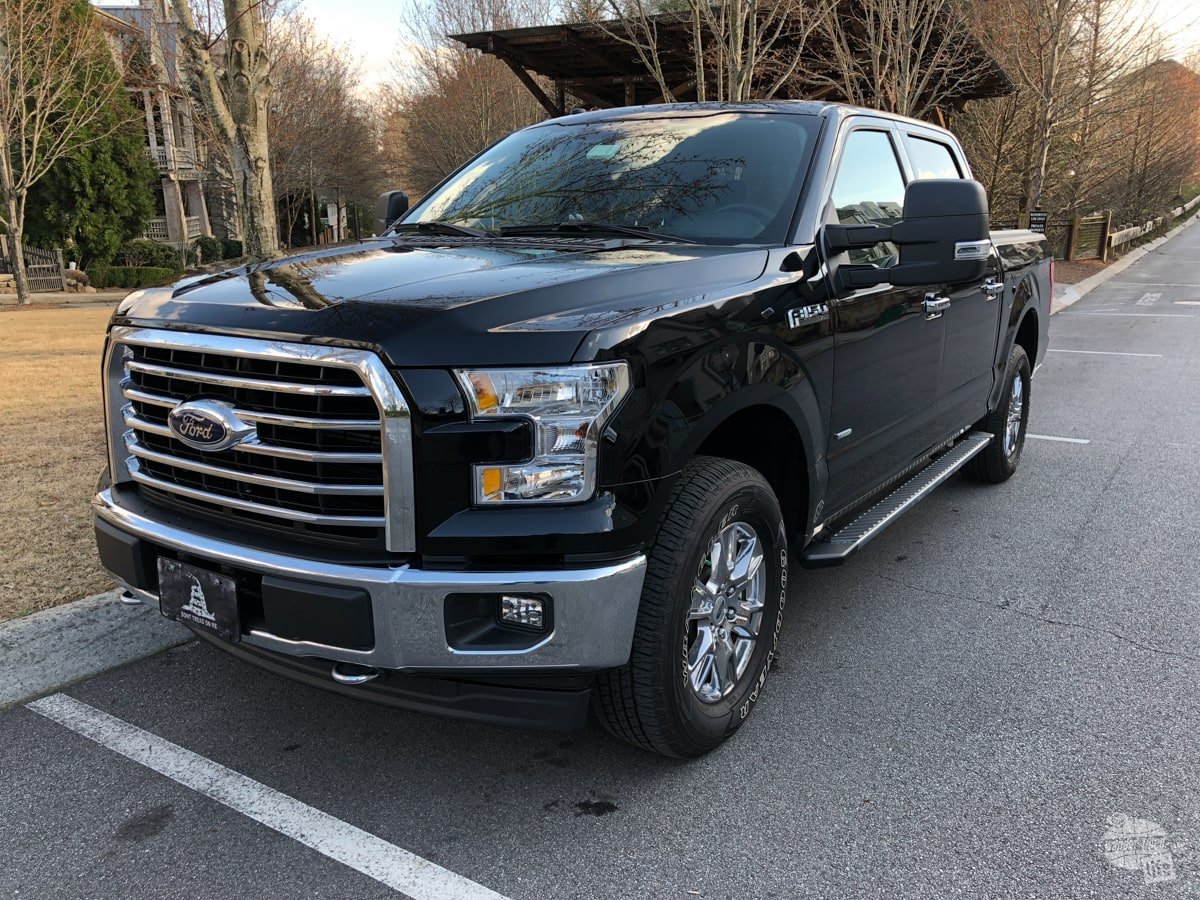
We have a Husky Centerline TS and it has worked perfectly for us. The dealer tossed the hitch in with the price of the camper and installed it for us.
Lastly, you are gonna want tow mirrors. There are mirrors you can clamp on and mirrors that you can install. Max tow packages for most trucks often come with tow mirrors. We bought Trail Ridge Tow Mirrors for our F-150 . They were easy to install ourselves and are quite happy with them.
Now, your vehicle is ready to tow a trailer!
Read more about the vehicle we tow with, a 2017 F-150.
Buying a Travel Trailer
When we were looking for our first travel trailer, one of the best pieces of advice we found on the Internet: Buy your second camper first. We agree with that advice.
RVs do not appreciate in value like a house. They lose value like a car. So, if you are buying a “starter camper” to see if you like the RV life, I recommend renting an RV. Take it out for the weekend instead of buying. It will save you a LOT of money.
Read more about renting a camper through Outdoorsy here.
Don’t let the dealer try to convince you to buy more than you can safely tow. That’s really important. You do not want to be barely able to pull your travel trailer through the Mojave Desert or over a tall pass in the Rockies.
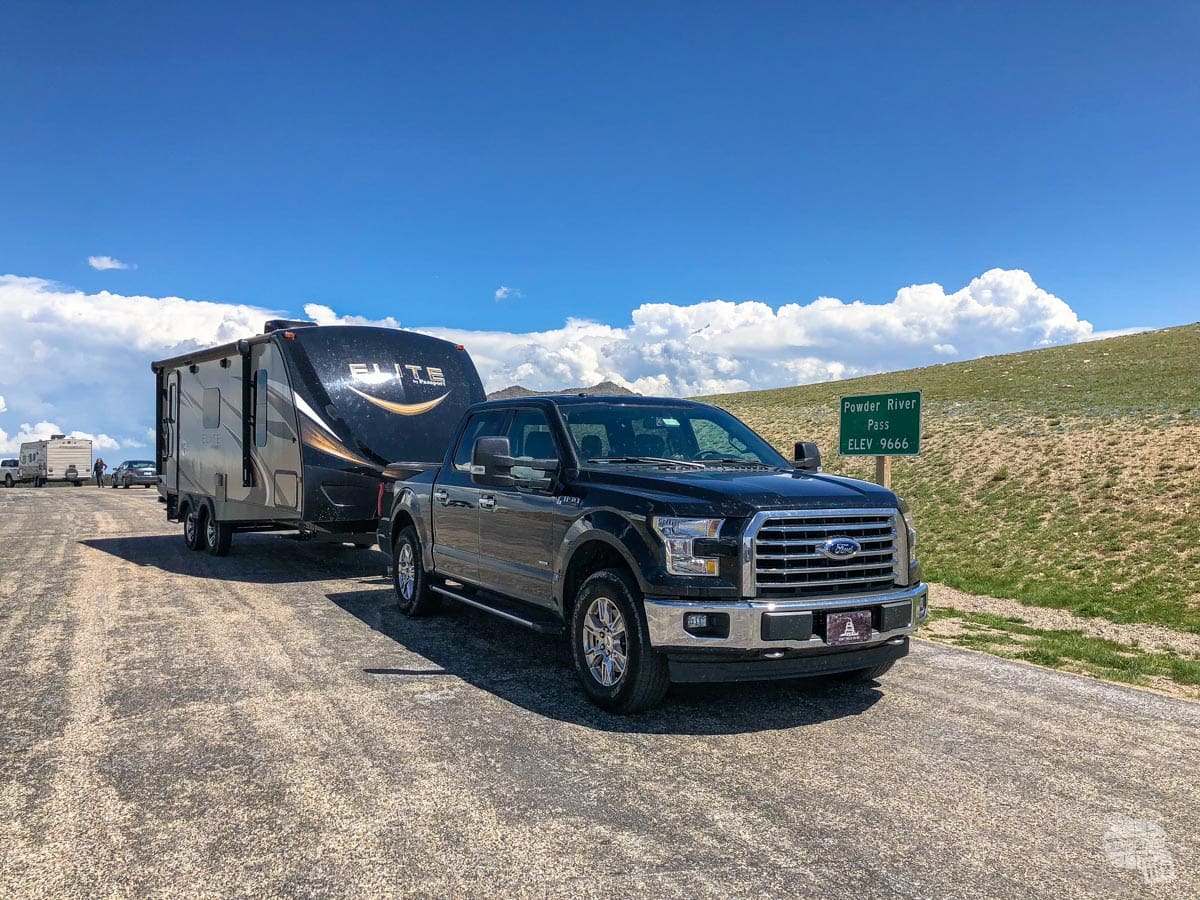
Think about what you want in your trailer and try out a bunch of them. An RV show is a great place to check out a bunch of campers. Pick a floor plan you like then see which dealer has the best deal.
Read How to Get the Most Out of an RV Show here.
We wanted a wrap-around queen bed and a couch instead of a dinette. In hindsight, we wish we got both a couch and a dinette. Then we could use the dinette as a desk for working on the blog. We make it work, though. And that is certainly not enough of a problem to buy a new camper!
Another important feature for us was having plenty of storage space. We have closet space by the bed and by the front door/bathroom. And plenty of cabinets in the kitchen. There is also a large pass-through for outdoor items. That said, we are struggling to make our new chairs fit with everything else we have in the pass-through.
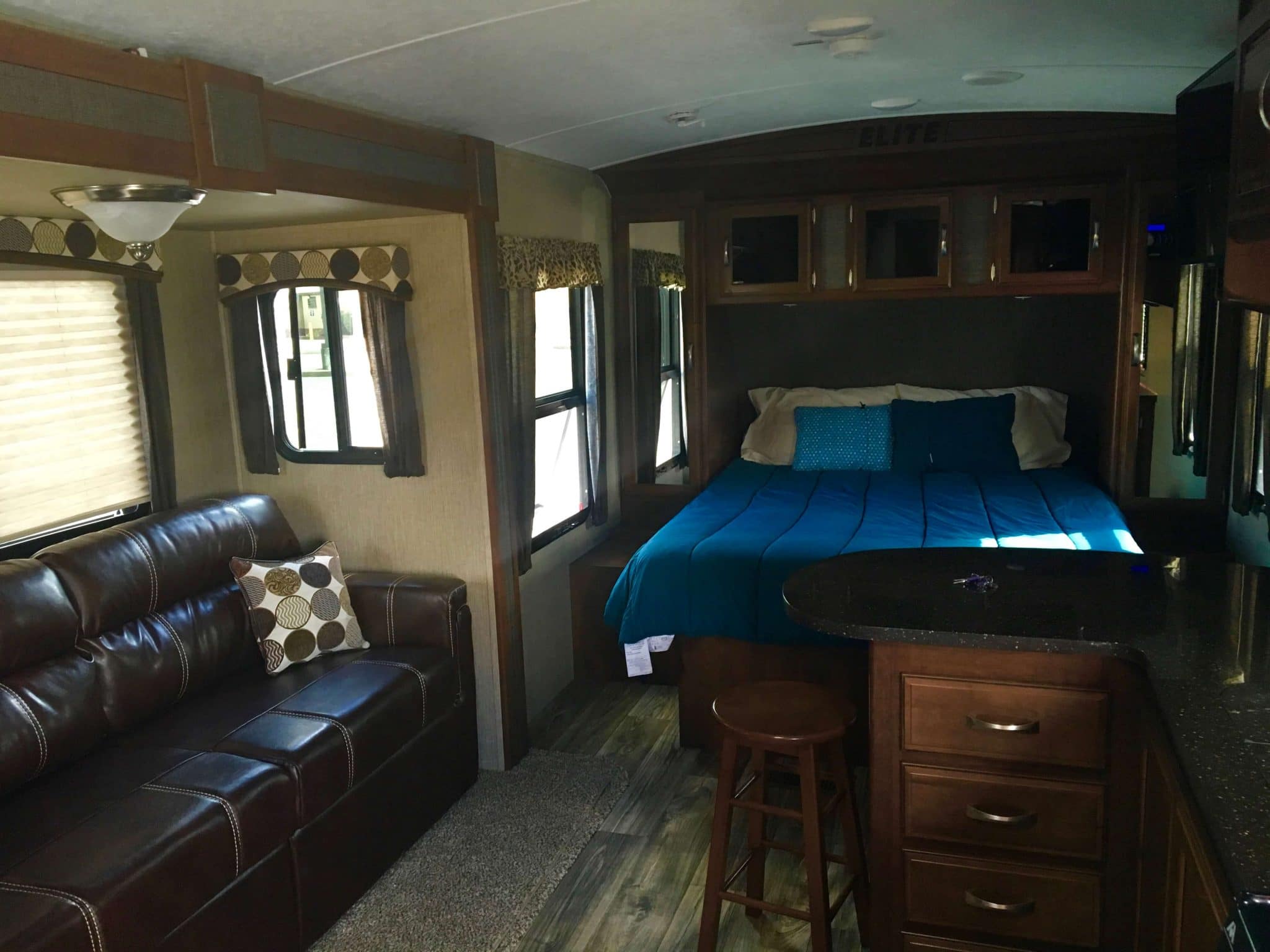
Make sure you have the dealer walk you through the camper. Have them show you where everything is. You need to know where to find cut-off valves, the fuse box and the reset buttons on various appliances.
Read about our experience of buying our first travel trailer.
Add-ons to Have the Dealer Install
Once you have found and priced the perfect travel trailer, there are few things we recommend having the dealer install right off the bat. For some of these, you might be able to get the dealer to toss them in with the purchase price. Others, you are gonna need to budget for.
First and foremost, have flying insect screens installed on all of your exhaust vents! Dirt daubers like to make a home in those vents. Their nests can ruin a fridge, a furnace or a hot water heater. If you’re fairly handy, you could probably do this yourself.
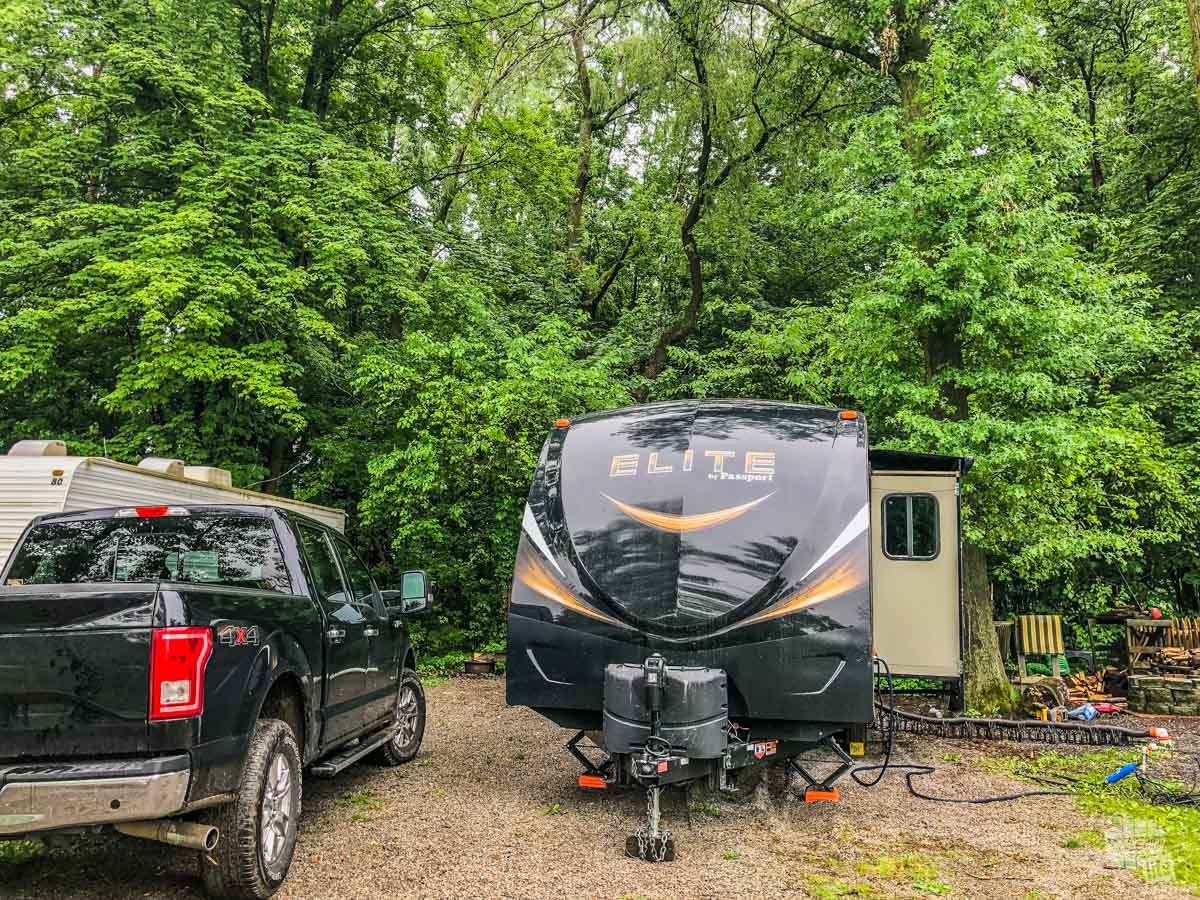
Second, get slide toppers if the trailer does not already come with them. These will keep debris from getting on top of your slide. The rubber gasket around the slide keeps debris out of your camper when you retract the slide. The slide topper will keep the debris from getting there in the first place. You will avoid having to clean off the top of the slide when you strike camp.
Third, get a battery disconnect. The carbon monoxide detector is always on and always draining the battery when we store the camper. A simple battery disconnect will help preserve the life of your battery if you cannot leave the vehicle constantly plugged in.
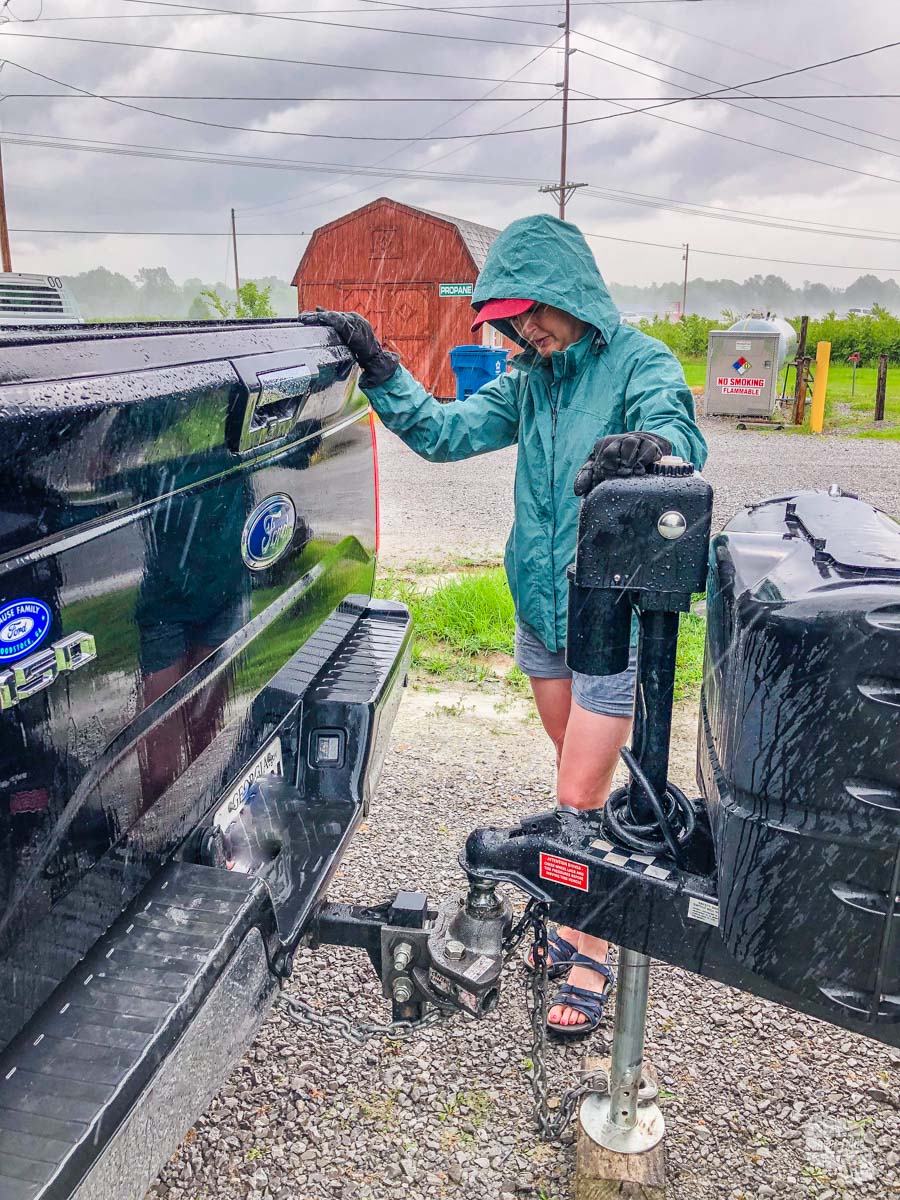
Fourth, get an electric hitch jack. I can’t tell you how much time and effort this will save you from having manually lower and raise the jack of the trailer.
I also recommend getting vent covers for the pop-up vents. We have a couple of Max Air vent covers that allow us to open the vents even when it is raining. This is really nice for venting out your bathroom after showers.
If being able to watch satellite TV is important to you, have a dish mounted on the roof. Both Dish and DirectTV offer packages aimed at RVs. I would certainly check the fine print in terms of contracts and requirements.
Lastly, if you camp away from connections (called boondocking) often, we recommend you talk to your dealer about having alternate power sources, like solar panels or a generator, integrated into your trailer from the get-go.
Outfitting Your New Travel Trailer
The reality is you are gonna need a lot of stuff for your camper. You’ll need equipment for getting everything hooked up and operational along with all the comforts of home – linens, cookware, dishes. We have written a top-ranked comprehensive guide on outfitting your travel trailer inside and out.
Read more about outfitting your camper here.
Seriously, we have you covered when it comes to outfitting your travel trailer.
Before You Take Your Travel Trailer on the Road for the First Time
As you load everything into the travel trailer, make sure the majority of your gear is loaded toward the front of the camper. If you push the majority of the weight (60%) forward of the axles, you will reduce sway considerably.
Check out this video from the folks at UHaul…
Once you load everything in, it’s time to check the wheels and tires on the trailer. Take a lug wrench and tighten down all the lug nuts. Then check the air pressure on all of the tires, including the spare. It does you no good to have a flat spare.
If you installed a battery disconnect, reconnect the battery at this point.
Then connect the hitch and the trailer. This process is different depending on the weight-distributing hitch you have. Make sure you lube everything that needs lube, including the ball.
Pro tip: If your battery is dead and you need to power the jack, once you connect the cable to the truck, you should get enough power to operate the jack. If the power is not immediately flowing, depress the slider on the trailer brake controller to send power to the trailer.
Make sure you hook in the chains, crossing in an “x” underneath the hitch so that if it comes loose, the chains will catch it.
Once you connect everything, you can remove the chocks and you are ready to perform one last walk-around.
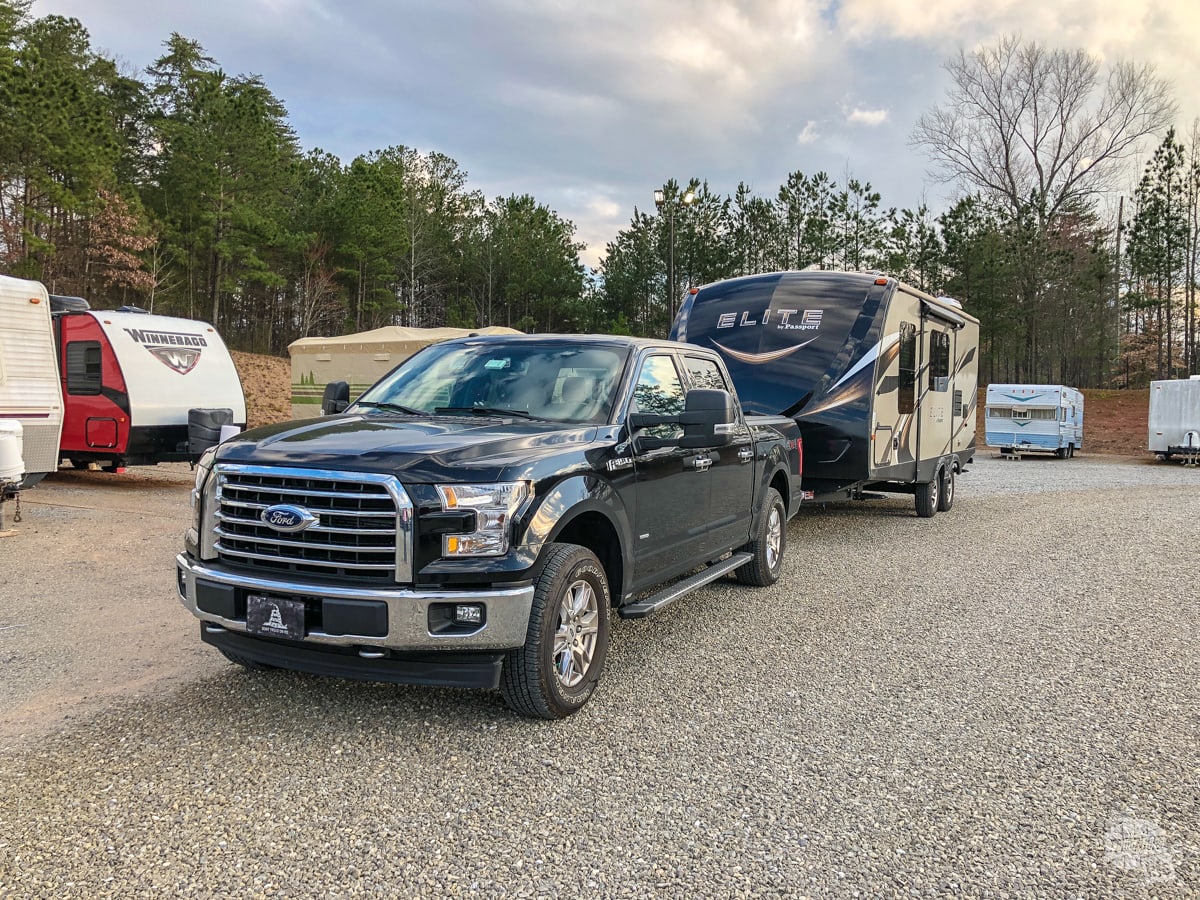
In this walk-around, make sure you close and lock all of the compartments. Be sure to double-check the windows are closed and the TV antenna is down. Then check the brake lights on the trailer to make sure they are functioning.
Lastly, make sure you extend the tow mirrors and you can see down the length of the trailer in the mirrors.
You are now ready to hit the road.
Towing a Travel Trailer
The first thing to know about towing a travel trailer is you can’t go as fast as you would otherwise. Most trailer tires are rated for 65 MPH.
A higher driving speed significantly reduces your braking speed and stopping distance. That means it is a lot easier for you to rear-end someone if they stop suddenly. Additionally, excess speed leads to increased sway which can easily topple your vehicle.
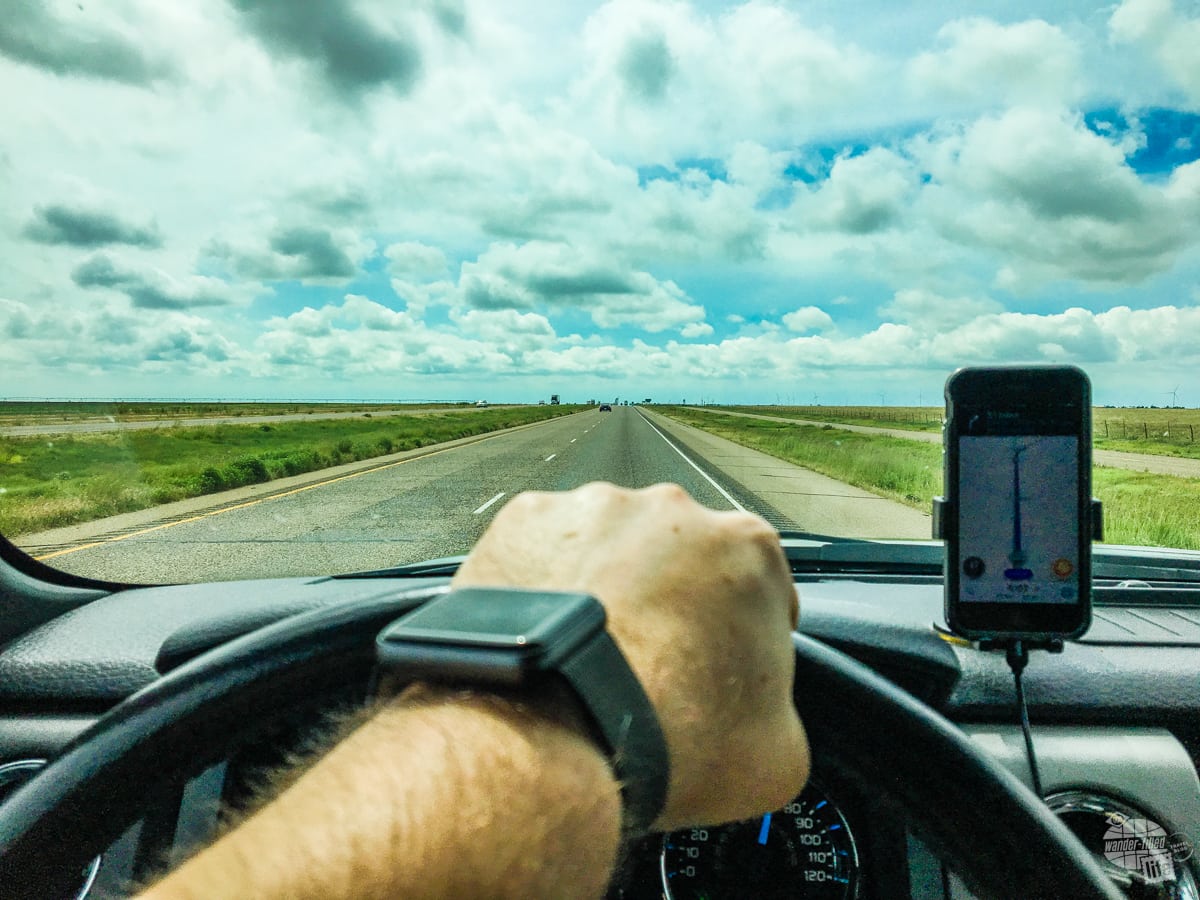
Additionally, it takes some time to get used to the additional space the truck and trailer combo take up on the road. Even towing a relatively small trailer poses difficulties in heavy traffic.
This also holds true for finding gas and fast food on the road. We highly suggest researching gas stations and restaurants to make sure they have RV parking or at least plenty of room. We use the satellite view in Google Maps or Apple Maps to check it out in advance.
Backing up a travel trailer is tough and there is no way to get good at it other than practice. Honestly, our worst arguments come from backing up our camper. I have gotten better at it but I always struggle a bit when we first head out.
Our F-150 has the Pro Trailer Back-Up Assist, which I love… when it works. When it doesn’t, mostly due to the sensor losing sight of the sticker, it tends to cut off when I need it most: on a tight turn.
Setting Up at a Campsite
We suggest camping somewhere with a Walmart or RV store nearby for your first few outings. You will find you need things you didn’t think of. Camping near a store means you can buy items you need easily, which will make your first trip that much better.
Read about the RV essentials you need before you hit the road here.
As you settle your trailer into the campsite, be sure to take note of where the connections are. On our second trip, we managed to set up too far away from the water connection and had to buy a second water hose.
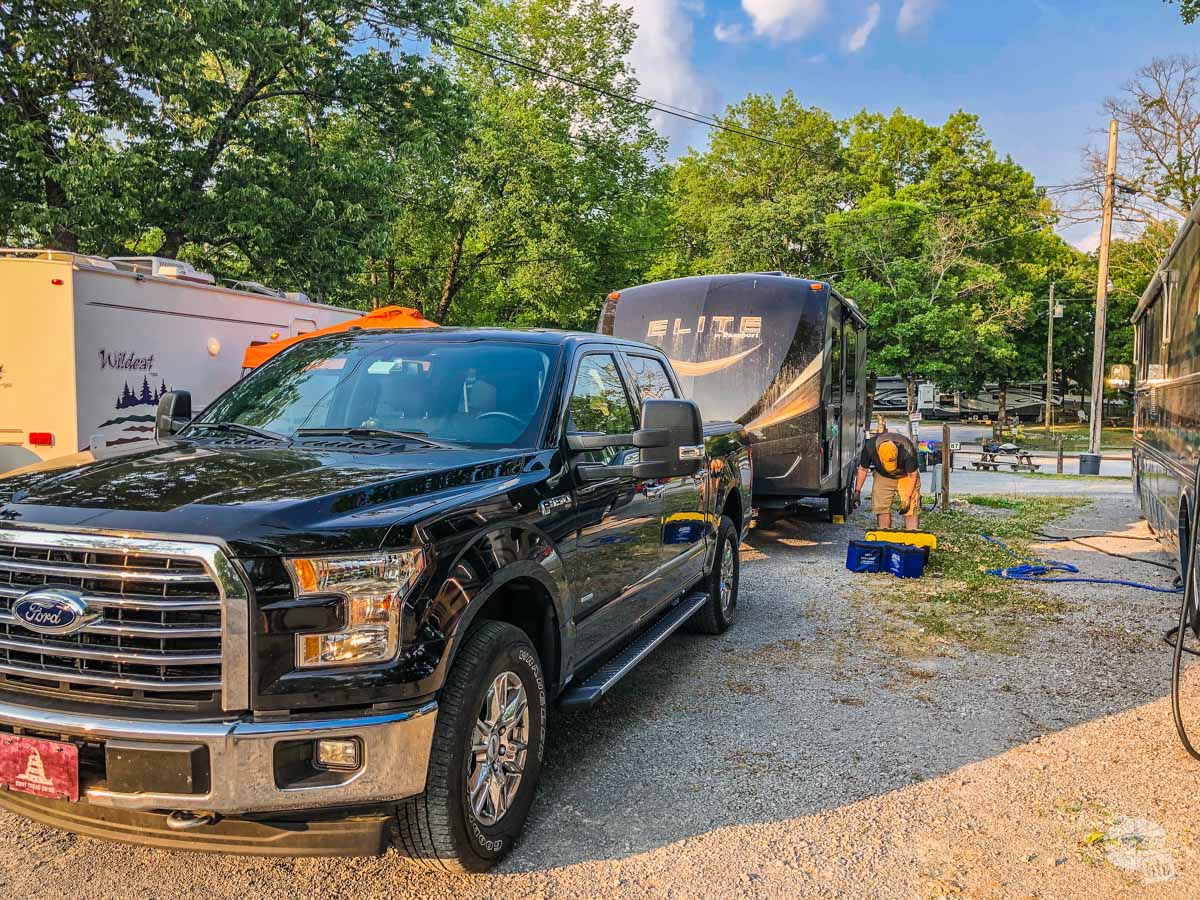
Pro tip: We store all of the gear we need for setting up in the pass-through on the left side of the trailer. This allows easy access for the driver to everything needed to get the travel trailer set up.
Take a large construction-style level with you for the first trip. As you get settled in and level the trailer, then apply the bubble levels we recommend in our outfitting guide to the outside of the camper to make leveling it easier in the future.
Use levelers to make sure your trailer is level. Most fridges will not operate if the camper is not level. Make sure you put chocks down to keep the trailer from moving before you disconnect from the truck.
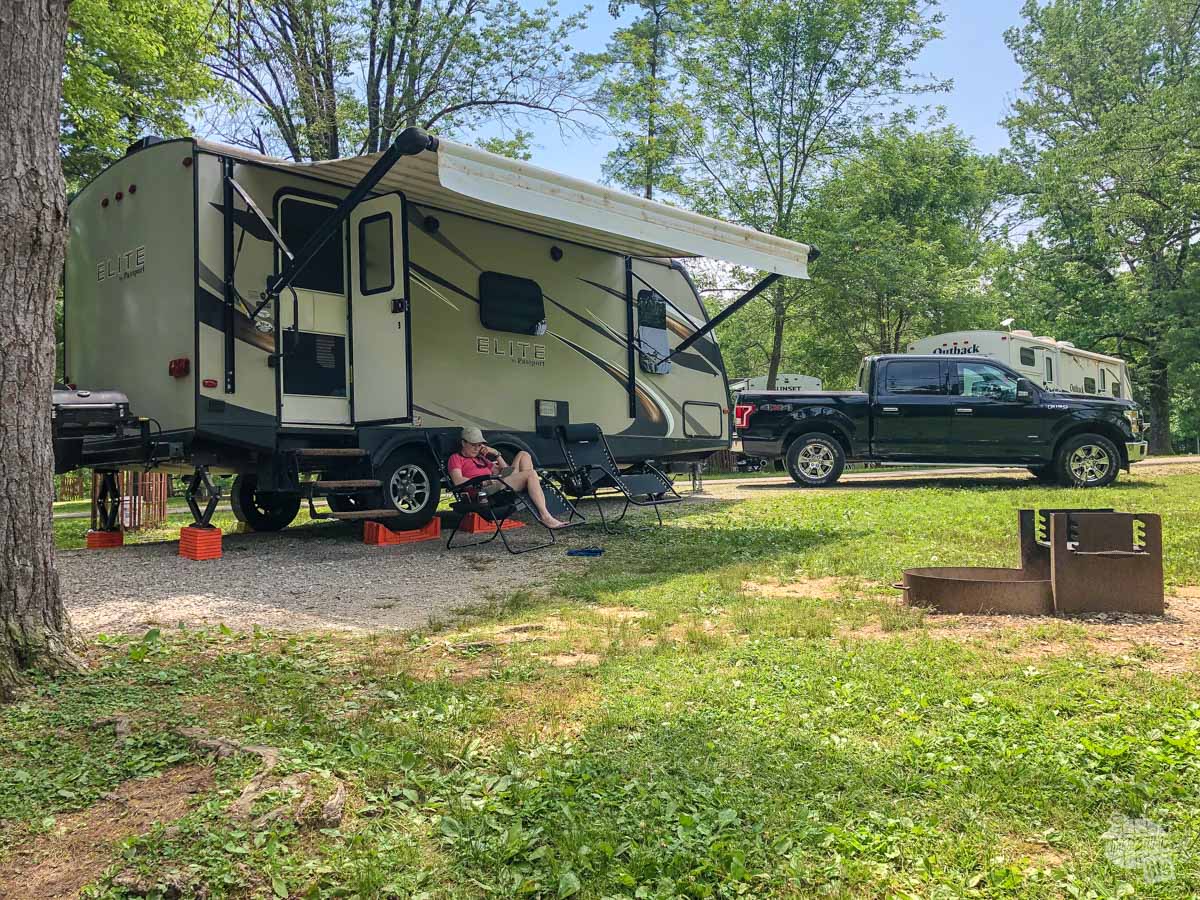
Once you are level and disconnected from the truck, connect the electrical. We use a power management system (basically, a surge protector for RVs) and that takes a couple of minutes to allow electricity through. Make sure the system is reading no errors before you get too invested in the site. We have had to move a couple of times because there were electricity issues at the campsite.
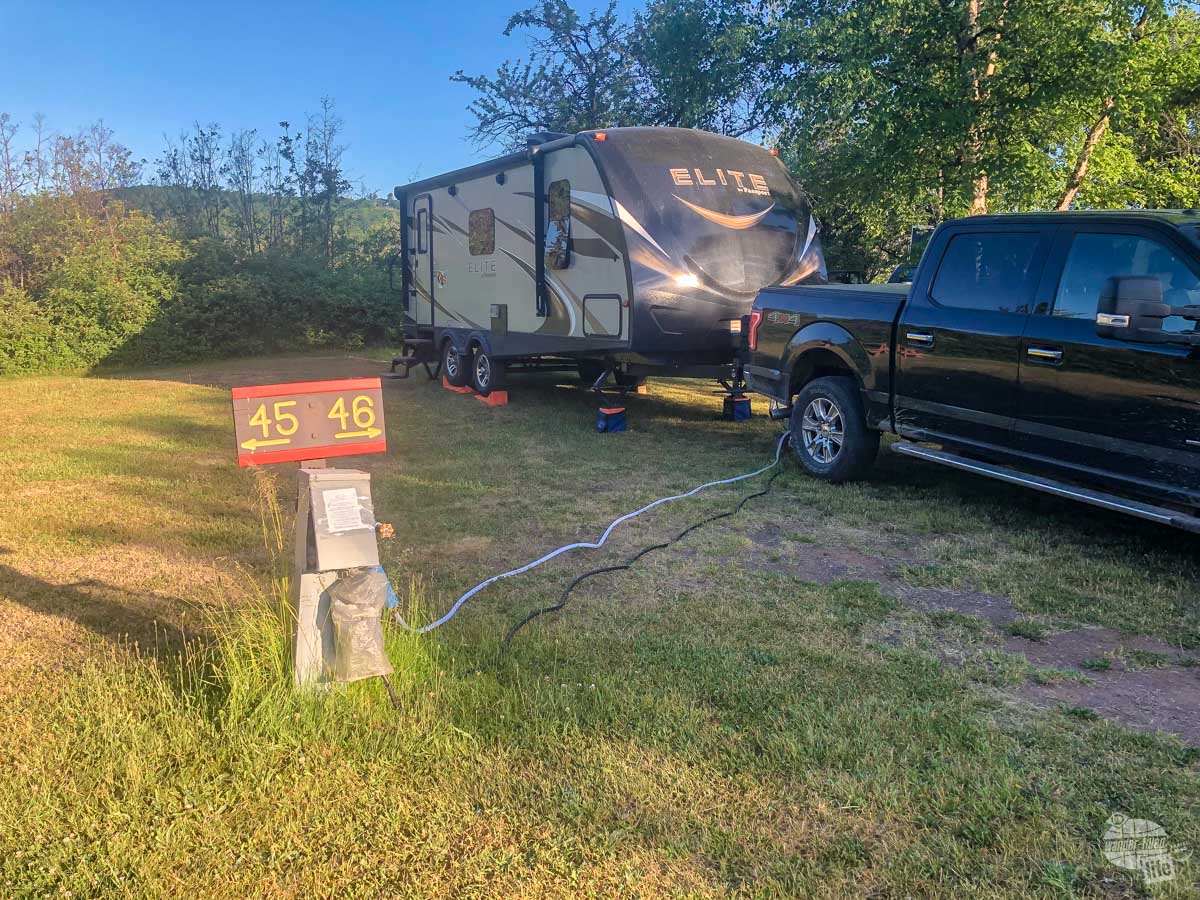
Pro tip: Put on gloves when working on the outside of the camper. That will keep your hands a lot cleaner when dealing with greasy stuff and the sewer connection.
Bonnie and I typically divide our efforts at this point, with her taking care of everything inside and me taking care of the stuff outside.
Once you connect the electrical, then connect the freshwater. Our camper is only designed to handle 45-55 PSI. We use a pressure regulator and a water filter to make sure our pipes are not damaged and the water tastes good.
Pro tip: Don’t forget to switch the bypass valve for the hot water heater to allow water to flow into it the first time after the camper has been winterized. Turning on the hot water heater without water in it can damage the heater.
Chances are, the dealer winterized your travel trailer before you bought it. You will need to flush the antifreeze out. Just keep the water flowing until it is clear. If the dealer used an air compressor to blow out the lines, you may need to keep the water flowing until all the air is out of the lines. You will need to do this on all of the sinks, shower and toilet.
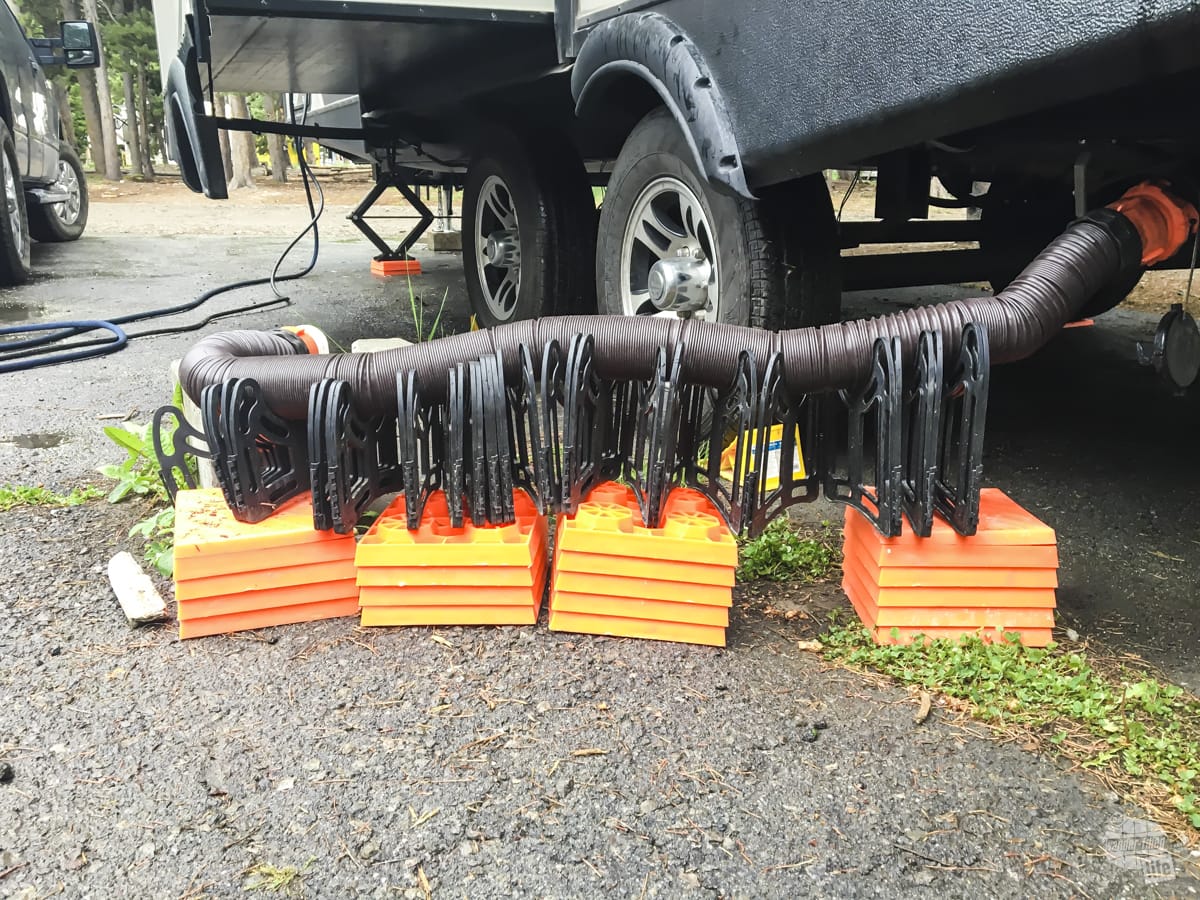
Next, it’s time to connect the sewer. The hose rotates on and should stretch to the sewer connection at the site. Be sure to use a screw-in adapter or a donut to prevent foul smells from leaking out of the sewer lines. Use a hose stand to keep the water from the tank flowing easily.
Now, it’s time to drop the stabilization jacks. These work to prevent the camper from rocking too much as people move in it. We use a cordless drill with a scissor jack adapter to put ours down quickly.
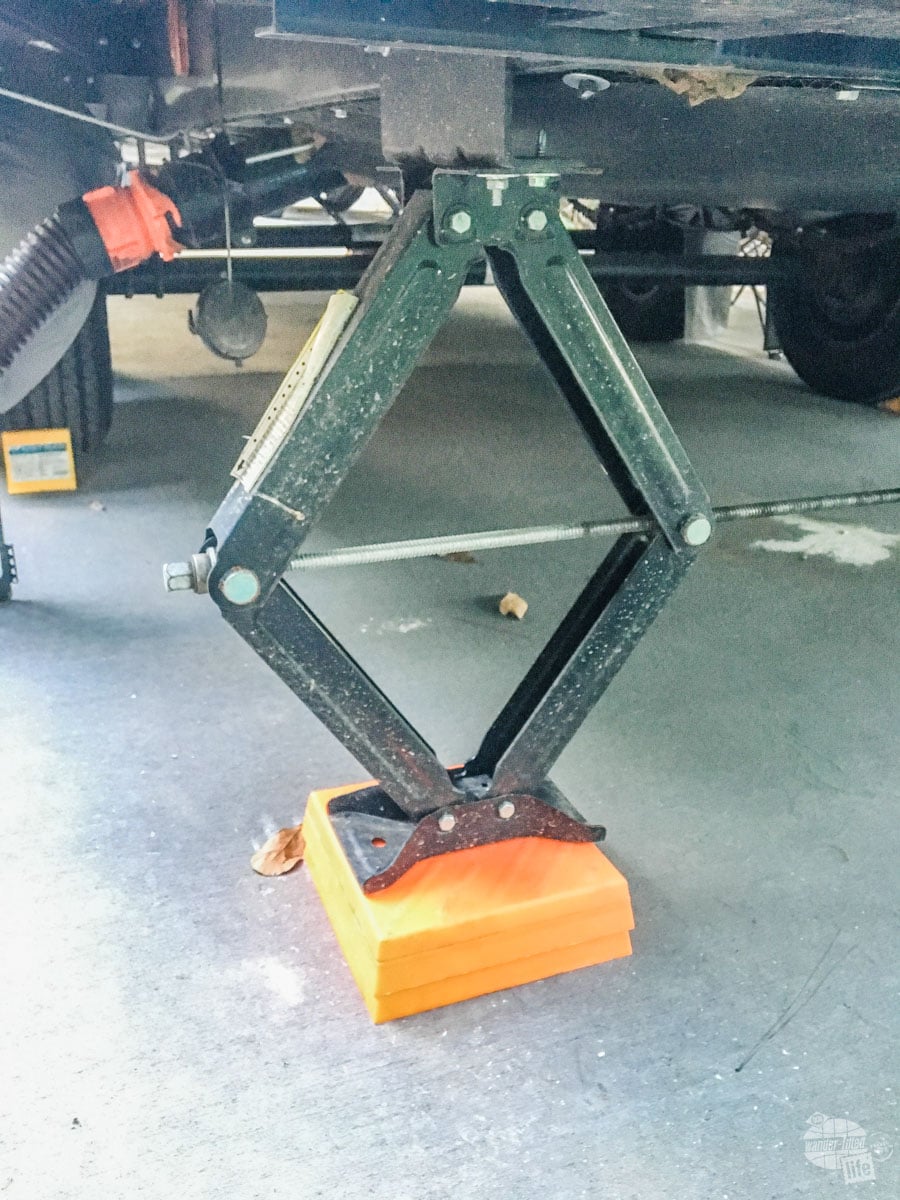
Some travel trailers come with automatic leveling jacks. Those are pretty cool but they are pricey, too.
Now, your trailer is set up. You may need to move a couple of things around on the inside, put out slides or generally get things shifted from storage to use, but that does not involve any complicated steps.
If you have a cable connection at the campsite, you can plug in your cable or you can raise your antenna to see what broadcast TV you can get.
Typically, this takes us around 20 minutes but we have been doing it a while. It will take you more time the first few times, but you will get the hang of it.
Now, it’s time to get out camp chairs and enjoy a cold beverage!
Leaving a Campsite
When you’re ready to leave you have to take down everything you set up when you arrived. No one ever said RVing was easy.
Start by putting on some rubber gloves. You will need them.
Once everything requiring water is taken care of on the inside, you can start draining the tanks. You will want to drain the black water tank first.
While I am working outside, Bonnie works on the inside to make sure everything is put away and ready for travel. She also pulls out the trash and leaves it out for me so I can dispose of my gloves and any shop towels I use.
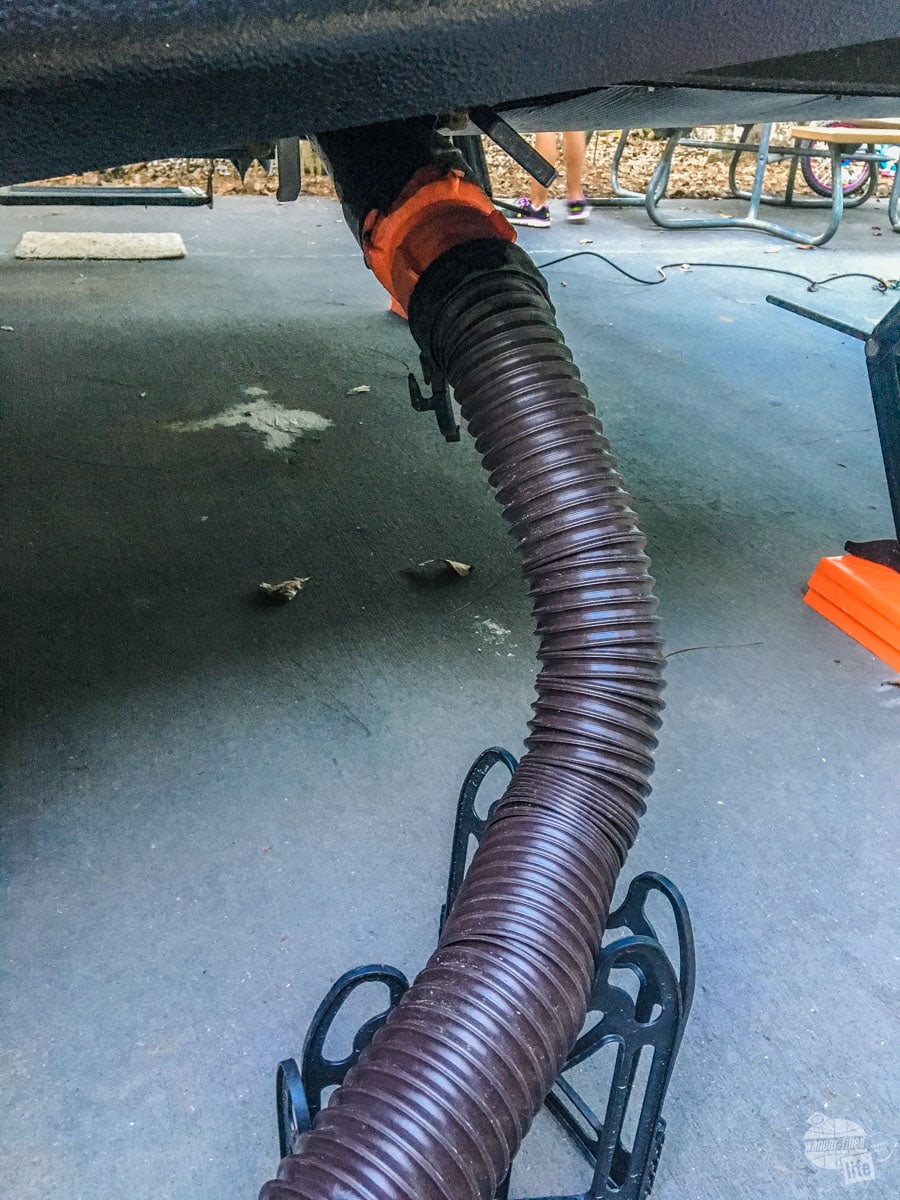
While the black water tank is draining, you can take care of other items, like putting the hitch on the truck or putting away camp chairs.
Once the black water tank has finished draining, you close that valve and drain the gray water tank. You want to always drain the foulest tank first, then rinse with less nasty water, then finally rinse with clean water… more on that in a moment.
While the gray water tank is draining, disconnect the freshwater hose and put it away. Then attach your utility hose. Once the gray water tank is drained, use your utility hose to flush your sewer hose then put the sewer hose and stand away.
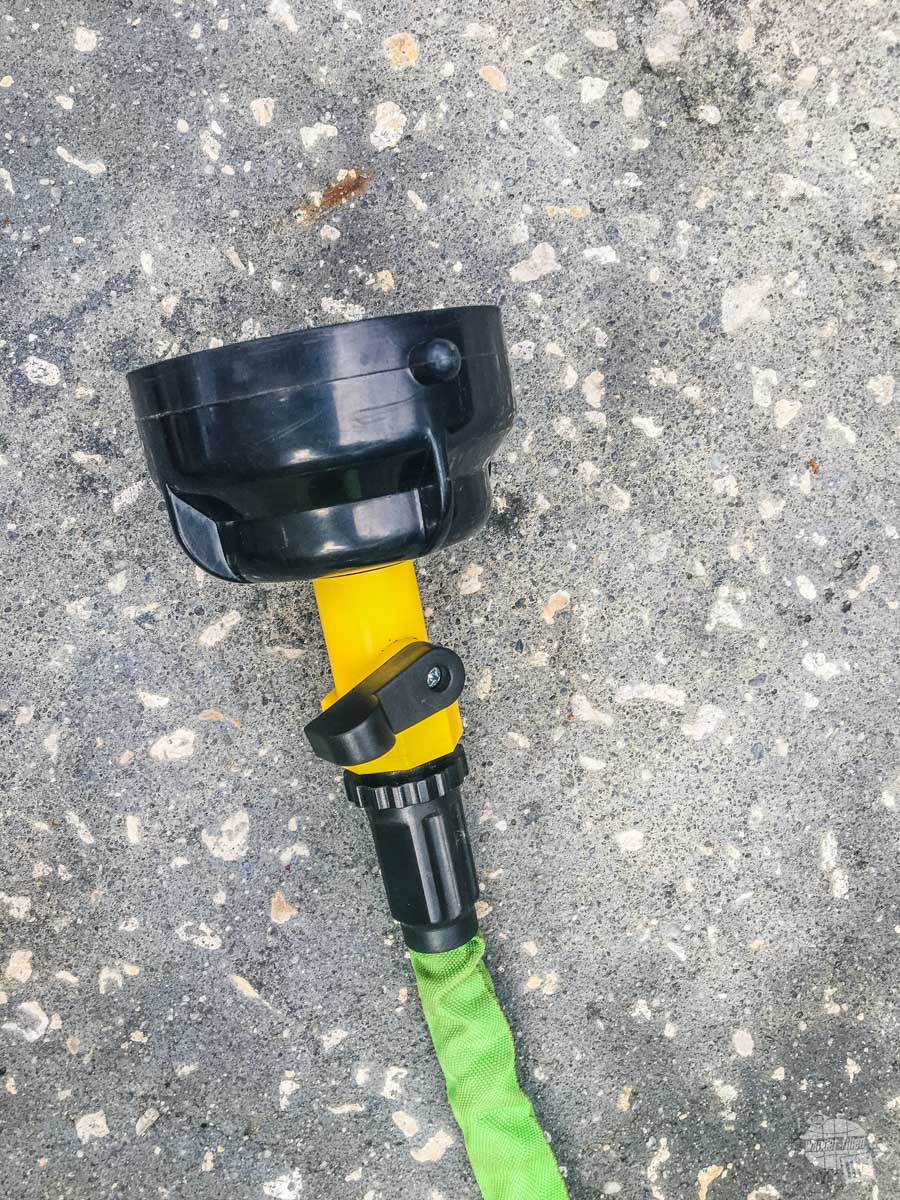
Pro tip: Do not use your freshwater hose for anything other than fresh drinking water. Additionally, store it in a separate bin from anything related to the sewer, like the utility hose.
Once everything is done on the inside and any slides are in, you can disconnect the power connection and then retract the stabilization jacks.
It’s now time to reconnect the travel trailer with the truck. Then, move off the levelers and get everything put away in the pass-throughs.
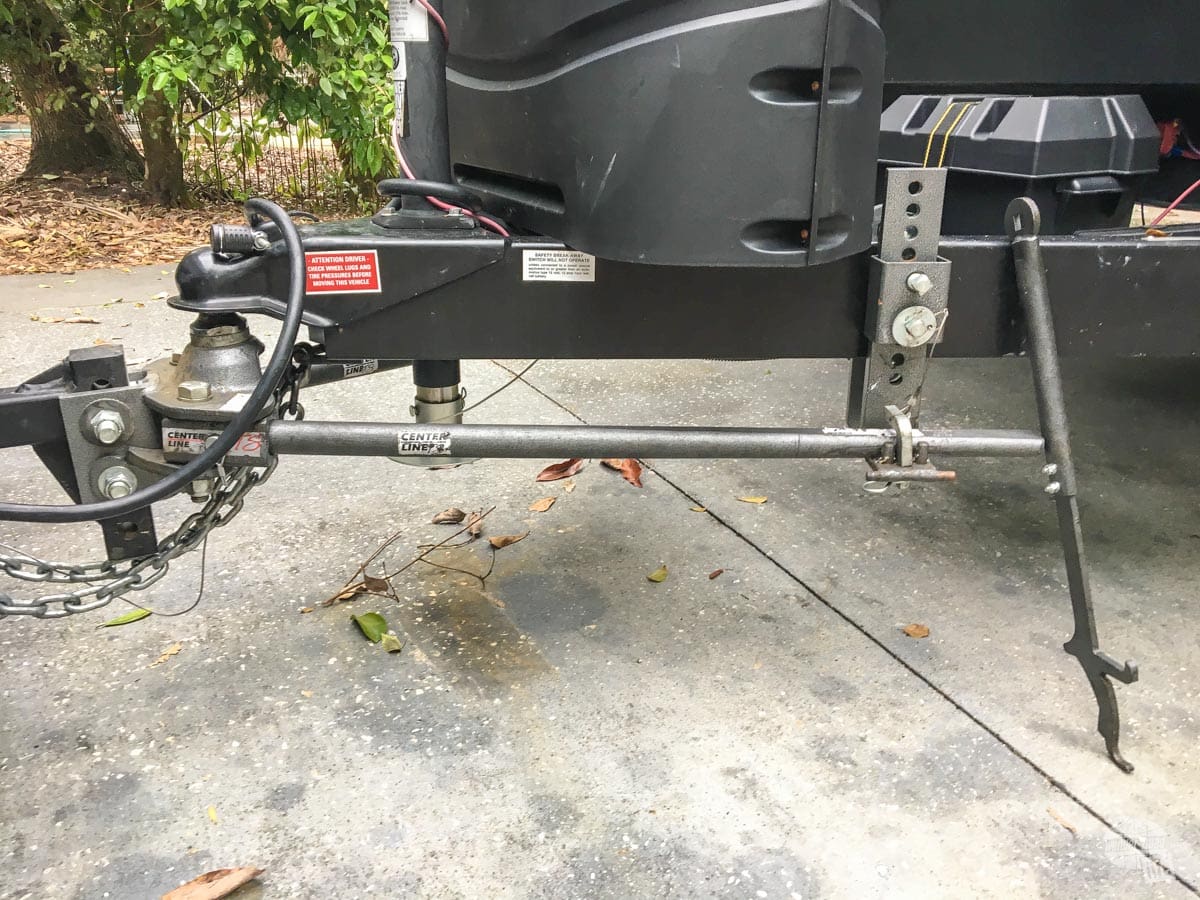
You are now ready to do the walk around on the camper, making sure everything is put away, locked up and ready for travel. Be sure to check those brake lights and the TV antenna one more time before you leave.
This typically takes us about 40 minutes. Then we visit the bathroom one last time and hit the road!
Final Travel Trailer Tips
Don’t let this long list of travel trailer tips discourage you. Yes, there is a learning curve to owning your first travel trailer. Yes, it’ll certainly be difficult and frustrating at times, especially in the beginning. And there is no doubt that you’ll make mistakes along the way. That’s true of most anything that you are new to.
Still, it’s a wonderful lifestyle and a great way to explore the world around you. With time, you’ll figure out what you’re doing and soon you’ll be the veteran and will share your travel trailer tips with a beginner.
Every year, we get better at RVing. With experience, the little things like winterizing the camper or handling small emergencies get easier.
I am heartened when I look back on how much easier the basic tasks are now. Owning a travel trailer may be a bit difficult to manage at first, but once you get the hang of it, it is a lot less stressful. And those tasks that took forever at first are second nature and finished with ease.
We hope this travel trailer guide takes some of the guesswork out of how to deal with a camper and what to expect when you first start out.
We invite you to join our Facebook group, US RV Trip Planning + Itineraries . This group is for experienced, newbie and wannabe RVers to discuss RV itineraries, destinations, camping tips and more.
Travel Resources
What do you use to find a flight.
We use Skyscanner to find deals on flights. Skyscanner has a great interface and compares tons of airlines for the best pricing and routing. That said, it does not always have every airline and some airlines will have better deals on their website. Still, Skyscanner is a great place to start. Click here to search for a flight.
What do you use to find a hotel?
We typically stay at Hilton properties , so we use the Hilton website . You can find good Hilton Honors discounts or AAA discounts for a hotel there. We make great use of our free night certificates from our Hilton Honors American Express. Click here to book a Hilton property.
If there are no Hilton properties available, we use TripAdvisor to read reviews and book the hotel. We find we can get the best price that way. Click here to search for a hotel.
We recently partnered with Stay22 to add interactive maps to each of our destination posts. This will allow you to see a plethora of hotels and vacation rentals all in one responsive map of the area.
What if I need more space than I can get at a hotel?
We use Vrbo for the times when we have rented a cabin for a weekend getaway, like this cabin in Townsend, TN , or needed to rent a house for a large family vacation. We had a great experience with them in terms of refunding deposits when COVID hit and will continue to use them. Click here to search for a vacation rental.
Who do you use for rental cars?
As a general rule, we book with Hertz for rental cars. We have had nothing but good experiences with them. Plus, we really like unlimited mileage and not worrying about crossing state lines. We have even rented from Hertz overseas in both Slovenia and Croatia . Click here to book a rental car.
How about booking a cruise?
We have found some amazing prices for booking a cruise through Cruise Direct . We have saved a lot of money on our cruises compared to what we found elsewhere, making a last-minute Bahamas cruise even cheaper. Click here to book a cruise.
What if I want to rent an RV?
We highly recommend Outdoorsy for RV rentals. We rented a camper van for a week to visit Rocky Mountain National Park for the elk rut and Custer State Park for the Buffalo Round-Up and had a blast. The program was easy to use and we really enjoyed the freedom of having a camper van for that trip. Click here to rent an RV.
What do you use for booking tours?
We don’t often book tours. Typically, we like to do stuff on our own. That said, there are some experiences you can’t have any other way. So, when we do want to book a tour, we always check Viator first. Click here to book a tour.
Do you use anything to get discounts on the road?
We make extensive use of both Good Sam and AAA on the road. Good Sam is normally regarded as a discount card for RVers at campgrounds and Camping World but anyone can use the 5 cents off a gallon at the pump at both Pilot and Flying J. Click here to get a Good Sam membership. We have had AAA as long as we have been married and it has more than paid for itself in discounts at hotels, aside from the peace of mind of having roadside assistance. Add in paper maps and the ability to get an international driver’s license and it is more than worth it for any traveler out there. Click here to get a AAA membership.
18 thoughts on “Travel Trailer Tips for Beginners”
Thanks for sharing this information. We have watched many YouTube videos and read multiple blogs in preparation for our first camping adventure in our new HTT this upcoming weekend. I feel more confident after reading your blog. We’re camping about an hour and a half from our house at Land Between the Lakes and it’s supposed to be good weather. I’m saving your blog info to have just in case.
Coop, that is a great spot and distance for a first camping trip. We hope you have a great weekend and enjoy your camper! Welcome to a great lifestyle!
Great tips for first timers! We purchased a fifth wheel 2 weeks ago and still reading blogs and posts. Thanks for your insight!
Thanks for the feedback and glad you found it helpful. Let us know if you have any other questions.
Great tips. We are picking up our new TT in a couple of days. While we are experienced with campers and camping in general the new trailer has many features the old did not. So for your readers I would say, you will never stop learning or improving your processes when it come to RV’ing. Furthermore, create a checklist and follow it. Once you get into a rhythm it will be less applicable, but doing things in a slow orderly deliberate manner will ensure your equipment stays in great shape for years to come.
100% agree!
Thought you have one of the better articles for newbies however not all campsites are full hookups. That first trip to the dump station can be a learning experience. You may want to add that for the new campers.
Thanks Debra and great idea! We will certainly add that after our next trip to a dump station to take some pictures!
Thanks for telling me that I should purchase a travel trailer that can be towed by our vehicle. My boyfriend and I are fans of outdoor adventures and we think that this is the best time to try RV camping. I’ll try to look around local auto dealers and see if they can offer us a good price for the vehicle we wanted.
Good luck, Zoe! I am not sure how much you want to be able to tow but be sure you get a truck that has a max tow package installed. That typically has a lot of the features you are going to want your truck to have, like a trailer brake controller and tow mirrors.
Loved how detailed this post is. Well done compiling this, its the complete package and I couldn’t thank you enough!
Thanks so much, Jeremy!
Hubby and I recently bought a 28 foot TT after 28 years of tent camping. Whew! Big step for us! Our first excursion will be at a nearby RV resort (close to civilization) in case we forgot anything. Your fantastic article helps to give us the confidence we need, thanks!
Welcome to an amazing community! We know you will have a great experience and we think staying local for your first trip is the perfect thing to do.
Please let us know if you have any questions going forward!
Great article lots of good tips. My wife and I just upgraded from a medium size tent trailer to a hybrid trailer. (20 feet long). We won’t be taking possession until next May as it’s going into storage for the winter. Looking forward to our first outing. I hope we can get into the US in 2022. Bathroom hook ups and water heater are going to be the biggest learning curve. Lili and Mike, Montreal, Quebec,Canada.
Thanks so much!
We hope you can get in the US in 2022 as well! We hope you enjoy your new camper!
Aloha guys, this is probably the longest amount of reading I’ve done since high school, lol. Very informative and simple to read and understand. Been doing a lot of research and we are finally ready to get ourselves an RV… Heading to camping world for the 4th time now and I am as prepared as I’m gonna be. Thanks once again! Cody Kanekoa Selman
Mahalo Cody! So glad we could help! Please let us know if there is anything more we can do to help you as you embark into this wonderful world!
Leave a Comment Cancel reply
I accept the Privacy Policy

This post may contain affiliate links or mention our own products, please check out our disclosure policy .
How To Tow a Travel Trailer [Helpful Tips]
Published on June 17th, 2021 by Ray & Tammy Roman This post was updated on February 2nd, 2024
How to tow a travel trailer is a question I often get from fellow RVers. This article will focus on four different scenarios for towing a travel trailer. The initial section will concentrate on what to do if this is your first time towing one.
This is followed by towing smaller travel trailers, larger travel trailers, and towing a travel trailer long distances. Each section will give you some tips for a successful adventure with your travel trailer.
This is very rudimentary information since towing can differ from RV to RV. Many variables are involved when towing an RV, and they differ from one RV to the next.
DON’T MISS OUT ON RV LIVING UPDATES
Sign up for the newsletter today.
Please enter a valid email address.
An error occurred. Please try again later.

Thank you for subscribing to the RV Living newsletter, keep your eye on your inbox for updates.
Things such as RV weight, how you packed your gear, road conditions, and wind, among others, can affect your towing capabilities. Seek the advice of your dealer for best practice.
Towing a Travel Trailer for the First Time
If you have never done this before, this section is for you. If you follow these tips, you should not have any trouble.
Before you even purchase the travel trailer, you must ensure it is a good fit for the vehicle used in the towing process. If the trailer is too big, it will never work.
Remember when you initially purchased the vehicle if you have always wanted to tow a good-sized travel trailer.
Ask the salesperson how much of a towing capacity the prospective vehicle can handle.
You can also use this handy calculator created by Explore USA.
Enlist the help of a friend, preferably a friend with more experience in doing this. Not only can he or she help with the tricky parts, but it can also be more fun to have a friend along.
Your friend can assist in checking everything on the trailer before setting out on an adventure. Check all tires, the backup system, and the braking system. If possible, do a trial run to check the sway ratio of the trailer when hooked up to the tow vehicle.
Towing Smaller Travel Trailers
This makes a life of adventure more plausible, as smaller campers can successfully be pulled with many larger SUVs. Ford, Nissan, and Toyota also make suitable vehicles to tow medium-sized trailers under 30-feet. With a smaller camper, you may need to bring some tents to sleep in instead of being able to do that in the trailer. But towing a smaller travel trailer can be done much more easily than a larger trailer.
Is anyone towing a 30ft Classic with a Toyota Tundra, and if so what are your thoughts on its ability to tow a Classic. The 2024 Tundras have a towing capacity to tow up to 12,000 lbs. What are thoughts and opinions of towing with a Tundra. @ Jellies2d , Airforums Airstream Owners Community, “ Need Help with Tow Vehicle. “
One important tip when towing a smaller travel trailer is to load most of the cargo and camping equipment towards the front of the camper. Do keep in mind that balance is critical to the experience. Otherwise, the trailer could tip over at any point during the trip.
The other rather crucial tip is to always drive at a slower pace. This is important no matter the size of the trailer, but even more so with a small camper. You must also drive more carefully with a trailer in tow.
You must always account for that big metal movable object being towed behind you. That means driving extra cautiously for everyone’s safety.
Avoid making sudden stops, starts, and turns. As we said, you must drive carefully when towing a travel trailer behind you. Know the exact factors involved in towing a smaller travel trailer before you set out. Be smart, and you and your friend will have a great time.
Towing a Larger Travel Trailer
This is certainly possible, and many people do it. However, there are some things you ought to know. When you purchase a large travel trailer, say around 30 feet or more long, you must be certain your towing vehicle can handle it.
The larger the trailer, the bigger the towing vehicle will have to be. You have to determine that before you even set out to buy a travel trailer. Otherwise, you will wind up with a gigantic paperweight in your yard that you cannot use.
Examples of trucks that can handle pulling such weight are large-scale pickup trucks like the Dodge RAM 2500 or 3500, Ford F250 and up, and Chevy Silverado.
Once that part is taken care of and you have your travel trailer, a good tip to keep in mind is to pack light. Even though the trailer is huge, it is still possible for it to tip over during a trip if it is overloaded with weight.
Take only things you need that you cannot buy once you reach your destination. Having a travel trailer instead of a motor coach means disconnecting the towing vehicle and driving to a store nearby for supplies. You do not need to pack all that into the trailer.
Towing a Travel Trailer Long Distances
You will likely have this in mind from the start, going long distances frequently with your travel trailer. It is also something you should investigate before buying the trailer in the first place.
Be certain the one you purchase can handle frequent long trips. Your local dealer can help you pick the perfect trailer for this.
The first tip for you is to pack light. Again, do not haul anything you can buy from a local store when you reach your destination. Even if your trailer is large, the less weight you stuff into it, the better off you will be.
One thing to keep in mind is, that you want to buy a backup camera . Even if you have towing mirrors on the towing vehicle, having a backup camera is best.
The RV backup camera below is an affordable model with great reviews.
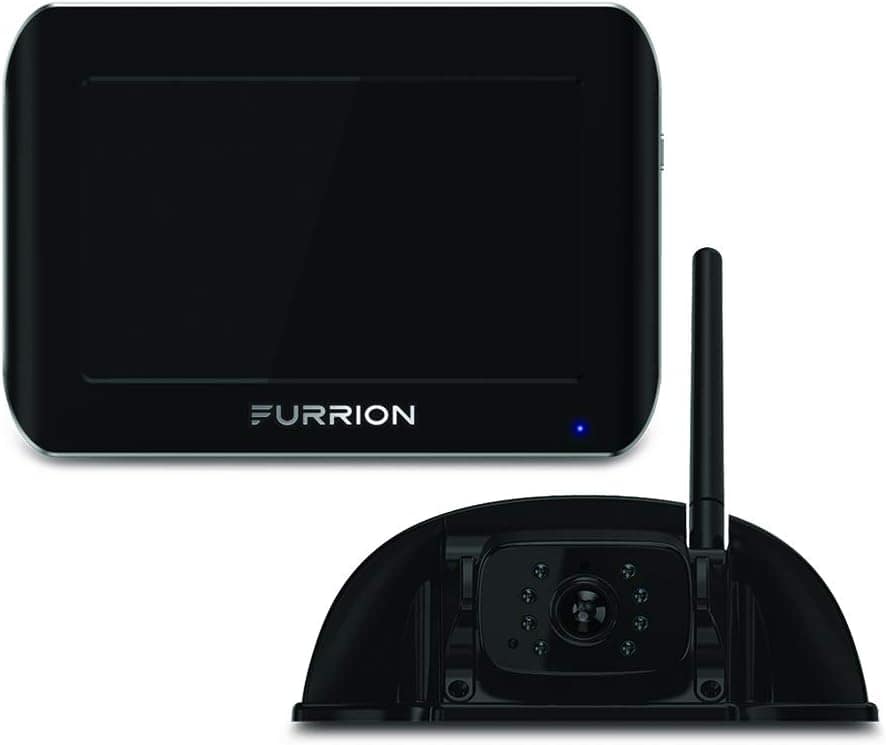
Plan the campground you want to stay in ahead of the trip. A favorite amongst folks includes Wi-Fi and sights nearby where you can partake of the food without discomfort. You will have many more activities to enjoy with a travel trailer that easily disconnects from the towing vehicle.
Traveling long distances with trailers in tow is enjoyable when you do it right. A good tip is to know the route you are taking ahead of time and avoid getting lost along the way. This will avoid unnecessary mileage on the trailer and the towing vehicle. It will also lessen the possibility of sudden stops and turns during the trip.
How To Tow a Travel Trailer Video
I want to watch a good video on how to tow a travel trailer. The video below is one of the best ones I’ve found.
How To Tow A Travel Trailer Wrap-up
Learning how to tow a travel trailer is not too difficult. Anybody can have an enjoyable experience with their travel trailer if they do it properly. We hope that this article will serve as a guide to some top scenarios and help you to have a safe trip.
If you enjoyed this post Please Share:
Related posts:.

The Best Trailer Tow Vehicle (That’s Not a Truck)

What is the Life Expectancy of a Travel Trailer?
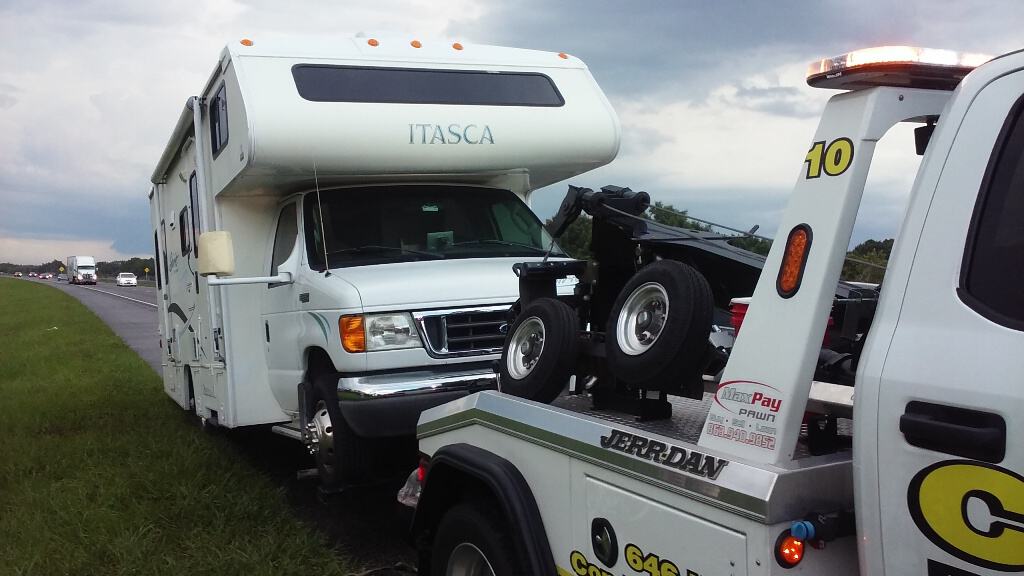
The Basics of Towing a Broken Motorhome
About the author:.

JavaScript seems to be disabled in your browser. For the best experience on our site, be sure to turn on Javascript in your browser.
- My Purchase Orders
- Compare Products

- Understanding Towing
- Ultimate Trailer Towing Guide - Chapter 1
Ultimate Trailer Towing Guide

How to Tow a Trailer Safely
10 Common-Sense Trailer Towing Tips
Towing 101 is the ultimate trailer towing guide. It is designed to equip you with the knowledge and confidence to successfully tow a trailer with your vehicle.
This tow guide is perfect for any first time trailer owner, as well as seasoned veterans looking for a refresher. It offers some of the most helpful information about trailering because it is written by industry professionals -- your very own CURT team!
Let's begin with proper trailer towing practices.

1. Choose the right equipment
Having the right tool for the job is paramount in towing. The weight capacity of your vehicle and equipment must be enough to handle your trailer and cargo load.
The size of your hitch and other components is also key to ensuring a secure fit.
Learn more about choosing the right towing equipment or look up your vehicle to find a receiver hitch .

2. Hitch up your trailer correctly
Before towing, make sure you have followed the proper procedures for hooking up your trailer. Double check all connections, including the coupler and wiring, and make sure your safety chains are crossed under the trailer tongue and securely connected.
Learn more about how to hook up a trailer .

Sick of Fighting Your Coupler?
Traditional coupler latches can be one of the biggest causes of stress when hooking up your trailer.
QuickPin™ doesn't have a latch! Instead, this revolutionary coupler uses a single pin for stress-free hookup!
See how it works
3. Allow plenty of stopping distance
You need to increase your following distance when towing a trailer. This means increasing the amount of space between you and the vehicle in front of you. It takes longer to stop with a trailer than it does with your vehicle alone.
Also, it will help prolong the life of your vehicle if you can avoid sudden acceleration, braking and maneuvering.

4. Anticipate problems ahead
The leading cause of accidents both in towing and in normal driving situations is driver error. Some of the main reasons people get into accidents is because they are not paying attention, they are driving too fast, they are tailgating the person in front of them and so on.
Since it takes longer to accelerate, stop, change lanes and turn with a trailer, scan the road ahead farther than you normally would. You can see many problems developing a long way off.
Observe traffic flow and be ready to react if needed.

5. Watch out for trailer sway
Crosswinds, large trucks, downhill grades and high speeds can all lead to trailer sway. If you are not careful, your trailer can start swinging back and forth like a pendulum behind you. The best way to address this problem is with some kind of hitch stabilization device .
If you experience trailer sway, you can also take your foot off the gas and manually apply the trailer brakes with a brake controller. Press the button once and your trailer should align with your tow vehicle.
Learn more about how to use a brake controller .
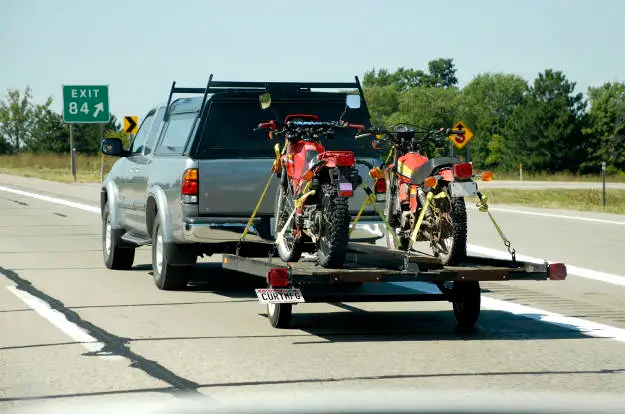
6. Be extra careful when changing lanes
Changing lanes on a highway is a challenge, even when you’re not towing. With a trailer, your blind spots increase, and you can't accelerate as quickly. When changing lanes with a trailer, make sure you have plenty of space and move slowly from one lane to the other.
You can also install tow mirrors to increase your view.

7. Be patient when passing
While towing, you have to allow more distance and time when passing another vehicle or being passed by a vehicle. Passing on a two-lane road should almost never happen. Make sure you have plenty of room to get your vehicle safely up to speed with the trailer in tow.
When being passed by another driver, be patient and remain calm, even if they don't return the favor.
Relax! You'll reach your destination soon enough!

8. Stop gradually whenever possible
Towing a trailer requires extra work from your brakes. You can help prolong the life of your vehicle and trailer brakes by easing into stops as much as possible. Anticipate stops and begin braking sooner than normal.
It is also important to keep your trailer brakes properly adjusted and your brake controller calibrated .
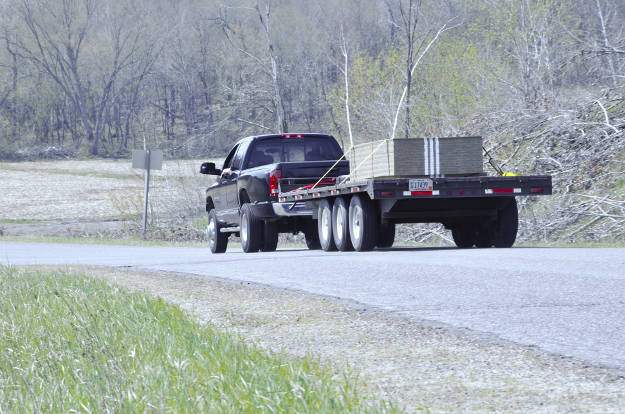
9. Don't drive in if there's no way out
It is easy to get stuck or blocked in with a trailer. For example, you might pull into a small parking lot easy enough, but to get out, you'll have to perform a complicated backup maneuver.
Make sure wherever you pull into that there's plenty of space to make a complete turnaround. Choosing a parking spot that's farther away may be the best option.

10. Keep your towing setup secure
Trailer theft is a serious problem and is always unexpected. A trailer left unattended on its own or even coupled can easily be uncoupled and stolen while you are away.
Use a trailer lock to keep your coupler protected against theft and a hitch lock to keep your trailer hitch secure.
Learn more about how to choose the best lock .

Towing a Trailer Tips!
Throughout this tow trailer guide, look for our Towing Tips! These snippets of advice are helpful for the first time trailer owner and seasoned towing professional alike. Plus, they're free!
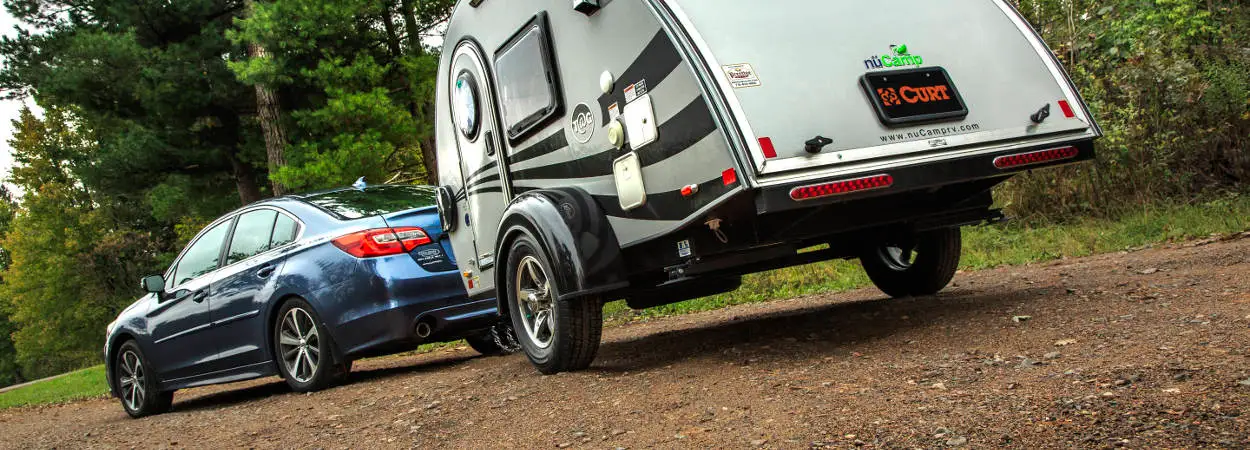
Towing a Trailer for the First Time
Perhaps you, like many drivers, are reluctant to tow a trailer. When towing a trailer for the first time, things may feel heavier, slower and unfamiliar behind the wheel. However, even though several aspects of your normal driving experience may change, trailering does not need to be stressful. In fact, with the proper know-how, towing can become as comfortable as normal driving.
Whether you're pulling a travel trailer for the first time or simply hitching up a cargo carrier, it is important to be prepared. This is hauling 101! Consider the following questions about your own specific towing situation.

1. What will you be towing?
First, you should know what kind of trailer you plan to tow. Will it be a utility trailer, boat trailer or maybe something heavier, such as a travel trailer? Knowing your trailer weight is essential for safe towing.
Based on your trailer type, will you need a receiver hitch or a heavy-duty 5th wheel or gooseneck hitch? Also does your trailer have its own set of brakes?
Learn more about hitch types here and trailer brakes and controllers here .
Be sure to think through all factors before towing any type of trailer.
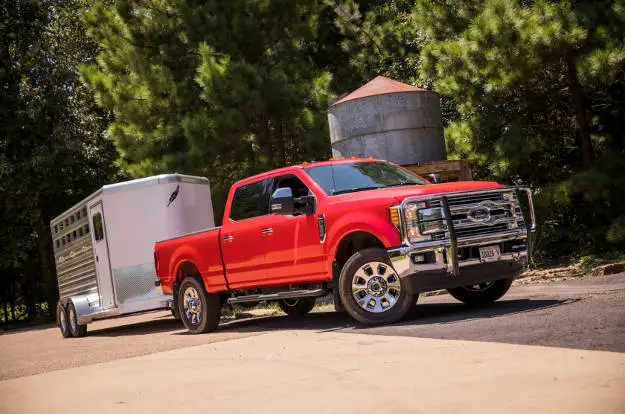
2. How will you be towing?
What kind of vehicle will you be driving? Will you be towing with a heavy-duty pickup truck or a small passenger car? Does your vehicle have a factory tow package or will you need to install your own towing equipment?
Each vehicle has different capacities, and each may require different equipment to tow safely and legally.
Learn more about installing a hitch here and towing capacity here .
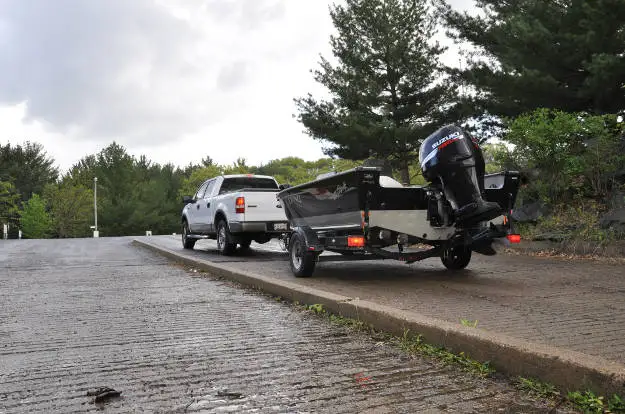
3. Where will you be towing?
Successfully towing a trailer also depends on the distance and road conditions along your route. For example, towing a utility trailer across town is one thing; towing a large 5th wheel trailer to a remote destination is something else.
It is likely that you will tow different trailers with the same vehicle. You will need to consider how best to equip yourself for these changes.
Learn more about different types of towing here.
Additional Towing Help
The information in Towing 101 will help answer all of the basic questions about towing a trailer. You can move through the guide one chapter at a time or jump directly to a specific topic of interest.
For help beyond the towing basics, please know that the CURT team is always here for you. You can send us a message or call our Product Support team any time during normal business hours!

Towing Specific Types of Trailers
How to tow a boat trailer.
Towing a boat trailer is very much like towing any other trailer. Boat trailers, even with a boat in tow, are relatively lightweight, unless you are towing a yacht or pontoon boat. Whatever the case, the same rules apply. Stay alert, be patient and drive carefully.
When towing a boat, it is important to secure the boat before travel. You may need to invest in the right hand winch to pull the boat onto the trailer. Also, make sure you drain water from the live wells and any other reservoir before driving away.
Need help launching?

How to tow a travel trailer
Towing a travel trailer has its challenges and advantages. Travel trailers are relatively larger trailers, and larger trailers can be easier to back up with.
However, large trailers create more wind resistance and usually weigh more. Make sure your vehicle is equipped with the right weight distribution hitch and sway control before towing.

How to tow a utility trailer
When towing a utility trailer, you will need to be conscious of your cargo. Follow the common-sense rules of hitching up correctly , driving carefully and being patient.
If you are towing an enclosed utility trailer, make sure items are secure even with the door shut, especially heavy cargo. If you have an open utility trailer, tie down all cargo with ratchet straps before travel.
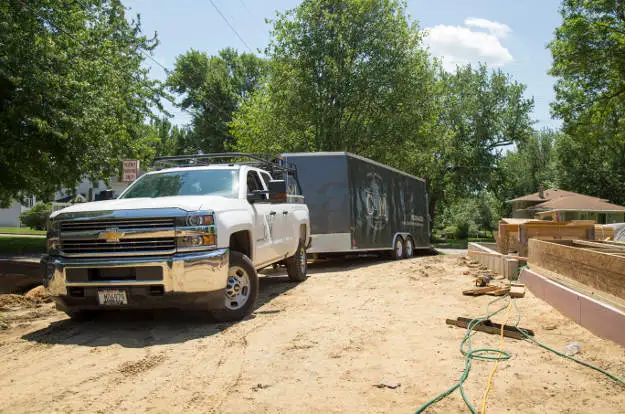
Not sure where to start? Look up your vehicle to find a custom hitch !
Towing 101 Table of Contents
Looking for more.
Discover more great tips and how-tos on the Lippert blog -- your destination for all things RVing, towing, boating and beyond!
Stay Prepared with this First-Time Travel Trailer Owner Checklist
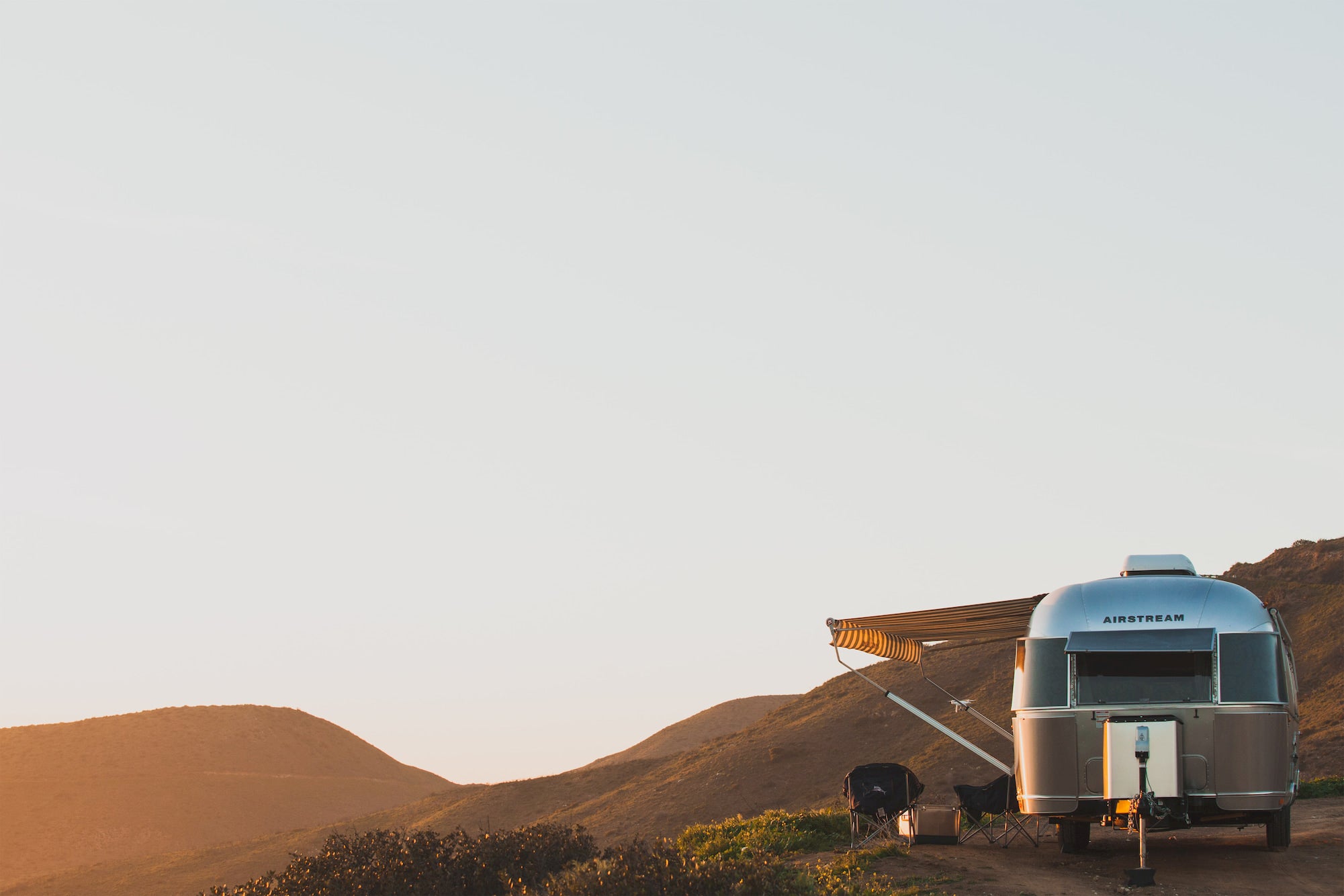
If you just bought a travel trailer, you’re probably dreaming of waking up next to a coastline or camping among the crimson hues of the Utah desert. Making blueprints for the next adventure is exciting, but before you hit the road, you’ll need to stock your new travel trailer with all of the essentials to ensure you are prepared for your next big trip. Check out this travel trailer checklist to stay prepared and organized for your next big adventure.

1. Essentials to Keep Your Travel Trailer Running
While you’ll make a lot of fun purchases for your new travel trailer, a quality travel trailer checklist has to include the items that keep your trailer up and running. The following items are essentials to purchase along with your new travel trailer so that it functions at its best.
A Generator – A generator is an obvious item for this checklist, but you’ll want to buy one that’s high quality and will last. Check out the Champion Generator.
2 and 5/16″ Trailer Ball – Make sure to have the right size trailer ball installed on your vehicle to tow your trailer.
3/4 Drill Socket and Drill – Drills will allow you to easily put up and take down your jack stands.
Water Pressure Regulator – Some RV campgrounds have too strong of water pressure. There are plenty of water pressure regulators out there, but Camco makes a great option.
Water Tank Filler Valve – This valve attaches to the end of a house and the other end goes into the fresh water intake on your trailer. This makes it easy to fill your fresh water tank.
Gas Can – This one may seem obvious, but you might need a new one dedicated to your trailer. A 5-gallon bucket will help you keep your generator running for hours. 2 gallons will typically keep the generator running for 8 hours.
Sewer Hose – Getting rid of the black water in your travel trailer or RV isn’t fun, but if you have to do, you’ll need a quality sewer hose.
Leveling Blocks – When setting up your site at a campground, you’ll want to make sure your travel trailer is level. Leveling blocks help make your experience comfortable and prevents your coffee from sliding off the table.
Drinking Water Hose – You’ll want a fresh water hose to get city water into your trailer or fill the fresh water tank. Make sure your hose is lead free so it’s safe for drinking.
2. Essentials for the Inside of Your Trailer
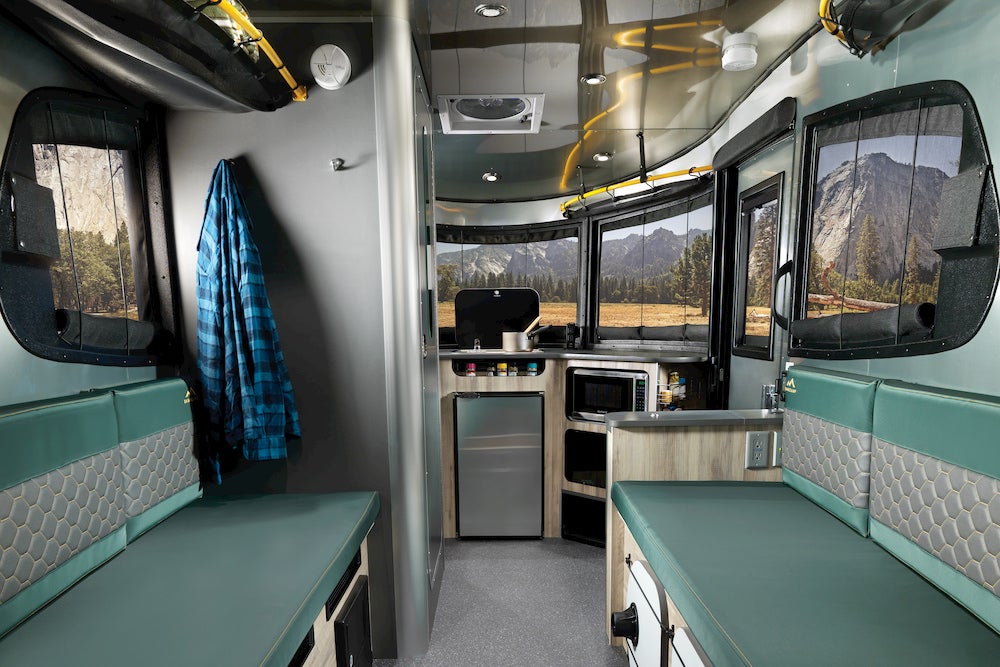
Once you’ve got some basic equipment to keep your RV up and running, it’s time to fill the interior with must-have items so that living on the road feels as cozy as days at home.
Bed and Bed Sheets – One of the most highly recommended beds in the travel trailer world is the Zinus Deluxe Short Queen Memory Foam . Pair it with a cozy pair of sheets and you are ready for a great night’s sleep in the great American wilderness.
Laundry Hampers – Laundry hampers are a great way to keep laundry organized. You don’t want your dirty clothes floating around the trailer.
Small Vacuum – Although space is limited, you’ll still want to make room for supplies that keep your trailer clean. A handheld vacuum will help you keep tidy and doesn’t take up much space.
Hanging Closet Organizers – Hanging organizers stay out of site, but keep shoes, and other items organized.
Coffee Maker – There are so many high quality coffee makers out there. We recommend the Bialetti pour over – it makes great coffee and doesn’t need electricity.
3. Essentials For The Exterior of Your Trailer
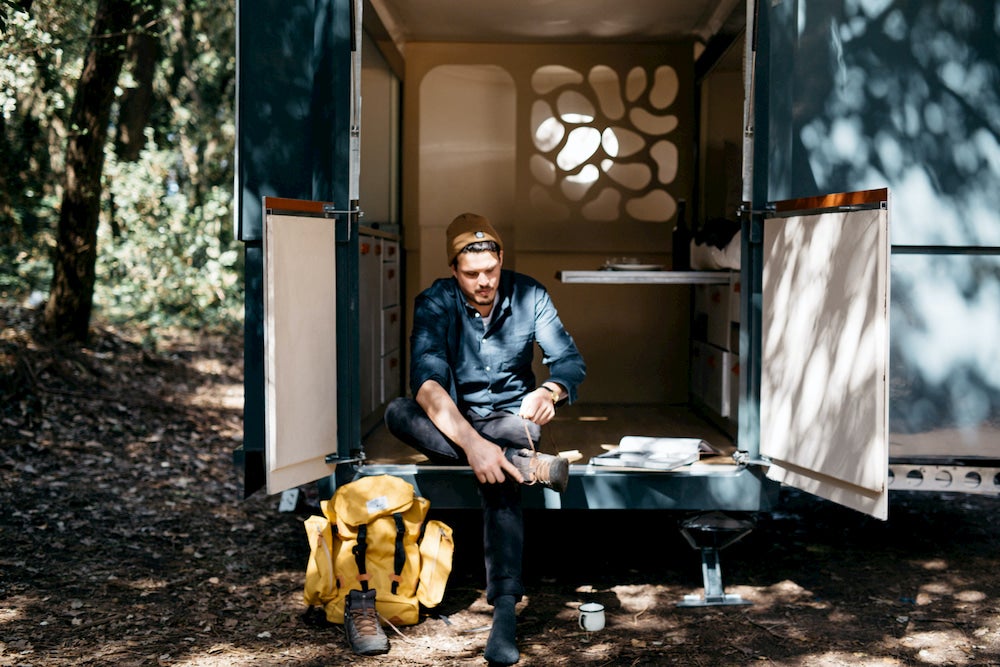
These travel trailer checklist items include accessories for the outside of your travel trailer that can enhance your experience. They may not be entirely essential, but they come highly recommended from seasoned travel trailer owners.
Mat for Outside Steps – You’ll want a doormat to keep outside of your trailer to prevent dirt from coming in.
Hammock – A hammock for reading and resting when at the campsite easily enhances your experience. La Siesta has some fantastic and affordable hammock options.
Portable Propane Fire Pit – Maybe this one isn’t essential, but portable fire pits make for some cozy summer nights under the bright stars, right outside your travel trailer.
4. Technology

Every travel trailer checklist should include some devices that help ensure you are staying on route and staying connected so you can spend your time thinking about the exciting things to come, rather than worrying about getting lost or not being able to get work done on the road.
GPS – Having a GPS frees up your phone and keeps you on route. This Garmin GPS provides warnings about steep grades, sharp curves, weight limits and more.
WiFi Booster – WiFi boosters make your internet connection stronger, which can be especially helpful if you work from your travel trailer.
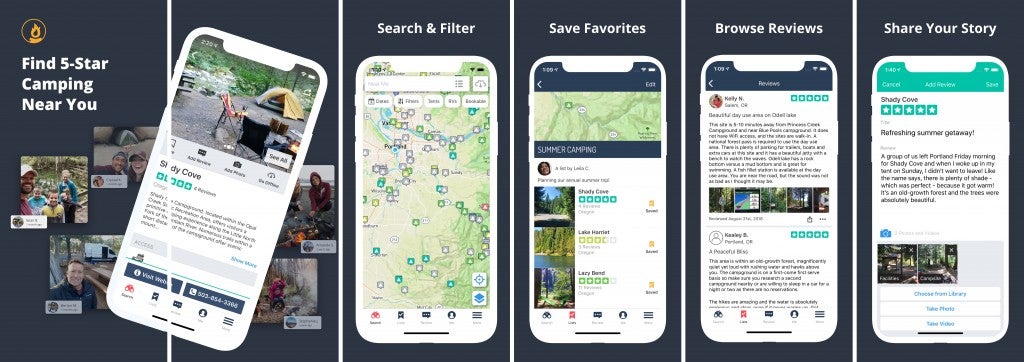
Safety is a top priority when you’re on the road, especially if you are far away from any town. You’ll want to make sure you have these items to guarantee your safety.
First Aid Kit and Tool Box – Having a first aid kit and tool box will assist you in case of emergencies. If you can’t reach a hospital immediately or your RV is having issues, you’ll want to have a back up plan.
The Dyrt PRO – The Dyrt PRO keeps you safe on the road. Find campgrounds even if you lose service and download maps ahead of time, so you have the info you need when you need it the most. A full year membership is just $29.
Popular Articles:
- Get the Latest 2024 Camping Travel Trends
- How To Find Free Camping in National Forests
- The Checklist Every First Time RVer Needs
- Find Free Camping With The Dyrt Map Layers
- The Ulimate Boondocking Guide To Free Camping
- Everything You Need To Know About Wifi For Your RV
- 7 of The Best Overland Routes in North America
- 14 Wilderness Survival Tools You Should Have in The Backcountry
- Here's What To Add To Your Primitive Camping Checklist
Emily Gallegos
Emily Gallegos is a travel-lover, backpacker and is generally curious about all this world has to offer. She grew up in the front range of Colorado where she fell in love with snowboarding, fishing and being outside as often as possible. She has studied Spanish in Spain and Argentina and has written for magazines in Boulder, CO such as Elevation Outdoors.
More Articles

Campground Recipes: You'll Devour These 6 Dutch Oven Desserts
Dutch oven desserts are a classic camping crowd-pleaser. Throw all your ingredients straight into the pot, put it on the coals, and wait (im)patiently for…

8 RV Packing Tips For Beginners
Packing for your first-ever RV trip can seem stressful. Your mind is probably running through the seemingly endless list of items you’ll need for your…
END OF SUMMER GIVEAWAY: ENTER NOW!

- VEHICLE SEARCH
- LOCATE DEALER
- BECOME AN AMBASSADOR

Towing a Travel Trailer for the First Time: 10 Things You Wish You Knew
Alex Hodschayan December 28, 2023 RV and Travel Trailer , Towing Leave a Comment
Towing a travel trailer for the first time is a thrilling adventure, but it can also be a daunting one if you’re not adequately prepared. From understanding your towing vehicle’s capabilities to selecting the right trailer, there’s a lot to consider. Let’s dive deep into the essential tips for novice trailer towers and introduce you to some valuable tools that can enhance your towing experience.
1. Know Your Towing Vehicle’s Capabilities
Before you even think about hitching up your travel trailer, it’s crucial to understand your towing vehicle’s capabilities. This goes beyond just knowing the make and model – you need to check your owner’s manual or consult the manufacturer’s specifications for precise towing capacity. Overloading your vehicle can lead to handling issues, reduced fuel efficiency, and, most importantly, safety concerns. By adhering to your vehicle’s limitations, you can ensure a smoother, safer towing experience.
2. Choose the Right Trailer
Selecting the appropriate travel trailer is essential. Your choice should align with your towing vehicle’s capacity. Lightweight trailers are generally easier to tow, but if you have a more substantial, robust towing vehicle, you can consider larger, more feature-rich models. Always confirm the weight limits and compatibility between your vehicle and the trailer to avoid any surprises or difficulties on the road.
3. Load Distribution Matters
How you load your travel trailer significantly impacts its stability on the road. Strive for a well-balanced load with heavier items positioned low and centralized. Proper weight distribution minimizes sway and makes your trailer more manageable during turns and stops. Consider investing in weight distribution hitches or sway control systems for added safety.
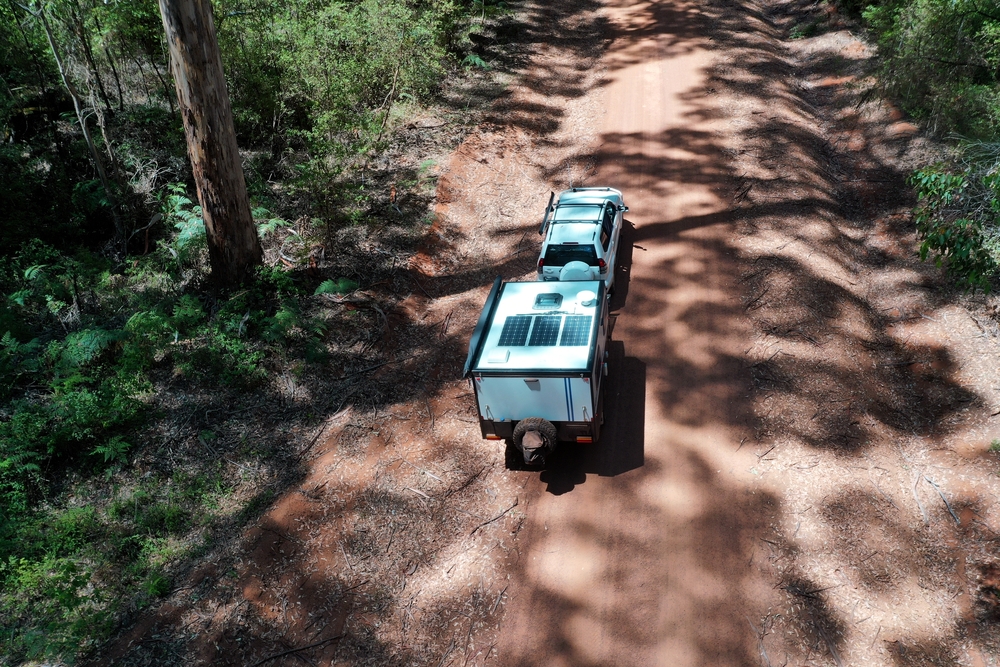
4. Practice Backing Up
Backing up a trailer can be a nerve-wracking experience for first-timers, but practice makes perfect. Find an open, empty space to hone your skills before you hit the road. Remember that when you turn the steering wheel, the trailer moves in the opposite direction. Patience and practice will help you navigate tight spots and campsites with confidence. Here are some helpful tips for backing up a travel trailer:
- Choose the Right Location: Find an open, empty parking lot or a quiet area where you have plenty of space to practice. Look for a location with clear lines or markers on the pavement to serve as visual guides.
- Get a Spotter: Having a spotter outside the vehicle can be immensely helpful, especially as you’re learning. The spotter can provide real-time guidance and watch for obstacles you might not see.
- Practice Straight-Line Backing: Start by practicing straight-line backing. This involves moving the trailer directly backward without any turns. Begin by positioning the trailer straight behind your towing vehicle. Use your side mirrors to monitor the alignment, and then slowly reverse while keeping the trailer in line. Use minimal steering adjustments to maintain a straight path.
- Use the Bottom of the Steering Wheel : When making steering adjustments while backing up, use the bottom of the steering wheel. If you want the trailer to go left, turn the wheel to the left; if you want it to go right, turn the wheel to the right. This can help you avoid overcorrections.
- Practice 90-Degree Backing: After mastering straight-line backing, move on to 90-degree backing, which is useful for parking in tight spots. Position your towing vehicle and trailer so that they form a right angle. Begin to reverse and, as the trailer starts to turn, make gentle steering adjustments to guide it into the desired parking spot. Continuously check your mirrors and adjust as needed to keep the trailer on track.
- Correcting Mistakes: Expect to make mistakes as you practice. If the trailer starts to jackknife (forming an acute angle with your towing vehicle) or go off course, don’t panic. Stop, pull forward, and correct your steering. Sometimes it’s easier to reset and start again.
- Develop Spatial Awareness: Understanding the spatial relationship between your towing vehicle and the trailer is essential. As you practice, you’ll develop a better sense of how much you need to turn the wheel to achieve specific trailer movements.
- Be Patient and Take Your Time: Backing up a trailer is a skill that requires patience and practice. Don’t rush the process. Take your time to build confidence and become more comfortable with the movements.
- Communication with Your Spotter: Maintain clear communication with your spotter. Use standardized hand signals or simple verbal commands to convey your intentions. Make sure you both understand what each signal means.
- Real-World Practice: Once you’ve gained confidence in an open area, practice backing into real-world scenarios like your driveway or a campsite. These practical experiences will help you refine your skills and adapt to different situations.
Remember that backing up a trailer is a skill that improves with practice. Start in low-stress environments and gradually work your way up to more challenging situations. Over time, you’ll become more confident and proficient at maneuvering your travel trailer in tight spots and busy campgrounds.
5. Check Your Tire Pressure
Regularly inspect the tire pressure on both your towing vehicle and the trailer. Adequately inflated tires are vital for safe towing. Proper tire pressure not only enhances handling but also reduces the risk of a tire blowout. Consult your owner’s manuals for the recommended pressure levels, and always perform these checks before every trip.
6. Plan Your Stops
When towing, anticipating your stops is essential for safety. Leave extra space between you and the vehicle in front, and brake early to avoid sudden, jarring stops. Plan your route with ample rest areas and safe stopping points, allowing you to take breaks and stretch your legs.
7. Monitor Your Speed
Maintaining a safe, steady speed is crucial when towing. Avoid excessive speed, as it can lead to sway and reduce your control over the trailer. Stay within recommended speed limits, and always adapt to road and weather conditions. Keep in mind that towing can affect your stopping distance, so exercise caution.
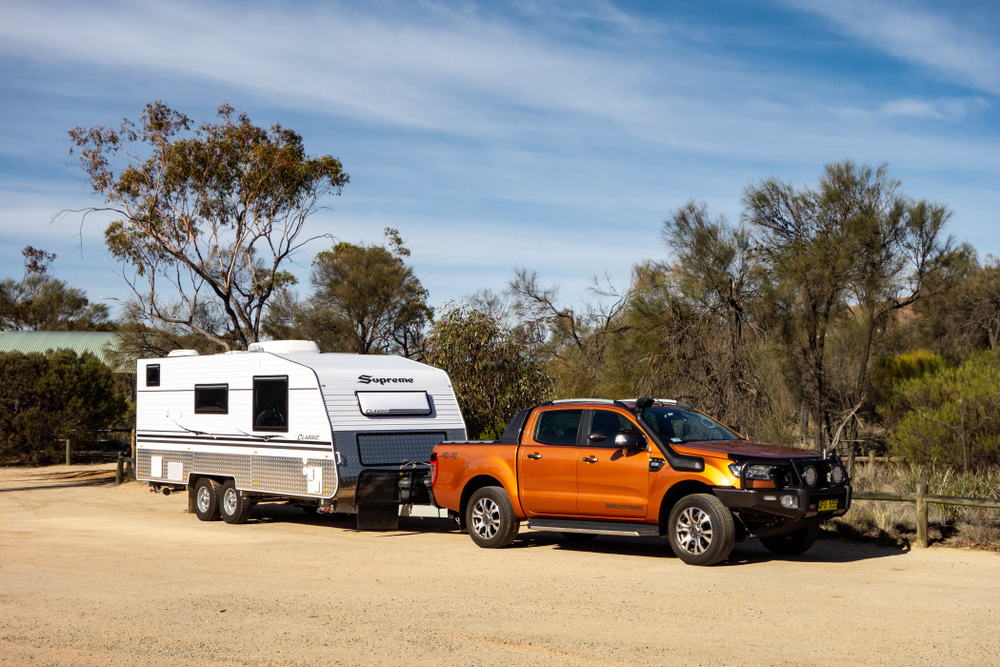
8. Use Mirrors and Stay Alert
Visibility is key when towing, so invest in extended mirrors to enhance your view of the trailer and the road behind you. Staying alert is equally important. Consistently check your mirrors to monitor traffic and the trailer’s behavior. Avoid distractions, and always stay focused on the road.
9. Invest in SumoSprings for a Smoother Ride
For an even smoother towing experience, consider SumoSprings and Trailer SumoSprings . These innovative suspension products are designed to improve stability, reduce sway, and enhance ride comfort. They work by providing progressive load support, effectively reducing bounce and jarring movements caused by uneven roads or crosswinds. With SumoSprings, your towing vehicle and trailer can operate more harmoniously, creating a safer and more comfortable journey.
10. Take It Slow
Patience is the golden rule when towing a travel trailer for the first time. Slow down, enjoy the scenery, and embrace the journey. Plan your route in advance, and allow extra time for unexpected delays or interesting detours. By taking it slow, you’ll not only reduce stress but also ensure a safer, more enjoyable experience on the road.
Sign Up for More Tips, Adventures, and Exclusive Offers
Embark on a better journey with SuperSprings International. Sign up for our newsletter to receive professional tips, product updates, and exclusive offers.
Embarking on your first towing adventure with a travel trailer doesn’t have to be intimidating. By thoroughly understanding your vehicle’s capabilities, choosing the right trailer, practicing essential towing skills, and investing in advanced suspension solutions like SumoSprings and Trailer SumoSprings, you’ll be well on your way to a safe, comfortable, and memorable journey. So, hit the open road, explore new horizons, and create lasting memories while towing your travel trailer with confidence and ease.
Leave a Reply Cancel reply
Your email address will not be published. Required fields are marked *
This site uses Akismet to reduce spam. Learn how your comment data is processed .
In your cart
Suspension for my.
- Company Name *
- Company Website
- Current SSI Contact * Tell us who you're working with... Miguel Ángel Casas Prosper Justin Coulter Martin Pring Mustapha El Moridi Rüdiger Hölzel Rosario Mangiapia Alex Hodschayan Someone else
- How did you hear about us? *
Accounts Payable Contact
- Name * First Last
- Address * Street Address Address Line 2 City State / Province / Region ZIP / Postal Code Afghanistan Albania Algeria American Samoa Andorra Angola Anguilla Antarctica Antigua and Barbuda Argentina Armenia Aruba Australia Austria Azerbaijan Bahamas Bahrain Bangladesh Barbados Belarus Belgium Belize Benin Bermuda Bhutan Bolivia Bonaire, Sint Eustatius and Saba Bosnia and Herzegovina Botswana Bouvet Island Brazil British Indian Ocean Territory Brunei Darussalam Bulgaria Burkina Faso Burundi Cabo Verde Cambodia Cameroon Canada Cayman Islands Central African Republic Chad Chile China Christmas Island Cocos Islands Colombia Comoros Congo Congo, Democratic Republic of the Cook Islands Costa Rica Croatia Cuba Curaçao Cyprus Czechia Côte d'Ivoire Denmark Djibouti Dominica Dominican Republic Ecuador Egypt El Salvador Equatorial Guinea Eritrea Estonia Eswatini Ethiopia Falkland Islands Faroe Islands Fiji Finland France French Guiana French Polynesia French Southern Territories Gabon Gambia Georgia Germany Ghana Gibraltar Greece Greenland Grenada Guadeloupe Guam Guatemala Guernsey Guinea Guinea-Bissau Guyana Haiti Heard Island and McDonald Islands Holy See Honduras Hong Kong Hungary Iceland India Indonesia Iran Iraq Ireland Isle of Man Israel Italy Jamaica Japan Jersey Jordan Kazakhstan Kenya Kiribati Korea, Democratic People's Republic of Korea, Republic of Kuwait Kyrgyzstan Lao People's Democratic Republic Latvia Lebanon Lesotho Liberia Libya Liechtenstein Lithuania Luxembourg Macao Madagascar Malawi Malaysia Maldives Mali Malta Marshall Islands Martinique Mauritania Mauritius Mayotte Mexico Micronesia Moldova Monaco Mongolia Montenegro Montserrat Morocco Mozambique Myanmar Namibia Nauru Nepal Netherlands New Caledonia New Zealand Nicaragua Niger Nigeria Niue Norfolk Island North Macedonia Northern Mariana Islands Norway Oman Pakistan Palau Palestine, State of Panama Papua New Guinea Paraguay Peru Philippines Pitcairn Poland Portugal Puerto Rico Qatar Romania Russian Federation Rwanda Réunion Saint Barthélemy Saint Helena, Ascension and Tristan da Cunha Saint Kitts and Nevis Saint Lucia Saint Martin Saint Pierre and Miquelon Saint Vincent and the Grenadines Samoa San Marino Sao Tome and Principe Saudi Arabia Senegal Serbia Seychelles Sierra Leone Singapore Sint Maarten Slovakia Slovenia Solomon Islands Somalia South Africa South Georgia and the South Sandwich Islands South Sudan Spain Sri Lanka Sudan Suriname Svalbard and Jan Mayen Sweden Switzerland Syria Arab Republic Taiwan Tajikistan Tanzania, the United Republic of Thailand Timor-Leste Togo Tokelau Tonga Trinidad and Tobago Tunisia Turkmenistan Turks and Caicos Islands Tuvalu Türkiye US Minor Outlying Islands Uganda Ukraine United Arab Emirates United Kingdom United States Uruguay Uzbekistan Vanuatu Venezuela Viet Nam Virgin Islands, British Virgin Islands, U.S. Wallis and Futuna Western Sahara Yemen Zambia Zimbabwe Åland Islands Country
- Same as Accounts Payable
- Someone else
- Name First Last
- Address Street Address Address Line 2 City State / Province / Region ZIP / Postal Code Afghanistan Albania Algeria American Samoa Andorra Angola Anguilla Antarctica Antigua and Barbuda Argentina Armenia Aruba Australia Austria Azerbaijan Bahamas Bahrain Bangladesh Barbados Belarus Belgium Belize Benin Bermuda Bhutan Bolivia Bonaire, Sint Eustatius and Saba Bosnia and Herzegovina Botswana Bouvet Island Brazil British Indian Ocean Territory Brunei Darussalam Bulgaria Burkina Faso Burundi Cabo Verde Cambodia Cameroon Canada Cayman Islands Central African Republic Chad Chile China Christmas Island Cocos Islands Colombia Comoros Congo Congo, Democratic Republic of the Cook Islands Costa Rica Croatia Cuba Curaçao Cyprus Czechia Côte d'Ivoire Denmark Djibouti Dominica Dominican Republic Ecuador Egypt El Salvador Equatorial Guinea Eritrea Estonia Eswatini Ethiopia Falkland Islands Faroe Islands Fiji Finland France French Guiana French Polynesia French Southern Territories Gabon Gambia Georgia Germany Ghana Gibraltar Greece Greenland Grenada Guadeloupe Guam Guatemala Guernsey Guinea Guinea-Bissau Guyana Haiti Heard Island and McDonald Islands Holy See Honduras Hong Kong Hungary Iceland India Indonesia Iran Iraq Ireland Isle of Man Israel Italy Jamaica Japan Jersey Jordan Kazakhstan Kenya Kiribati Korea, Democratic People's Republic of Korea, Republic of Kuwait Kyrgyzstan Lao People's Democratic Republic Latvia Lebanon Lesotho Liberia Libya Liechtenstein Lithuania Luxembourg Macao Madagascar Malawi Malaysia Maldives Mali Malta Marshall Islands Martinique Mauritania Mauritius Mayotte Mexico Micronesia Moldova Monaco Mongolia Montenegro Montserrat Morocco Mozambique Myanmar Namibia Nauru Nepal Netherlands New Caledonia New Zealand Nicaragua Niger Nigeria Niue Norfolk Island North Macedonia Northern Mariana Islands Norway Oman Pakistan Palau Palestine, State of Panama Papua New Guinea Paraguay Peru Philippines Pitcairn Poland Portugal Puerto Rico Qatar Romania Russian Federation Rwanda Réunion Saint Barthélemy Saint Helena, Ascension and Tristan da Cunha Saint Kitts and Nevis Saint Lucia Saint Martin Saint Pierre and Miquelon Saint Vincent and the Grenadines Samoa San Marino Sao Tome and Principe Saudi Arabia Senegal Serbia Seychelles Sierra Leone Singapore Sint Maarten Slovakia Slovenia Solomon Islands Somalia South Africa South Georgia and the South Sandwich Islands South Sudan Spain Sri Lanka Sudan Suriname Svalbard and Jan Mayen Sweden Switzerland Syria Arab Republic Taiwan Tajikistan Tanzania, the United Republic of Thailand Timor-Leste Togo Tokelau Tonga Trinidad and Tobago Tunisia Turkmenistan Turks and Caicos Islands Tuvalu Türkiye US Minor Outlying Islands Uganda Ukraine United Arab Emirates United Kingdom United States Uruguay Uzbekistan Vanuatu Venezuela Viet Nam Virgin Islands, British Virgin Islands, U.S. Wallis and Futuna Western Sahara Yemen Zambia Zimbabwe Åland Islands Country
- Same as Accounts Payable Statements
- Purchasing Agent
- Accounts payable contact
- Accounts payable statements contact
- Purchasing agent contact
- New address
- Add a note for the team: optional
- Current SSI Contact * Tell us who you're working with... Miguel Ángel Casas Prosper Justin Coulter Jennifer Poarch Mac Tackett Adam Weisner Nobody (yet!)
- Tax Exemption form Max. file size: 2 MB. Please download the form from the link above and attach the completed version here. We must have this information in order to receive your new account information.
- Address * Street Address Address Line 2 City Alabama Alaska American Samoa Arizona Arkansas California Colorado Connecticut Delaware District of Columbia Florida Georgia Guam Hawaii Idaho Illinois Indiana Iowa Kansas Kentucky Louisiana Maine Maryland Massachusetts Michigan Minnesota Mississippi Missouri Montana Nebraska Nevada New Hampshire New Jersey New Mexico New York North Carolina North Dakota Northern Mariana Islands Ohio Oklahoma Oregon Pennsylvania Puerto Rico Rhode Island South Carolina South Dakota Tennessee Texas Utah U.S. Virgin Islands Vermont Virginia Washington West Virginia Wisconsin Wyoming Armed Forces Americas Armed Forces Europe Armed Forces Pacific State ZIP Code
- Company Title
- Address Street Address Address Line 2 City Alabama Alaska American Samoa Arizona Arkansas California Colorado Connecticut Delaware District of Columbia Florida Georgia Guam Hawaii Idaho Illinois Indiana Iowa Kansas Kentucky Louisiana Maine Maryland Massachusetts Michigan Minnesota Mississippi Missouri Montana Nebraska Nevada New Hampshire New Jersey New Mexico New York North Carolina North Dakota Northern Mariana Islands Ohio Oklahoma Oregon Pennsylvania Puerto Rico Rhode Island South Carolina South Dakota Tennessee Texas Utah U.S. Virgin Islands Vermont Virginia Washington West Virginia Wisconsin Wyoming Armed Forces Americas Armed Forces Europe Armed Forces Pacific State ZIP Code
- Accounts Payable contact
- Accounts Payable Statements contact
- Purchasing Agent contact
- Accounts Payable address
- Account Payable Statements address
- Purchasing Agent address
JUSTIN COULTER Director of Sales 502.552.1683 [email protected]
JUSTIN TEVIS Director of Finance 805.696.5521 [email protected]
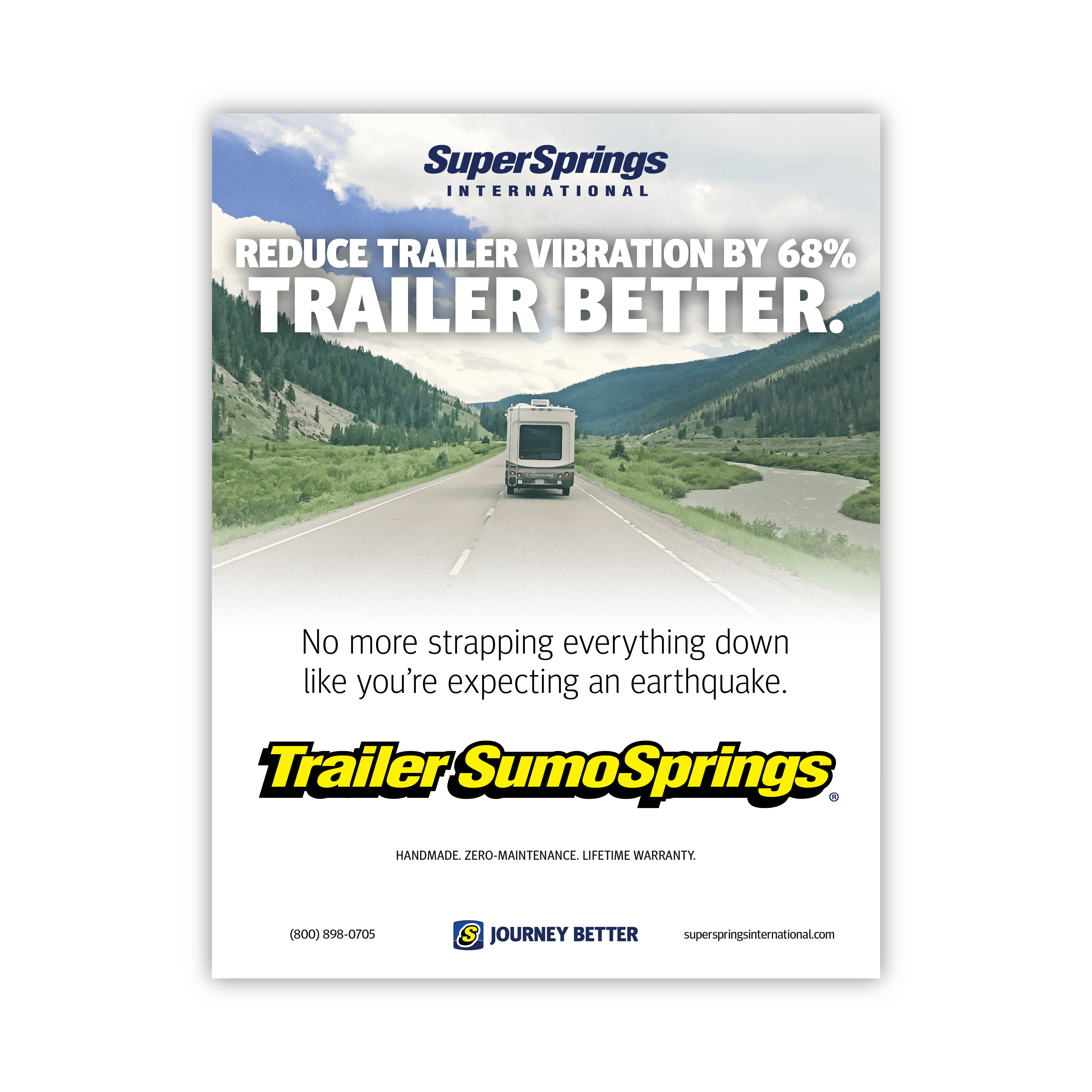
GERRY LAMBERTI Chairman & CEO 805.453.2726 [email protected]
TOM BATEMAN Director of Marketing 208.512.0855 [email protected]
JENI CHEN Director of Operations 805.698.1608 [email protected]
ADAM WEISNER President 208.449.9506 [email protected]
Thank you for leaving a review for the . We’re excited to be part of making your journey better.
- Company Name
- How did you hear about the magazine?
Credit Reference
Credit referral, your company information.
- Company Name: *
- Name * First Middle Last
Referral information
- Sold Since:
- High Credit:
- Date of Last Sale: Example: 01/01/2019
- A/R Balance:
- Current 1 of 4
- 1-30 days 2 of 4
- 31-60 days 3 of 4
- Over 90 4 of 4
- Total A/R Sum of the last 4 questions
- Percent: Please enter a number from 0 to 100 .
- Average Days to Pay:
- Prompt: Yes No
- Slow: Yes No
- NSF Checks: Yes No
- Add additional comments here...
Creative Request
<div class=”calendly-inline-widget” data-url=”https://calendly.com/superspringsinternational” style=”min-width:320px;height:630px;”></div> <script type=”text/javascript” src=”https://assets.calendly.com/assets/external/widget.js” async></script>
Brand Protection continues to be of the utmost importance for our company and our customers. We’ve spent the last several years building and rolling out processes to that end.
With that in mind, effective immediately, we’ve added Amazon to our Do Not Sell list.
Please make sure you frequently review the Authorized and Unauthorized Sellers on below to ensure your adherence to our Brand Protection Program. Selling to an Unauthorized Seller violates that program.
If you have any questions concerning selling online, please contact your relationship manager at 800.898.0705.
Thank you for your partnership and continued support of the SuperSprings International brand.
- What type of customers do you work with? *
- Recreational truck/car
- Commercial vehicles
- RV/Van/Motorhomes
- Trailer/Towables
Towing Your Trailer for the First Time
TL;DR: Towing your trailer for the first time? Plan ahead, practice driving, pack wisely, and prioritize safety on the road.
Before the Trip
Before taking the new travel trailer on the road, there are some key planning points that should take place first. You will need a few accessories, lots of practice, and an idea of how to properly pack up your trailer for towing purposes.
Accessories
Your tow vehicle is already equipped with side mirrors that are adequate for just the vehicle. However, to properly view a travel trailer’s entire length, you will most likely need to add additional mirrors. Remember, the rear-view mirror is not usable when towing a tall travel trailer, so bubble mirrors or extenders can make a world of a difference for keeping an eye on your trailer while driving.
You may also need to purchase an RV GPS in order to safely navigate roads that can accommodate your RV’s height and weight. There are many brands and models that are equipped with RV-friendly features, and there are a few quality phone apps as well. If you’re not quite sure where to start with selecting an RV GPS, then check out our helpful article listing some of the best-reviewed ones available. Additionally, a backup camera can be a helpful upgrade to make RV life a little easier.
A braking system can also make a drastic difference when towing your trailer. Be sure to research if your travel trailer can be equipped with a braking system and what type of brakes could be the most beneficial. A braking system can relieve your tow vehicle of bearing all the weight of slowing down the trailer, and it can also sometimes produce safer conditions.
Before practicing towing your travel trailer, ensure the RV is empty. The heavier the RV, the more difficult it can be to control it. Begin with the RV empty, and then slowly add more weight. Think water, a generator, gear, food, etc. It can also be helpful to bring a friend or spouse along when embarking on some practice drives. An extra set of eyes never hurt.
Spacial and Height Awareness
Proper spacial and height awareness are key important aspects of towing your trailer. For instance, before parking your travel trailer on the curb of your home, be sure to step out of the tow vehicle and evaluate any nearby tree branches or low hanging wires to ensure the travel trailer does not incur any damage. When beginning to practice towing, frequently check your mirrors to ensure your tow vehicle and trailer are within the lines on the road. The more a driver practices being aware of the width and height of the trailer, the more it will become second nature.
Braking and Turning
There are certain aspects of towing that are a bit more difficult to learn. Braking is certainly one of these aspects. Be sure to give yourself more time and space to brake than you would under normal conditions. Be sure to begin braking practice with an empty trailer, and then slowly add more weight. The heavier the RV, the more time will be needed for braking. As stated above, a braking system can be very helpful and much safer.
Turning can also feel like a difficult aspect to master. However, with enough practice, you'll be taking left and right hand turns comfortably in no time. Be sure to go slow and give yourself more space than you typically would when not towing. The mirror accessories can be a huge help to ensure your trailer does not hit the curb.
Reversing and Parking
Be sure to practice backing up and parking before hitting the campground. Many RV campgrounds only have a limited amount of pull-through sites. Most travel trailers and fifth wheels are expected to park in back-in sites, while large motorhomes towing a vehicle typically get the pull-through sites. For this reason, it’s important that you’re comfortable reversing and parking your travel trailer. This is where having an extra set of eyes can be helpful.
Packing your travel trailer is not only about organization. The way in which you pack can also have a huge impact on the handling of your RV, which is why it's important to distribute the weight properly throughout your RV. Before packing, evaluate the space that you have to work with, including the outdoor storage bays. Any heavy items, such as portable generators, should be stored low and towards the front of the RV.
It's common for first time trip-takers to pack everything they could need and more. However, try to fight that urge by packing light for your first trip. If possible, set out on your journey with minimal water in the fresh tank to lessen the load, and be sure that the grey and black tanks are empty. Do the same for your return journey. As stated above, the lighter the travel trailer is, the easier the handling will be. Looking for some packing ideas? Check out our list of essentials and our emergency kit guide .
Be Knowledgeable
There are a few things to be aware of before hitting the road for the first time. First and foremost, it's recommended that all passengers - including dogs and cats - be in the tow vehicle during travel. It's not only illegal for passengers to ride in the travel trailer in some areas, but it can also be dangerous. Things may fall or shift during transit which could cause injury. In addition, being in the travel trailer during transit can also be a bit scary, especially for pets who don't understand what's happening.
Be sure to check your route ahead of time for any low underpasses, weight capacities on bridges, and other obstacles. There are numerous tools to help map your trip, including an RV GPS. Knowing ahead of time what to expect along your journey can prevent last minute detours and alleviate stress. It an also be helpful to plan ahead for tolls because they will cost more when towing your travel trailer.
Preventing and Correcting Sway
Unfortunately, there aren’t many ways to practice correcting sway unless it’s actively happening. While the number one cause of swaying is wind, there are many ways to prevent these factors from causing sway. Before hitting the road, be sure to pack your RV properly, check your tongue weight, and check your tire pressure. If your trailer begins to sway, take your foot off the gas but do not hit the brakes unless you are in danger of hitting the vehicle in front of you. Suddenly braking can cause you to lose control of your trailer. Keep the steering wheel straight and do not fight the sway. Allow your vehicle to naturally slow down on its own. Once you’ve regained control, pull over to a safe area to check your trailer to ensure your cargo has not shifted. Once you’re back on the road, slow down if conditions are unfavorable.
Drive Safe!
The most important piece of advice is to drive safe. All the planning in the world won't make a difference without practicing safe driving methods while towing.
1. Keep your distance between cars.
As stated above, it's significantly more difficult to brake when towing your RV than it is just driving your tow vehicle. It's important to account for this extra space and time needed by keeping plenty of distance between you and the vehicle in front of you.
2. Go slow.
When first starting out, it may be necessary to drive at half the speed to maintain control of your trailer. In some states, the highway posted speed limits can be up to 80 mph. However, this doesn't mean that you need to drive that fast. Use your best judgement, and err on the side of caution, especially when just beginning.
3. Use engine braking if possible.
Engine braking can be very important, especially when driving downhill. Most vehicles are equipped with engine braking capabilities to assist with slowing down safely. Riding your brakes downhill while towing a heavy load can quickly burn out your brakes, putting you in danger. Before entering into a decline, drop your gears to assist with keeping your vehicle at a slower speed in order to avoid using your brakes as much.
4. When in doubt, pull over.
Use your best judgement when driving in inclement weather, and pull over if necessary. As stated above, wind is the main cause of sway when towing. If you feel uncomfortable or concerned, pull over to wait out the worst of the storm.
Taking your first trip with your travel trailer can be a daunting experience. Don’t let the nervousness spoil your excitement. Before traveling to your first Harvest Hosts location with your new travel trailer, be sure to have a plan, be knowledgeable, practice, and drive safe!

- Find a Location
How To Safely Tow a Travel Trailer

With the right preparation, towing doesn’t have to be a stressful part of owning a travel trailer, but a lack of preparation can have disastrous consequences. There is a lot to be aware of if you’re new to towing a travel trailer.
For starters, familiarize yourself with towing terminology that’ll help you determine how much weight your tow vehicle can handle. You might also find our guide to towing with a mid-size SUV useful.
All drivers of towable campers (even those with smaller campers like the Happier Camper ) must be aware of and avoid bridges with low clearance, tight turns, fast food drive-thrus, and, perhaps the most dangerous thing of all, other drivers.
Knowing how to safely tow a travel trailer protects you, your investment, and others on the road. So let’s talk about everything you need to know to tow safely!
Getting Your Trailer Ready for Safe Towing

Your first order of business starts well before you climb behind the wheel. Be sure your vehicle is capable of towing the full payload of your trailer (i.e. loaded weight). Use our towing guide to double-check your math before you hitch up your trailer.
Once you’re sure your vehicle is capable, securely connect the trailer’s tongue to your vehicle’s hitch ball. Double-check all of your turn signals, running lights, brake lights, and hazard signals. You may need a spotter to help you with this.
Also, consider installing a weight-distribution hitch to minimize bounce and sway that can cause you to lose control of your vehicle. These hitches distribute weight to the front axle of your tow vehicle and help to level your payload.
Towing with a high tongue or high rear bumper is never as safe as towing a trailer that is level with your tow vehicle. Consult this video to learn more about how to adjust a weight-distribution hitch.
Also, check tire air pressure and adjust according to your manufacturer’s recommendations. Towing with under or over-inflated tires increases your odds of suffering a blowout and under-inflated tires also reduce your fuel economy.
Becoming Aware of Your Trailer’s Size
Odds are, your trailer is wider than your tow vehicle. That’s why travel trailer owners use mirror extenders to help them check traffic when changing lanes or making turns. This is always a wise investment to help you tow safely.
In addition to the extra width, you also need to get used to the length and height of your trailer. If you’re new to towing, take your trailer to an empty parking lot to practice before you hit the open road.
Practice Towing

Ideally, find a lot with a few light poles scattered throughout so you can practice navigating around and between them. Swing wide when making turns with a trailer behind you. The arc of your trailer’s rear bumper will be smaller than the arc of your tow vehicle’s front bumper.
Pay close attention to how your trailer follows your tow vehicle and observe how wide you need to swing when turning around obstacles. Go slow as you’re practicing and be aware of the lean of your trailer when you turn.
Street signs and traffic signals sometimes hang over the roadway. So being aware of how much your trailer leans in turns will help you avoid these nuisance obstacles. Also, practice pulling into parking spots and work on your reverse skills. It’s helpful to practice backing your trailer up several times before many watchful eyes are on you at an RV park .
A Note on Travel Trailer Height

If you don’t know it off the top of your head, measure the height of your trailer or find it in your owner’s manual. Post that height on a sticky note somewhere you can see it while driving. That will remind you how much clearance you need when going under bridges and overpasses.
To avoid height issues altogether, map out your route before you leave for your next camping adventure. Use an RV-specific GPS system to make sure there aren’t any height restrictions on your desired route. This will help you avoid detours that add hours to your driving time.
Following Road Etiquette Driving a Travel Trailer

There are many RV rules, regulations, and road restrictions to be aware of before setting out. Here is a quick summary of general travel trailer etiquette to follow when towing:
- Use the right lanes unless turning, passing, or entering or exiting a roadway
- If you’re brand new to towing, avoid passing until you feel more comfortable
- On roads with no passing lane, pull over and allow vehicles to pass if there are four or more following closely behind you
- Signal turns and lane shifts early to alert other drivers
- Follow all posted speed limits and traffic signals
Using Appropriate Speeds

Driving at appropriate speeds goes a long way towards safe towing. Reduce your normal speed by 10 to 20 miles per hour when towing a travel trailer. That means doing 60 instead of 70 on major highways and reducing your speed even further on smaller, windier roads.
The tires on most travel trailers are rated for 60 to 65 miles per hour. The silver lining to this is that traveling between 55 and 65 miles per hour will improve your fuel economy, especially when traveling long distances.
And there’s another benefit of slowing down while towing a travel trailer. It will reduce how much all of your camping gear shifts from the time you leave your house to the time you reach your camping destinations .
Abrupt starts and stops are apt to cause your gear to move around in your trailer. This can cause damage to your gear and your trailer itself. Towing more slowly helps to ensure that you arrive with everything in the same condition it was in when you left.
Slowing Your Travel Trailer Down
Using appropriate speeds also comes into play when slowing your trailer down. Your vehicle and trailer need two to three times more distance to slow down and stop than your vehicle on its own.
The faster you go, the longer (and further) it will take to slow down. This is true even for travel trailers with electronic brake controllers , which take some burden off your tow vehicle’s brakes.
What To Do When It Gets Windy

The wind is one of the trickiest factors when towing a travel trailer. You are basically driving a large sail down the road and, unfortunately, it will be affected by wind much more than your tow vehicle.
A crosswind is more dangerous than a headwind or tailwind. When you feel the wind pushing you left or right as you drive, you will need to steer into it gently to keep going straight. Depending on the size of your trailer, even minor crosswinds of 10 to 15 miles per hour can impact your steering.
Heed all posted wind warnings along your driving route. If a posted recommendation suggests doing so, or you feel uncomfortable continuing to drive, pull over and wait until conditions improve.
Tips for Driving in Inclement Weather

In addition to the wind, driving in inclement weather must be approached with caution. Rain, snow , ice, fog, and other environmental factors should make you pause and think twice about continuing your journey.
Use your preferred weather app to check the weather early and often along your route. Just like the wind, it’s better to pull off and wait for a storm to pass than to continue driving into unsafe conditions. If you do pull off, some of these tips for staying entertained when the weather turns bad may prove useful.
Also, tune into AM radio stations broadcasting road alerts and weather warnings along your route. As a good rule, if the lights on those road condition signs are flashing, tune into the advertised station to learn why.
Handling The “Pull” of Large Vehicles

In addition to the wind, you will contend with the pull of RVs , semi-trucks, fifth wheels , and any other large vehicle you pass. This happens when two large vehicles are moving in opposite directions and the effect is greatest on two-lane roads without a center median.
As a driver, you’ll feel your tow vehicle and trailer pulled towards oncoming traffic. To be clear, you DO NOT need to overcorrect in this scenario. On calm days, slightly steering away from oncoming traffic will suffice, but you will need to gently correct once the vehicle has passed.
This effect increases in windy conditions. If you’re dealing with a crosswind from left to right, for example, you’ll already be steering slightly towards oncoming traffic to keep your trailer straight.
When a semi-truck passes, it acts as a momentary windbreak. To correct, you’ll need to gently reduce how much you’re steering into the wind and then correct once the truck passes.
This effect can be very subtle and may not require major corrections in the orientation of your steering wheel. Reducing your speed can also minimize the impact of pull when passing large trucks and other RVs. If at any time you feel unsafe on the road, then pull over and take a break.
Navigating Steep Mountain Grades

There are two main issues when navigating steep mountain grades . When descending, be conscious of burning up your vehicle and trailer brakes and, when ascending, engine overheating is a concern.
If you are towing a travel trailer up steep mountain grades, you must accept that you will go much slower than normal. If you’re well below the posted speed limit, move to the furthest lane to the right and consider turning on your hazard signals to warn other drivers.
Taking your time is recommended on steep inclines because it lessens the strain on your engine, drivetrain, and transmission. On long mountain grades, you may need to pull over at regular intervals to allow your engine to cool. Keep an eye on your engine temperature gauge and pull over if engine temp starts to rise.
Coming Back Down
When descending steep mountain grades, use your transmission to assist the braking systems on your tow vehicle and trailer. This is also when you can engage your electronic brake controller to reduce the stress on your vehicle’s brakes.
It’s a good practice to downshift early and prevent your trailer from reaching high speeds in the first place. It’s smart to maintain a slower average speed than allowing your trailer to speed up dangerously. The latter puts unnecessary stress on your braking systems to slow you back down to a reasonable speed.
Also, you never want to ride your brakes for a long period of time on a descent. Depress them to bring your speed well below the posted limit and then let off again. Continuous application of brakes is what burns them up.
Planning Gas Stops

Even getting gas, which is normally quite simple, can be challenging when towing a travel trailer. Plan your gas stops further in advance to avoid stations that can’t be navigated by larger vehicles.
Finding big rig friendly gas stations is imperative on your travels. Travel centers and truck stops along major highways won’t be hard to find, but you can use The Good Sam Trip Planner to find navigable gas stations in more remote locations too.
Be Proactive, Not Reactive

As a final word, always practice smart, mindful driving techniques when towing a travel trailer. It takes longer to execute all driving maneuvers in a travel trailer. Keep a watchful eye for other drivers and start moving over a few miles before your next highway exit.
It’s always safer to pass a highway exit, for example, than to make a quick, last-minute maneuver in an attempt to exit. There is always another exit ahead and a slight delay is better than the alternative.
With the right preparation, a little practice, and diligence on the road, you’ll be safe towing your travel trailer wherever you want to go. If you want some travel ideas, check out these seven romantic campgrounds calling for a couple’s getaway !
What tips do you have for towing a travel trailer? Leave a comment below!
- Comment (4)
If your tow vehicle is not already equipped, you should also invest in a good set of outside mirror extensions. It is vital you see beyond the width of your trailer.
I like your advice to go wide and slow while turning. My sister and her husband want to buy an RV travel trailer. I’ll share this advice to help them stay safe!
Great topic. I saw pictures of travelers with caravan on worldee. Its a inspiration for me. I think its better than flying…
Excellent article, great info
Leave Your Comment Cancel Reply
Save my name, email, and website in this browser for the next time I comment.
Shop By RV Type

Your Adventure Awaits
Copyright © 2023 cwi, llc all rights reserved.
- RV Glossary |
- Privacy Policy |
- California Privacy Rights |
- Do Not Sell or Share My Personal Information |
- Targeted Advertising Opt Out |
- Terms of Use
A how to guide for part time RV campers, and lovers of food and travel.

Towing a travel trailer for the first time (with Insider Tips!)
Dreaming of hitting the open road with your own cozy travel trailer in tow? Exhilarating adventures and stunning scenery await! But before you hitch up and hit the gas, let’s navigate the exciting (and sometimes daunting) world of towing a travel trailer for the first time .
Admittedly, towing a travel trailer for the first time was the most nerve wracking part of our decision to purchase an RV. If done incorrectly it can be a true safety hazard. But with a little education, and tips from fellow newbies you can confidently hook up your travel trailer and start exploring.
This guide, packed with insider tips, will have you conquering the tow and creating unforgettable memories in your rolling home.

Safety First!
As we mentioned, towing a travel trailer for the first time can be the scariest part of your first RV trip. As long as you are well prepared and following all safety precautions you will be set up for success! While it’s tempting to hook up and go as soon as you have your new RV, a little preparation will go a long way.
Use the right tow vehicle
Choose the perfect partner – a tow vehicle that can handle your trailer’s weight. Overloading is a recipe for disaster, not adventure. If you’re a little confused by tow math, you are not alone! Always check your vehicle’s manual for the maximum tow capacity.
- Consider tongue weight: The tongue weight is the downward force applied to the hitch by the trailer. It’s crucial to ensure your hitch and tow vehicle can handle this weight properly, usually around 10-15% of the trailer’s gross weight.
- Factor in additional weight: Don’t forget to account for the weight of passengers, cargo, and equipment you’ll be carrying in both your vehicle and the trailer.
- Never exceed the capacity: It’s never safe to exceed your vehicle’s towing capacity. Doing so can cause instability, brake failure, tire blowouts, and even accidents.
- Get help if needed: If you’re unsure about your vehicle’s towing capacity or have any concerns, consult a mechanic or experienced towing professional. They can help you choose the right equipment and ensure you’re towing safely.

Get the right equipment
Now, let’s talk hitch lingo. The first part is called the receiver tube – basically a square tube that becomes best friends with your tow vehicle. It comes in different sizes, typically between 1” and 2½”. This is likely already installed on your tow vehicle, especially if your vehicle has a tow package or is rated for towing.
You’ll need to get a ball mount that fits snugly into this tube. These ball mounts have their own classifications, from Class I to Class V, each handling different weights. You’ll also need to consider the drop height that will let you tow your tailer leveled. You want to tow your trailer high enough that it won’t easily hit things on the road, but also level so that it is well aligned.

If you purchased your Travel Trailer from a dealer they should be able to tell you the proper hitch and ball set up. If you’ve purchased from a private party you may need to do a little math and research to find the right hitch and ball set up.
For a full walk through on hitching your travel trailer to your tow vehicle you can read our how to guide here .
Master the basics. It’s always better to be safe than sorry. Before every trip make sure to check your tire pressure. Before pulling out for your trip you’ll alway want to do a brake light inspection and make sure they are functioning as they should.
Remember, you are towing thousands of pounds more than a normal drive. Allow yourself ample room between other vehicles. Even with trailer brakes your vehicle and RV will take more time that you are used to when braking. Brake well ahead of time and avoid slamming on the brakes whenever possible.
This is not a normal drive!! When towing a travel trailer you should stay well below the posted speed limit. This will help you control the extra weight of your RV and avoid it fishtailing behind you. Even if the roads are wide open we tend to stay between 50 – 55 mpg on highways. Believe me, if you go faster than that you will feel the wind begin to sway your trailer and need to regain control of the vehicle.
It is better to get somewhere late than not at all. Always factor extra time in to your trip. When towing and driving more slowly you will not make it to your destination as quickly as the GPS may say.
Practice Makes Perfect
Before hitting the highway, find an empty parking lot. You’ll thank yourself later. Practice will help you get accustomed to wider turns and adjust to your new stopping times. It’s also important to practice backing up your trailer. Remember, the trailer goes the opposite direction of the steering wheel. Turn right, the trailer goes left, and vice versa.

Have a friend stand behind the travel trailer to help guide you in backing up into the space. Keep an eye on the back corners of your RV to avoid hitting blind items! I highly recommend purchasing a couple of tow mirrors to add onto your vehicle. These are non permanent mirrors that easily slide onto your existing mirrors when towing. They will greatly extend your range of vision so you can see the back end of your travel trailer.
Plan your route
Knowing your route ahead of time can ease a lot of the trepidation that can come with towing a travel trailer for the first time. If you spend some time researching and planning you can increase your odds of a smooth and successful trip!
Research the route
When you’re on a regular trip without towing a travel trailer, you can easily assume that you can follow all the directions of your GPS. Some roads however, have particular requirements and clearances that make towing a travel trailer a bit tricky – or even prohibit it!
Pop your destination into a system like Google Maps. When you are traveling somewhere unfamiliar you’ll want to look up if the major highways Google Maps has provided allow trailers. If not, look up trucking routes for that same stretch of highway. If a commercial truck is allowed and fits on the road, so will your travel trailer.
Another thing to keep in mind is your travel trailer’s clearance height. This is a number you will want to know by heart. Nobody wants to be that guy who tries to squeeze under a bridge and gets the top of their travel trailer ripped off. You invested too much time and money into your first travel trailer to be that guy! Keep a close eye on clearance signs and don’t be afraid to pull over and find another route if needed.
Plan your gas stops.
One thing that will shock you when towing a travel trailer for the first time is your gas milage. Regardless of your vehicle’s towing capacity and travel trailer weight you will burn through much more gas than when you are not towing. Think about all that extra weight your vehicle has to pull!
On average, you will likely get about 10-15 miles per gallon when towing your travel trailer. Obviously each individual set up will be a little different. The trip itself will factor into this as well. If you’re covering flat stretched of highway out west you’ll get more mpg than if you’re climbing the hills of Vermont. As time goes on and you have more trips under your belt you will get a feel of your vehicle’s average.

Use this average to pre plan where you will stop for gas. There is nothing worse than being in an unfamiliar area with no idea where the next gas station will be. Use Google maps to plan your route with gas stops along the way.
For example: Our Ford Ranger only has an 18 gallon tank and typically gets between 12 and 15 mpg. That means we can usually go between 216 and 270 before needing to stop for gas. We never want to cut it too close so we find gas stations every 150-180 miles of our trip. Our dog Mookie loves this because he gets to hop out and sniff about every 2 hours 🙂
When planning your gas stations, try searching exclusively for truck stops. These are typically located on or right off the highway so you don’t have too much of a detour. Since they are built for trucks the layout is wider and there is much more space between pumps. When towing a travel trailer for the first time you don’t want to get stuck in a tight space while fueling up! Just be sure they don’t only offer diesel fuel.
Towing a travel trailer can be a learning curve, but the rewards are endless. Embrace the challenges, laugh at the wobbles (we’ve all been there!), and celebrate the victories (nailing that tricky back-up!).
Now, grab your maps, pack your sense of adventure, and with these tips in hand, you’re ready to conquer the tow and embark on your unforgettable travel trailer journey! Remember, the open road awaits, and it’s yours to explore. Happy camping!

Related Posts

How to Conquer Camping Season: Your Essential RV Opening Day Routine

The Ultimate RV Pre-Departure Checklist

RV Camping for Beginners: Top 5 Insider Tips to Camp like a Pro!
Essential Tips for Towing a Travel Trailer: A Comprehensive Guide
Welcome to the world of towing a travel trailer! Whether you’re a seasoned RVer or a newcomer to the RV lifestyle, towing a travel trailer opens up a world of adventure, allowing you to explore diverse landscapes, create cherished memories, and embark on unforgettable journeys. However, towing a travel trailer comes with its own set of considerations, responsibilities, and skills to ensure a safe and enjoyable experience.
In this comprehensive guide, we aim to equip you with a wealth of knowledge and practical tips to navigate the intricacies of towing a travel trailer. From understanding your trailer’s weight and capacity to selecting the right tow vehicle, distributing weight properly, and performing pre-trip inspections, each aspect plays a crucial role in ensuring a smooth towing journey.
But that’s not all. We delve into maneuvering and backing up techniques, the importance of allowing for extra stopping distance, adjusting your driving habits for towing, being mindful of the height and length of your trailer, and monitoring tire pressure for optimal performance. We’ll also cover essential topics such as staying updated on regulations, considering weather conditions, embracing environmental responsibility, being prepared for emergencies, optimizing fuel efficiency, practicing towing etiquette, and even exploring frequently asked questions.
Throughout this guide, our aim is to empower you with the knowledge and skills needed to confidently navigate the roads with your travel trailer in tow. We’ll provide detailed insights, practical advice, and helpful tips garnered from experienced RVers, experts, and industry professionals. By following these guidelines and implementing best practices, you can embark on your towing adventures with confidence, peace of mind, and the ability to make the most of every moment.
Whether you’re planning a cross-country road trip, weekend getaways to your favorite camping spots, or a leisurely exploration of natural wonders, towing a travel trailer offers you the freedom and flexibility to create your own itinerary, embrace the beauty of the great outdoors, and forge lifelong connections with fellow travelers.
So, let’s dive in and embark on this comprehensive towing journey together. From the essentials to the finer details, we’ll cover everything you need to know to tow a travel trailer safely, efficiently, and responsibly. Get ready to unlock a world of possibilities and embark on the adventure of a lifetime!

Table of Contents
- 1 Know Your Trailer’s Weight and Capacity
- 2 Use the Right Tow Vehicle
- 3 Distribute Weight Properly
- 4 Perform a Pre-Trip Inspection
- 5 Practice Maneuvering and Backing Up
- 6 Allow for Extra Stopping Distance
- 7 Adjust Your Driving Habits
- 8 Be Mindful of Height and Length
- 9 Monitor Tire Pressure
- 10 Stay Updated on Regulations
- 11 Weather Considerations
- 12 Emergency Preparedness
- 13 Fuel Efficiency Tips
- 14 Parking and Storage
- 15 Insurance and Legal Considerations
- 16 Environmental Responsibility
- 17 Towing Etiquette and Campground Courtesy
- 18 Towing with Pets
- 19 Technology and Towing
- 20 Troubleshooting and Maintenance Tips
- 21 Frequently Asked Questions
- 22 Final Thoughts
Know Your Trailer’s Weight and Capacity
Understand Trailer Weight Terminology : When it comes to trailer weight, it’s essential to understand a few key terms:
- Gross Vehicle Weight Rating (GVWR) : This is the maximum weight that a trailer is designed to carry, including the weight of the trailer itself, cargo, and fluids (such as water and propane). Exceeding the GVWR can compromise the trailer’s structural integrity and safety.
- Dry Weight (Unloaded Vehicle Weight or Base Weight) : This refers to the weight of the trailer without any cargo, fluids, or personal belongings. It includes the weight of standard equipment installed by the manufacturer.
- Cargo Carrying Capacity (CCC) : Also known as payload capacity, CCC represents the maximum weight of cargo and personal belongings that can be added to the trailer.
Consult the Trailer Documentation : Review the trailer’s documentation, including the owner’s manual and any weight-related stickers or plates affixed to the trailer. These documents provide valuable information about the trailer’s weight ratings, such as the GVWR, tongue weight capacity, axle ratings, and tire load ratings. Familiarize yourself with these specifications before loading your trailer.
Weigh Your Loaded Trailer : To accurately determine your trailer’s weight, consider taking it to a public weigh station or using portable weighing scales designed for RVs and trailers. This will help you understand the actual weight of your trailer when loaded with cargo, fluids, and personal belongings. Comparing this weight to the GVWR will ensure that you’re not overloading your trailer.
Calculate Tongue Weight : Tongue weight is the downward force exerted on the hitch ball by the trailer’s tongue. It plays a crucial role in maintaining stability while towing. Typically, tongue weight should be around 10% to 15% of the trailer’s total weight. You can measure tongue weight using a specialized scale or by using weight-distributing hitches that include built-in tongue weight measurement systems.
Determine Your Tow Vehicle’s Towing Capacity : Check your tow vehicle’s owner manual or consult with the manufacturer to determine its towing capacity. This specification indicates the maximum weight the vehicle can safely tow. Ensure that the towing capacity exceeds the GVWR of your loaded trailer to maintain safe towing conditions.
Consider Weight Distribution Hitches : Weight distribution hitches (WDH) are invaluable tools for towing large travel trailers. They help distribute the trailer’s weight evenly across all wheels, reducing strain on the tow vehicle’s rear axle and improving stability. Consider using a weight distribution hitch if your trailer’s tongue weight exceeds the recommended limits or if you experience rear sagging or poor steering control.
Pay Attention to Payload Capacity : In addition to the towing capacity, consider your tow vehicle’s payload capacity. This represents the maximum weight of passengers, cargo, and hitch weight that the vehicle can handle. Make sure the combined weight of the passengers, cargo, and tongue weight of the trailer doesn’t exceed the payload capacity to maintain proper vehicle handling and performance.
By understanding your trailer’s weight and capacity, you’ll be able to make informed decisions when it comes to loading, towing, and ensuring the safety and stability of your travel trailer. Always prioritize safety and stay within the recommended weight limits to enjoy a smooth and enjoyable towing experience.
Use the Right Tow Vehicle
Consider the Towing Capacity : One of the primary factors to consider when selecting a tow vehicle is its towing capacity. Towing capacity refers to the maximum weight a vehicle can safely tow. It is determined by factors such as engine power, transmission, frame strength, suspension, and cooling systems. Refer to your vehicle’s owner manual or consult with the manufacturer to determine its towing capacity.
Analyze Gross Combined Weight Rating (GCWR) : The Gross Combined Weight Rating (GCWR) is the maximum weight limit for both the tow vehicle and the trailer when they are fully loaded. It includes the combined weight of the vehicle, passengers, cargo, fuel, and the trailer itself. Ensure that the GCWR of your tow vehicle is higher than the total weight of your loaded trailer to maintain safe towing conditions.
Evaluate Engine Performance and Torque : A robust engine with ample horsepower and torque is essential for towing heavy trailers. Consider a vehicle with an engine that can deliver sufficient power to handle the added weight and overcome steep inclines without straining. Higher torque values are particularly advantageous for maintaining momentum while towing uphill or when faced with challenging driving conditions.
Check Transmission Type : An appropriate transmission is crucial for towing. Automatic transmissions are generally preferred for towing because they offer smoother gear shifts and better torque management. Look for vehicles with transmissions specifically designed for towing, which may include features like tow/haul modes or manual gear selection to optimize performance while towing.
Assess Braking System : Adequate braking capability is vital when towing a travel trailer. Ensure that your tow vehicle is equipped with a reliable and robust braking system. Consider vehicles with features like electronic trailer brake controllers , which enable the synchronization of the trailer’s braking system with the tow vehicle’s brakes for better control and stopping power.
Verify Suspension and Stability Control : A well-designed suspension system is essential for maintaining stability and ride comfort while towing. Look for vehicles equipped with heavy-duty suspension components and technologies like load-leveling systems or rear air suspension, which help mitigate the effects of added weight on the tow vehicle. Additionally, advanced stability control systems, such as electronic stability control (ESC), can enhance towing safety by reducing the risk of trailer sway and maintaining stability in challenging driving conditions.
Assess Cooling Systems : Towing places an extra load on the engine and transmission, causing them to generate more heat. Adequate cooling systems, such as larger radiators, transmission coolers, and engine oil coolers, are crucial to prevent overheating and ensure optimal performance while towing. Verify that your chosen tow vehicle is equipped with the necessary cooling systems for towing heavy loads.
Consult with Professionals : If you’re unsure about selecting the right tow vehicle for your travel trailer, it’s advisable to consult with professionals such as RV dealerships or towing specialists. They can offer expert advice based on your specific trailer’s weight, dimensions, and towing requirements, helping you make an informed decision.
Choosing the right tow vehicle is crucial for a safe and comfortable towing experience. By considering factors such as towing capacity, engine performance, transmission, braking system, suspension, cooling systems, and seeking professional guidance when needed, you’ll be well-equipped to tow your travel trailer with confidence and peace of mind.
Distribute Weight Properly
Proper weight distribution within your travel trailer is essential for maintaining stability and control while towing. The goal is to evenly distribute the weight across the trailer’s axles to prevent excessive strain on the hitch and tow vehicle, and to maintain balanced handling characteristics.
Consider Tongue Weight : Tongue weight is the downward force exerted on the hitch ball by the trailer’s tongue or coupler. It plays a significant role in maintaining stability during towing. Aim for a tongue weight that is approximately 10% to 15% of the total trailer weight (when loaded). You can measure tongue weight using specialized scales or by using weight-distributing hitches with built-in tongue weight measurement systems.
Load Heavier Items Towards the Front : When loading your travel trailer, place heavier items towards the front, closer to the axle. This helps maintain proper tongue weight and keeps the trailer balanced. Heavier items could include water tanks (if positioned towards the front), generators, batteries, or larger equipment. Avoid placing heavy items towards the rear, as it can lead to improper weight distribution and potentially cause trailer sway.
Balance Side-to-Side Weight : Ensure that weight is evenly distributed from side to side within the trailer. Imbalanced weight can lead to handling issues and put stress on the trailer’s suspension. Pay attention to how you load items and distribute weight throughout the interior of the trailer. Make adjustments as needed to achieve balance.
Avoid Overloading : Respect the trailer’s weight capacity and avoid overloading it. Exceeding the Gross Vehicle Weight Rating (GVWR) can lead to structural damage, tire failure, and unsafe towing conditions. Consider the combined weight of passengers, cargo, fluids, and equipment to ensure it stays within the recommended limits.
Secure Loose Items : Secure all items within the trailer to prevent shifting during transit. Loose items can disrupt weight distribution, affect stability, and potentially cause damage. Utilize straps, cargo nets, or other securing mechanisms to keep everything in place.
Keep a Low Center of Gravity : Maintaining a low center of gravity contributes to better stability while towing. Whenever possible, place heavier items lower in the trailer, such as closer to the floor or lower storage compartments. This helps minimize the risk of top-heavy situations that can lead to swaying or tipping.
Regularly Reassess Weight Distribution : Periodically assess and adjust the weight distribution within your trailer, especially during extended trips. As you consume resources or add new items, the weight distribution can shift. Take the time to redistribute weight as needed to maintain proper balance and stability.
Remember, proper weight distribution is crucial for safe and controlled towing. By understanding the importance of tongue weight, loading heavier items towards the front, balancing weight side-to-side, avoiding overloading, securing loose items, keeping a low center of gravity, and regularly reassessing weight distribution, you’ll ensure a smoother and more enjoyable towing experience with your travel trailer.
Perform a Pre-Trip Inspection
Performing a thorough pre-trip inspection is crucial to ensure the safety and reliability of your travel trailer before embarking on any journey. Follow these steps to conduct a comprehensive pre-trip inspection:
Check the Exterior : Inspect the exterior of your travel trailer for any signs of damage, such as dents, cracks, or loose panels. Pay close attention to the roof, sidewalls, and undercarriage. Check the condition of the windows, doors, and awnings, ensuring they open, close, and latch properly. Look for any signs of leaks, including water stains or soft spots.
Inspect the Hitch and Coupler : Examine the hitch and coupler to ensure they are in good condition and securely connected. Verify that the coupler is properly locked onto the hitch ball, and check the safety latch or locking mechanism. Confirm that all safety chains are properly attached and in good working order.
Test the Lights and Signals : Check all the exterior lights and signals on both the tow vehicle and the trailer. This includes headlights, brake lights, turn signals, taillights, and clearance lights. Replace any bulbs that are burnt out, and ensure all the wiring connections are secure. Consider having a second person assist you in verifying the functionality of the lights and signals as you activate them.
Verify the Brake System : Test the trailer’s brake system to ensure it is functioning properly. This includes electric brakes or surge brakes, depending on the type of system your trailer has. Activate the brakes using the brake controller or by applying pressure to the surge brake actuator (if applicable). Listen for any unusual noises, and ensure the brakes engage and release smoothly.
Check the Tires : Inspect the tires on both the tow vehicle and the trailer. Look for signs of wear, such as uneven tread wear or sidewall damage. Ensure that the tires are inflated to the correct pressure, as indicated by the manufacturer’s recommendations. Check the tire sidewalls for the maximum load rating, and make sure it exceeds the weight of your loaded trailer.
Inspect the Wheel Bearings and Suspension : Examine the wheel bearings and suspension components of the trailer. Look for any signs of excessive wear, corrosion, or damage. Lubricate the wheel bearings if necessary, following the manufacturer’s guidelines. Test the suspension by pushing down on each corner of the trailer to check for proper movement and rebound.
Test the Trailer’s Brakes and Breakaway System : Verify that the trailer’s electric brakes or surge brakes are operating correctly. If your trailer has an electric brake system, activate the brakes using the brake controller and ensure they respond effectively. If your trailer is equipped with a breakaway system, test it by pulling the breakaway switch to activate the brakes without the tow vehicle connected. Confirm that the brakes engage and hold the trailer in place.
Check the Safety Equipment : Inspect the safety equipment on the trailer, such as the fire extinguisher, smoke detectors, and carbon monoxide detectors. Ensure they are in working order and have not expired. Check the status of the trailer’s emergency exit windows and hatches, verifying that they open easily.
Verify the Trailer’s Plumbing and Electrical Systems : If your trailer has plumbing and electrical systems, inspect them for any leaks, damaged connections, or loose wiring. Test the water pump, faucets, toilets, and any other plumbing fixtures. Check the electrical outlets, switches, and appliances, ensuring they are functioning correctly.
Secure Loose Items : Before hitting the road, secure any loose items within the trailer to prevent shifting during transit. Check cabinets, drawers, and other storage areas to ensure everything is properly stowed and secured.
By conducting a comprehensive pre-trip inspection, you’ll identify any potential issues or maintenance needs that require attention before you start your journey. Taking the time to perform these checks will help ensure a safer and more enjoyable travel experience with your trailer.
Practice Maneuvering and Backing Up
Find an Open Space : To practice maneuvering and backing up your travel trailer, find an open space such as an empty parking lot, a quiet street, or a spacious campground. Ensure that the area provides enough room for you to make turns and perform various maneuvers safely.
Start with Basic Maneuvers : Begin by practicing basic maneuvers to get a feel for how your trailer responds to steering inputs. Start with simple turns, both left and right, to understand the turning radius of your tow vehicle and trailer combination. Take note of any limitations or differences compared to driving without a trailer.
Master Straight-Line Reversing : Start with straight-line reversing to gain confidence in controlling the trailer’s direction while moving backward. Use your mirrors and visual reference points to align your trailer with the desired path. Make small, precise steering adjustments and take it slow. Keep in mind that reversing with a trailer may require turning the steering wheel in the opposite direction compared to normal driving.
Use Reference Points : Reference points can help you gauge the trailer’s position while maneuvering or backing up. Use the side mirrors to establish reference points on the trailer, such as the corners or edges, to guide your movements. With practice, you’ll develop a better sense of the trailer’s position and how it tracks behind the tow vehicle.
Practice Turning and Cornering : Once you’re comfortable with straight-line reversing, practice making turns and corners with your trailer. Approach turns slowly and widen your turning radius to accommodate the increased length of the trailer. Be mindful of the trailer’s swing and the potential for the rear to cut corners more tightly than the tow vehicle.
Utilize Spotter Assistance : Having a second person, known as a spotter, can greatly assist in maneuvering and backing up your trailer. The spotter can provide guidance and communicate with you using hand signals or two-way radios. Establish clear signals beforehand to indicate when to stop, turn, or adjust your course. Maintain open communication with your spotter to ensure a smooth and coordinated operation.
Practice Parallel Parking : Parallel parking with a trailer can be challenging but is an essential skill. Find a suitable space and practice aligning your trailer parallel to the curb or other vehicles. Use a combination of your mirrors, spotter assistance, and reference points to guide your positioning. Take your time, make small adjustments, and be patient throughout the process.
Consider Taking a Driving Course : If you’re new to towing or want to enhance your skills, consider enrolling in a trailer towing course. These courses provide hands-on training, professional guidance, and valuable tips for safe and effective towing. Instructors can help you refine your techniques and build confidence in various towing maneuvers.
Be Mindful of Obstacles and Clearance : While practicing maneuvers and backing up, be aware of any obstacles, curbs, or low-hanging branches that could impact your trailer. Keep a safe distance from other vehicles or objects, especially when reversing. Take note of height clearances to avoid damaging the trailer’s roof or air conditioning units.
Learn from Experience : Practice regularly and learn from your experiences. Each towing situation may present unique challenges, and the more you practice, the better you’ll become at handling your travel trailer. Take note of what works well for you, learn from any mistakes or challenges, and continually improve your towing skills.
Remember, practice makes perfect. By dedicating time to practice maneuvering and backing up your travel trailer, you’ll develop the necessary skills and confidence to handle different towing scenarios. Always prioritize safety, stay patient, and be aware of your surroundings while maneuvering your trailer.
Allow for Extra Stopping Distance
Understand the Impact of Towing : Towing a travel trailer significantly increases the overall weight and length of your rig, which affects braking performance. It’s crucial to recognize that towing requires a longer stopping distance compared to driving without a trailer. Understanding this impact is vital for safe towing.
Maintain a Safe Following Distance : To account for the increased stopping distance, maintain a safe following distance between your tow vehicle and the vehicle ahead. The recommended guideline is to leave at least a four-second gap between your trailer and the vehicle in front of you. This provides you with adequate time to react and brake if a sudden stop occurs.
Anticipate Braking Situations : When towing a travel trailer, it’s important to anticipate potential braking situations well in advance. Stay alert and watch for any changes in traffic flow, upcoming intersections, or road conditions that may require you to slow down or stop. Being proactive in recognizing potential hazards allows you to adjust your speed and braking accordingly.
Brake Smoothly and Gradually : When it’s time to apply the brakes, do so smoothly and gradually. Avoid sudden or hard braking, as it can cause the trailer to sway or skid. Apply consistent pressure to the brake pedal to bring your vehicle and trailer to a controlled stop. Smooth braking helps maintain stability and prevents the trailer’s brakes from locking up.
Use Trailer Brakes : If your travel trailer is equipped with electric brakes, ensure they are properly connected and in working order. Trailer brakes provide additional stopping power and can assist in reducing the load on your tow vehicle’s brakes. Adjust the brake controller settings to achieve the appropriate braking force for your trailer’s weight and road conditions.
Engage Engine Braking : Take advantage of engine braking, also known as downshifting or using lower gears, to assist with stopping your trailer. Engine braking helps slow down your rig while reducing the strain on the tow vehicle’s braking system. Utilize the tow/haul mode, if available, to optimize engine braking performance.
Be Prepared for Emergency Stops : In emergency situations, such as sudden obstacles or the need to avoid collisions, be prepared for more aggressive braking. However, it’s crucial to maintain control of your trailer during these maneuvers. Apply the brakes firmly but progressively, steering to maintain stability and avoiding oversteering or excessive swaying.
Adjust Speed to Road and Weather Conditions : Road and weather conditions can significantly affect your stopping distance while towing. Reduce your speed when driving on wet, icy, or slippery roads to allow for increased stopping distances. Adjust your driving to match the conditions, as traction and braking capabilities can be compromised in adverse weather.
Consider Weight Distribution and Load : Proper weight distribution within your trailer plays a role in braking performance. Ensure that the weight is balanced and not overloaded towards the rear, as this can affect the stability and braking effectiveness. Regularly assess the weight distribution and make adjustments as needed.
Maintain Regular Maintenance : Regularly maintain your tow vehicle’s braking system and trailer’s braking components. This includes inspecting brake pads, rotors, brake fluid levels, and adjusting the trailer’s brake controller as necessary. Properly maintained brakes contribute to optimal stopping performance.
By allowing for extra stopping distance and being mindful of the increased weight and length of your towed travel trailer, you’ll enhance safety and control while on the road. Remember to maintain a safe following distance, brake smoothly and gradually, utilize trailer brakes and engine braking, adjust speed to road conditions, and prioritize regular maintenance to ensure reliable braking performance while towing.
Adjust Your Driving Habits
Moderate Your Speed : When towing a travel trailer, it’s essential to adjust your driving speed. Higher speeds can increase the risk of trailer sway and reduce your ability to react to sudden changes on the road. Maintain a moderate speed that allows for better control, stability, and sufficient reaction time.
Avoid Sudden Lane Changes : Towing a travel trailer requires careful planning and deliberate movements. Avoid abrupt or sudden lane changes, as they can cause the trailer to sway or affect the stability of your tow vehicle. Signal well in advance, check your mirrors, and make smooth lane changes to maintain control.
Use Your Mirrors Frequently : Develop a habit of checking your mirrors frequently while towing. This allows you to monitor the position of your trailer, the traffic behind you, and any potential issues on the road. Utilize your side mirrors and, if available, extended towing mirrors to have a clear view of your trailer’s surroundings.
Take Turns Wider : The increased length of your rig requires wider turns to avoid mounting curbs, hitting obstacles, or encroaching into neighboring lanes. Take turns wider than you would without a trailer, giving yourself ample room to navigate safely. Pay attention to signs indicating the appropriate turning radius for larger vehicles.
Be Cautious on Hills and Inclines : When driving on hills or inclines, adjust your speed and gear selection to maintain control and prevent strain on your vehicle’s engine and transmission. Ascend hills at a steady pace, and consider downshifting to utilize engine braking on descents. Be cautious of your trailer’s weight and ensure it doesn’t exceed the recommended limits for safe towing.
Plan Ahead for Passing and Merging : Passing or merging with a trailer requires careful planning. Allow for extra time and space when executing these maneuvers. Signal well in advance, check for sufficient gaps in traffic, and accelerate gradually to complete the maneuver safely. Be aware of your trailer’s length and account for the additional time needed to pass or merge.
Stay Focused and Avoid Distractions : Towing a travel trailer demands your full attention on the road. Minimize distractions inside the vehicle, such as using mobile devices or adjusting entertainment systems. Keep conversations with passengers to a minimum and prioritize safe driving practices. Maintaining focus allows you to react promptly to any changes or hazards.
Monitor Weather and Road Conditions : Weather and road conditions can significantly impact towing safety. Stay informed about weather forecasts along your route and be prepared to adjust your driving accordingly. Reduce your speed on wet or slippery roads, be cautious of crosswinds, and exercise extra care during adverse weather conditions.
Take Breaks and Rest : Long hours on the road can be tiring, so plan for regular breaks to rest and refresh yourself. Fatigue can impair your judgment and reaction times, compromising your ability to tow safely. Take breaks at designated rest areas, stretch your legs, and rehydrate. If possible, share driving responsibilities with another licensed driver.
Practice Defensive Driving : Adopt a defensive driving mindset while towing a travel trailer. Be aware of the actions and behaviors of other drivers around you. Anticipate potential hazards, maintain a safe distance from other vehicles, and stay prepared to react to sudden changes in traffic or road conditions.
By adjusting your driving habits while towing a travel trailer, you’ll enhance safety and maintain better control of your vehicle. Moderating your speed, avoiding sudden lane changes, utilizing mirrors frequently, taking wider turns, planning for passing and merging, staying focused, monitoring weather and road conditions, taking breaks when needed, and practicing defensive driving contribute to a safer and more enjoyable towing experience.
Be Mindful of Height and Length
Know Your Trailer’s Height and Length : Before you hit the road, it’s crucial to be aware of the height and length of your travel trailer. Measure the height of your trailer from the ground to the highest point, such as the air conditioning unit or antenna. Measure the overall length from the front of the tow vehicle to the back of the trailer, including any accessories or attachments.
Check Height Restrictions : Many bridges, tunnels, gas stations, parking garages, and other structures have height restrictions. Before planning your route, research and identify potential height restrictions along the way. Take note of any low-clearance areas that may pose a risk to your trailer. Plan alternative routes if necessary to avoid these obstacles.
Utilize GPS or Navigation Apps : Use a GPS device or navigation app specifically designed for RVs and trailers . These tools can provide information on height restrictions, low-clearance areas, and RV-friendly routes. Input your travel trailer’s dimensions into the device or app to receive customized directions that take your trailer’s height and length into account.
Display Height Warning Signs : Attach a prominent height warning sign to the inside of your tow vehicle’s windshield. This serves as a constant reminder of your travel trailer’s height, helping you stay vigilant and avoid collisions with low structures or obstacles.
Be Cautious when Entering and Exiting : Exercise caution when entering and exiting driveways, parking lots, and other areas with angled or steep entrances. Assess the slope of the entry point to ensure that your travel trailer’s underside, such as the rear bumper or spare tire, doesn’t scrape against the ground. Take these areas slowly and at an angle if necessary to avoid damaging the trailer.
Allow for Extra Space : When changing lanes or maneuvering through tight spaces, give yourself extra clearance. Remember that your trailer extends beyond the rear of your tow vehicle, and its wide turns can encroach on neighboring lanes. Always check your mirrors and blind spots to ensure there’s sufficient space to safely complete the maneuver.
Communicate with Spotter Assistance : If available, use a spotter to guide you in tight or tricky situations. A spotter can provide directions, ensure clearance from objects or structures, and communicate any potential risks. Establish clear hand signals or use two-way radios to maintain effective communication between you and the spotter.
Be Mindful of Overhanging Branches : Pay attention to overhanging tree branches along your route, especially when driving through wooded areas or campgrounds. Trimmed branches may still have low-hanging sections that could scrape or damage the roof or other components of your travel trailer. Stay aware and choose routes that minimize the risk of contact with branches.
Watch Out for Driveway Dips and Uneven Surfaces : Be cautious of steep driveway dips, uneven road surfaces, or speed bumps that could cause the underside of your trailer to scrape or bottom out. Approach these areas slowly and at an angle if needed to minimize the risk of damage.
Practice Height and Length Awareness : Develop a habit of regularly checking your surroundings, including overhead clearance, when navigating in areas with potential height or length restrictions. Be mindful of signs indicating low-clearance areas, tunnels, or bridges. Stay alert and avoid situations where your travel trailer’s height or length may become an issue.
By being mindful of the height and length of your travel trailer, you’ll avoid potential accidents, damage, or inconveniences caused by low-clearance structures or tight spaces. Stay vigilant, utilize specialized navigation tools, display height warning signs, communicate effectively with spotters, and practice awareness of your trailer’s dimensions to ensure a safe and smooth towing experience.
Monitor Tire Pressure
Importance of Proper Tire Pressure : Maintaining proper tire pressure is crucial for both safety and performance while towing a travel trailer. Adequate tire pressure ensures optimal traction, stability, and load-bearing capacity. Incorrect tire pressure can lead to handling issues, increased fuel consumption, premature tire wear, and even tire blowouts. Regularly monitoring and maintaining tire pressure is essential.
Check Manufacturer’s Recommendations : Refer to the travel trailer’s owner manual or check the tire sidewalls for the manufacturer’s recommended tire pressure. The recommended pressure may vary depending on factors such as tire size, load rating, and ambient temperature. Ensure that you adhere to the specific guidelines provided by the manufacturer.
Use a Reliable Tire Pressure Gauge : Invest in a high-quality tire pressure gauge to accurately measure the air pressure in your trailer tires. A digital gauge or a quality analog gauge with a pressure release valve is recommended for precise readings. Avoid relying solely on visual inspections or gas station air pumps, as they may not provide accurate readings.
Monitor Tire Pressure Regularly : Check the tire pressure of your travel trailer’s tires at least once a month, or before each trip. It’s essential to inspect the pressure when the tires are cool, as heat generated during towing can increase tire pressure and provide inaccurate readings. Check the pressure in all tires, including the spare tire if applicable.
Inflate to the Recommended Pressure : Use an air compressor or a reliable air source to inflate the tires to the recommended pressure. Avoid overinflating or underinflating the tires, as both can negatively impact towing performance and tire lifespan. Adjust the pressure gradually, and recheck it with the tire pressure gauge to ensure accuracy.
Consider Load and Weight : Take into account the load and weight distribution in your travel trailer when adjusting tire pressure. If your trailer is heavily loaded or has uneven weight distribution, consult load/inflation tables provided by tire manufacturers. These tables provide specific recommendations for different load ranges to ensure the tires are properly inflated for the given weight.
Monitor Pressure During Trips : While on the road, periodically check the tire pressure of your travel trailer’s tires. Factors like changes in ambient temperature and prolonged driving can affect tire pressure. Consider investing in a reliable tire pressure monitoring system (TPMS) that provides real-time pressure and temperature readings for each tire.
Inspect for Damage or Wear : During tire pressure checks, inspect the tires for any signs of damage, such as cuts, bulges, punctures, or uneven wear. Address any issues promptly to avoid tire failure while towing. If you notice abnormalities or concerns, consult a tire professional for a thorough inspection and necessary repairs or replacements.
Account for Temperature Changes : Keep in mind that tire pressure can fluctuate with changes in temperature. In colder weather, tire pressure tends to decrease, while it may increase in hotter conditions. Adjust the tire pressure accordingly to ensure it remains within the recommended range for safe towing.
Maintain Proper Load Distribution : Proper weight distribution within your travel trailer contributes to even tire wear and optimal tire performance. Avoid overloading individual tires and ensure that the weight is distributed evenly among all tires. This helps maintain proper inflation and minimizes the risk of tire damage or failure.
By monitoring tire pressure regularly and ensuring proper inflation, you’ll enhance safety, handling, and tire longevity while towing your travel trailer. Stay diligent, follow manufacturer recommendations, consider load and weight factors, inspect for damage, and address any concerns promptly to maintain optimal tire performance throughout your journeys.
Stay Updated on Regulations
Research Local and State Regulations : Before embarking on a towing trip with your travel trailer, take the time to research and understand the local and state regulations that may apply to towing. Different regions may have specific rules and requirements regarding trailer size, weight limits, speed limits, towing equipment, and more.
Consult Department of Transportation Websites : Visit the websites of the relevant Department of Transportation (DOT) or transportation authorities for the jurisdictions you’ll be traveling through. These websites often provide detailed information on towing regulations, road restrictions, permit requirements, and any special considerations for towing recreational vehicles.
Understand Weight and Length Restrictions : Familiarize yourself with weight and length restrictions imposed by different jurisdictions. This includes maximum Gross Vehicle Weight Rating (GVWR), overall length limits, and axle weight limits. Ensure that your travel trailer complies with these regulations to avoid legal issues and ensure safe and legal towing.
Research Special Vehicle Requirements : Some areas may have additional requirements for towing vehicles or trailers. For example, certain states may require trailers to have functioning brake systems or safety chains. Research if there are any specific regulations or equipment requirements for towing in the regions you’ll be visiting.
Stay Informed about Road Bans or Construction Zones : Check for any temporary road bans or restrictions that may affect towing in your intended travel route. Some areas impose restrictions on certain types of vehicles or trailers during specific times or in construction zones. Stay updated on any advisories or closures that could impact your towing plans.
Consider International Travel : If you plan to tow your travel trailer across international borders, be aware that each country may have its own regulations and requirements for towing. Research the specific rules and ensure compliance with the local regulations before crossing the border.
Join RV and Towing Associations : Consider joining RV or towing associations that provide resources and updates on towing regulations. These organizations often have knowledgeable staff who can answer questions and offer guidance regarding towing regulations and compliance. They may also provide access to forums or online communities where you can connect with experienced tow vehicle owners.
Engage with Online RV Communities : Participating in online RV communities and forums can be a valuable source of information on towing regulations. Interacting with experienced RV enthusiasts and fellow travelers allows you to tap into their knowledge and experiences. Seek advice, share information, and stay informed about any changes in towing regulations.
Follow Social Media Accounts of Transportation Authorities : Follow the social media accounts of transportation authorities and relevant government agencies. They often share updates, road advisories, and regulatory changes that may affect towing. By staying connected to these sources, you’ll receive real-time information about any towing-related news or updates.
Regularly Review and Update Your Knowledge : Towing regulations can change over time, so it’s important to regularly review and update your knowledge. Stay informed about any new laws, regulations, or requirements that may impact your towing activities. Check for updates at least before each trip to ensure compliance with the latest regulations.
By staying updated on regulations and towing requirements, you’ll ensure that you’re towing your travel trailer in a legal and safe manner. Research local and state regulations, consult DOT websites, understand weight and length restrictions, stay informed about road bans or construction zones, consider international travel requirements, join RV and towing associations, engage with online RV communities, follow transportation authorities on social media, and regularly review and update your knowledge to stay informed about towing regulations.
Weather Considerations
Weather conditions have a significant impact on towing safety and can greatly influence your travel experience with a travel trailer. Being mindful of weather considerations is essential for ensuring your safety, maintaining control of your vehicle, and protecting your travel trailer. Consider the following factors when towing in various weather conditions:
Wind : Strong winds can affect the stability and handling of your travel trailer. High gusts can push against the broadside of the trailer, causing it to sway or even veer off course. Be particularly cautious when driving in areas prone to strong crosswinds, such as open plains or coastal regions. Reduce your speed and maintain a firm grip on the steering wheel to counteract the effects of wind gusts. Consider adjusting your route or timing if strong winds are forecasted.
Rain : Driving in wet conditions requires heightened caution. Rain reduces traction and increases stopping distances, making it essential to maintain a safe following distance from other vehicles. Slow down and avoid sudden maneuvers or harsh braking, as these actions can cause skidding or loss of control. Ensure that your trailer’s tires have sufficient tread depth and are in good condition to handle wet roads effectively. Keep windshield wipers in optimal working condition to maintain visibility.
Snow and Ice : Towing a travel trailer in snowy or icy conditions demands even more caution. Before setting out, ensure that your tow vehicle and trailer are equipped with appropriate tires for winter driving. Consider using winter tires or tire chains if necessary. Reduce your speed significantly and increase your following distance to allow for longer stopping distances. Avoid sudden braking, acceleration, or steering inputs, as these can cause skidding or sliding. Stay informed about road conditions and closures, and be prepared with appropriate winter supplies, such as a snow shovel and ice scraper.
Extreme Temperatures : Extreme temperatures can impact both your tow vehicle and travel trailer. In hot weather, monitor the engine and transmission temperatures of your tow vehicle to prevent overheating. Ensure that your trailer’s tires are properly inflated and that your vehicle’s cooling system is in good working order. Consider using reflective window coverings or shades to reduce the interior heat of the trailer. In cold weather, take precautions to prevent freezing of your tow vehicle’s systems, such as using antifreeze and ensuring that all fluid levels are appropriate. Keep your travel trailer adequately heated to prevent freezing of water lines and tanks.
Severe Weather Events : Be prepared for severe weather events such as thunderstorms, hailstorms, or hurricanes. Stay informed about weather forecasts along your route and plan your travel accordingly. If severe weather is imminent, consider delaying your trip or finding a safe place to park and wait it out. Seek shelter in designated storm shelters if necessary. Always prioritize your safety and the safety of your passengers by avoiding travel during extreme weather conditions.
Plan for Weather-Related Delays : Weather conditions can lead to road closures, traffic congestion, or other delays. Factor in extra travel time when towing a travel trailer, especially in areas prone to inclement weather. Stay updated on weather and road conditions by using weather apps, local news channels, or transportation authority websites. Adjust your itinerary as needed to ensure safe and efficient travel.
Remember, your safety and the safety of others on the road should be your top priority. Adjust your driving habits to match the weather conditions, maintain proper following distances, and be prepared for unexpected weather changes. By staying vigilant and mindful of weather considerations, you can navigate various weather conditions while towing your travel trailer with confidence.
Emergency Preparedness
When towing a travel trailer, it’s essential to be prepared for emergencies that may arise on the road. Having a well-thought-out emergency plan and the necessary supplies can make a significant difference in ensuring your safety and the safety of your passengers. Consider the following tips for emergency preparedness:
Create an Emergency Kit : Assemble an emergency kit specifically tailored for your towing adventures. Include essential items such as a first aid kit , flashlight with extra batteries, roadside flares or reflective triangles, a multipurpose tool, duct tape, tire pressure gauge, jumper cables, basic hand tools, a fire extinguisher, and a portable air compressor. Additionally, consider adding items such as a spare tire, jack, lug wrench, and a tow strap or rope.
Carry Emergency Supplies : Pack necessary supplies that can sustain you and your passengers in case of an emergency. This may include non-perishable food items, bottled water, blankets or sleeping bags, extra clothing, personal hygiene items, prescription medications, and a portable phone charger or power bank. Customize the supplies based on the needs of your family or travel companions.
Know Emergency Contact Information : Have a list of important emergency contact numbers readily available, including local authorities, roadside assistance providers, your insurance company, and any specific contacts related to your travel trailer or towing setup. Store these contacts in your phone and have a hard copy in your glove compartment or the emergency kit.
Develop an Emergency Plan : Create an emergency plan that outlines what to do in different scenarios, such as breakdowns, accidents, or severe weather events. Share this plan with your travel companions and ensure everyone understands their roles and responsibilities. Establish a meeting point in case you get separated and have a communication plan in place, including a designated person to contact if you’re unable to do so.
Stay Informed : Stay informed about weather conditions, road closures, and any advisories that may impact your travel. Use weather apps, local news channels, and transportation authority websites to stay updated on current conditions. Consider utilizing a weather radio or mobile alerts to receive real-time weather updates while on the road.
Share Your Travel Plans : Inform a trusted friend or family member about your travel plans, including your intended route, estimated arrival times, and any planned stops. Regularly check in with them during your journey to provide updates on your progress and inform them of any changes to your plans.
Maintain Roadside Assistance Coverage : Consider investing in a roadside assistance program that specifically covers towing or RV-related incidents. These programs can provide valuable assistance in case of breakdowns, tire changes, lockouts, or towing needs. Review the coverage details and ensure it aligns with your towing setup and travel trailer.
Stay Calm and Follow Safety Procedures : In the event of an emergency, it’s crucial to remain calm and follow proper safety procedures. This may include moving your travel trailer to a safe location, activating hazard lights, and using reflective triangles or flares to alert other drivers. Follow established safety protocols for dealing with accidents, fires, or medical emergencies.
Stay Connected : Ensure that you have reliable means of communication, such as a fully charged cell phone with a strong signal or a two-way radio. Familiarize yourself with the coverage areas of your service provider and have alternative communication options available, such as a satellite phone or a Citizen’s Band (CB) radio.
Practice Basic Vehicle Maintenance : Regularly maintain your tow vehicle and travel trailer to minimize the risk of mechanical failures. This includes checking fluid levels, inspecting tires for wear or damage, ensuring the trailer’s braking system is functioning correctly, and conducting routine maintenance as recommended by the manufacturer. Proper maintenance reduces the likelihood of unexpected breakdowns and enhances towing safety.
By being prepared for emergencies, you can handle unexpected situations more effectively and ensure the safety and well-being of yourself, your passengers, and your travel trailer. Take the time to assemble an emergency kit, carry necessary supplies, know emergency contact information, develop an emergency plan, stay informed, maintain roadside assistance coverage, stay calm during emergencies, stay connected, and practice regular vehicle maintenance. With these preparations in place, you can navigate emergencies with greater confidence and peace of mind while towing your travel trailer.
Fuel Efficiency Tips
When towing a travel trailer, maximizing fuel efficiency is beneficial both for your wallet and the environment. Towing adds extra weight and drag to your tow vehicle, which can impact fuel consumption. By implementing the following fuel efficiency tips, you can optimize your towing setup and reduce fuel consumption:
Tow with the Right Vehicle : Select a tow vehicle that is appropriately sized and equipped for towing your travel trailer. Check the manufacturer’s towing specifications and ensure that your vehicle’s engine, transmission, and towing capacity are suitable for the weight and size of your trailer. Using a vehicle that is well-matched to your trailer can improve fuel efficiency.
Reduce Excess Weight : Only pack essential items for your trip and remove any unnecessary cargo or equipment from your travel trailer and tow vehicle. Extra weight increases fuel consumption, so keeping your load as light as possible is beneficial. Consider using lightweight camping gear and packing strategically to minimize weight without compromising necessary supplies.
Streamline Your Trailer : Make efforts to reduce aerodynamic drag on your travel trailer. Consider using an aerodynamic nose cone or cover for the front of the trailer to reduce wind resistance. Keep the trailer’s exterior clean and free from unnecessary protrusions or accessories that can create drag. Streamlining your trailer can help reduce fuel consumption while towing.
Maintain Proper Tire Pressure : Maintaining the correct tire pressure is essential for fuel efficiency. Underinflated tires can increase rolling resistance and fuel consumption. Regularly check the tire pressure of both your tow vehicle and travel trailer, ensuring they are inflated to the recommended levels provided by the manufacturer. Optimal tire pressure can help improve fuel efficiency.
Use Fuel-Efficient Driving Techniques : Adopt fuel-efficient driving techniques while towing. Accelerate gradually and smoothly, avoiding rapid acceleration that can strain your engine and increase fuel consumption. Maintain a consistent speed and avoid unnecessary speed fluctuations. Anticipate traffic flow and use cruise control when appropriate to maintain a steady pace, which can aid fuel efficiency.
Optimize Cruise Control Usage : Utilize cruise control when driving on long, flat stretches of road. Cruise control can help maintain a consistent speed, preventing unnecessary speed variations that can impact fuel consumption. However, avoid using cruise control on hilly or mountainous terrain, as it may cause your vehicle to downshift more frequently and consume more fuel.
Plan Efficient Routes : When mapping your travel route, consider selecting the most fuel-efficient route. Look for routes with fewer hills, lower speed limits, and less traffic congestion. Utilize GPS devices or navigation apps that offer options for optimizing fuel-efficient routes specifically for towing. Efficient route planning can help reduce fuel consumption.
Utilize Tow/Haul Mode : If your tow vehicle is equipped with a tow/haul mode, use it while towing. This mode adjusts the vehicle’s transmission shift points, throttle response, and engine braking to optimize performance while towing. It can enhance fuel efficiency by enabling the engine and transmission to work more efficiently under towing conditions.
Avoid Excessive Idling : Minimize idling time while towing your travel trailer. Idling consumes fuel without any productive use and adds unnecessary emissions. Instead, turn off your engine when parked for extended periods, except when necessary for safety or comfort.
Monitor and Maintain Your Vehicle : Regularly monitor and maintain your tow vehicle to ensure optimal fuel efficiency. Keep up with recommended maintenance schedules, including engine tune-ups, air filter replacements, and oil changes. Properly lubricated components and well-maintained systems contribute to better fuel efficiency.
By implementing these fuel efficiency tips, you can reduce fuel consumption and make the most of your towing adventures with your travel trailer. Tow with the right vehicle, reduce excess weight, streamline your trailer, maintain proper tire pressure, use fuel-efficient driving techniques, optimize cruise control usage, plan efficient routes, utilize tow/haul mode, avoid excessive idling, and monitor and maintain your vehicle for optimal fuel efficiency while towing.
Parking and Storage
Proper parking and storage of your travel trailer are crucial for its safety, security, and convenience. Whether you need to park your trailer during a trip or store it for an extended period, following the right practices can help ensure the longevity of your trailer and make your towing experiences more enjoyable. Consider the following tips for parking and storage:
RV Parks and Campgrounds : Utilize RV parks and campgrounds that provide designated spaces for travel trailers. These facilities typically offer amenities such as electrical hookups, water connections, and dump stations, making them convenient for short-term stays. Research and make reservations in advance to secure a spot that meets your needs.
Private Storage Facilities : If you require long-term or off-season storage for your travel trailer, consider renting a storage space at a private storage facility. Look for reputable facilities that offer secure and monitored areas for RV storage. Ensure that the facility has appropriate space for your trailer’s size and any additional requirements, such as electrical access for battery charging.
Residential Parking : Check local regulations and homeowner association rules regarding parking your travel trailer at your residence. Some neighborhoods have restrictions on storing trailers or have designated areas for parking recreational vehicles. Ensure that you comply with any parking restrictions and be considerate of your neighbors’ space and privacy.
Driveway Parking : If allowed by local regulations and within the limits of your property, parking your travel trailer in your driveway can provide convenience and easy access. Ensure that your driveway is wide enough and offers adequate clearance for maneuvering the trailer. Take into account any local restrictions on the length or height of trailers parked in residential driveways.
Street Parking : In areas where street parking is permitted, you may be able to park your travel trailer on the street. However, be mindful of local regulations, parking permits, and any time restrictions that may apply. Ensure that the trailer does not obstruct traffic, driveways, or fire hydrants, and avoid parking in areas prone to high traffic or where the trailer may be vulnerable to damage or theft.
Backing into Parking Spaces : Mastering the skill of backing your travel trailer into parking spaces is essential for convenience and safety. Practice maneuvering and backing up in open areas such as empty parking lots to build your confidence and improve your skills. Take your time, use your mirrors, and consider enlisting the help of a spotter for better accuracy.
Storage Covers : Consider using a storage cover to protect your travel trailer when parked for extended periods. Quality covers can shield the trailer from dust, UV rays, and the elements, preventing damage to the exterior. Ensure that the cover is properly fitted and secure to avoid flapping or damage from wind.
Leveling and Stabilizing : When parking your travel trailer, ensure that it is properly leveled and stabilized. Use leveling blocks or ramps to achieve a level position, both front-to-back and side-to-side. Stabilizing jacks or wheel chocks can help prevent rocking or movement while parked, enhancing your comfort and stability inside the trailer.
Security Measures : Take appropriate security measures to protect your travel trailer when parked or stored. Install wheel locks, hitch locks, or trailer security systems to deter theft. Consider using motion sensor lights or surveillance cameras if parking the trailer on your property for added security.
Check Local Regulations and Permits : Before parking or storing your travel trailer, familiarize yourself with any local regulations or permits required for long-term parking or storage. Some areas may have restrictions on how long a trailer can be parked on the street or in certain locations. Adhere to the rules to avoid fines or towing.
By following these parking and storage tips, you can ensure the safety, security, and convenience of your travel trailer. Utilize RV parks and campgrounds, consider private storage facilities, check local regulations for residential parking, practice backing into parking spaces, use storage covers, level and stabilize the trailer, implement security measures, and comply with local regulations and permits. Proper parking and storage will help protect your investment and provide peace of mind during your towing adventures.
Insurance and Legal Considerations
When towing a travel trailer, it’s important to understand the insurance and legal considerations associated with your activities. Ensuring that you have appropriate insurance coverage and complying with the relevant laws and regulations will help protect you, your tow vehicle, and your travel trailer. Consider the following tips for insurance and legal considerations:
Review Your Insurance Policy : Contact your insurance provider and review your existing auto insurance policy to determine if it covers towing a travel trailer. Inquire about any specific coverage requirements or limitations for towing. If necessary, consider adding comprehensive coverage, collision coverage, or an umbrella policy to provide additional protection for your tow vehicle and travel trailer.
RV Insurance : Consider obtaining specialized RV insurance for your travel trailer. RV insurance policies often offer comprehensive coverage tailored to the unique risks associated with recreational vehicles. These policies may include coverage for theft, damage, liability, personal belongings, and emergency expenses specific to RV travel.
Liability Coverage : Ensure that you have adequate liability coverage for both your tow vehicle and travel trailer . Liability coverage protects you in case of accidents where you are at fault and covers any damages or injuries caused to other parties. Consult with your insurance provider to determine the recommended coverage limits for your specific towing setup.
Registration and License Plates : Check the local regulations regarding the registration and license plate requirements for your travel trailer. Some jurisdictions may require a separate registration and license plate for the trailer, while others may allow you to use the same registration as your tow vehicle. Comply with the applicable requirements to avoid legal issues while towing.
Trailer-Specific Insurance Considerations : When selecting insurance coverage for your travel trailer, consider the following factors:
- Agreed Value vs. Actual Cash Value : Determine if you want coverage based on the agreed value (the value agreed upon between you and the insurance provider) or the actual cash value (the current market value) of your travel trailer. Agreed value coverage generally offers more protection for older trailers or trailers with customization.
- Total Loss Replacement : Inquire about total loss replacement coverage, which provides compensation to replace your travel trailer with a new one of similar make and model if it is deemed a total loss.
- Contents Coverage : Evaluate whether you need contents coverage for your personal belongings inside the travel trailer. This coverage protects against loss or damage to items such as furniture, appliances, clothing, and electronics.
Roadside Assistance : Consider adding roadside assistance coverage to your insurance policy or obtaining it separately. Roadside assistance can provide valuable services such as towing, battery jump-starts, flat tire changes, lockout assistance, and fuel delivery. This coverage can be especially helpful during towing emergencies or breakdowns.
Compliance with Towing Laws and Regulations : Familiarize yourself with the towing laws and regulations in the jurisdictions where you’ll be traveling. Understand the maximum weight limits, length restrictions, and any specific towing equipment requirements, such as safety chains or trailer brake systems. Adhere to these regulations to ensure safe and legal towing.
Permit Requirements : For oversized or overweight travel trailers, check if special permits are required for certain routes or jurisdictions. Some areas may have restrictions on travel trailer size, weight, or dimensions that necessitate obtaining permits in advance. Research permit requirements and obtain them as needed to comply with local regulations.
International Travel Considerations : If you plan to tow your travel trailer across international borders, research and comply with the insurance and legal requirements of the countries you’ll be visiting. This may include specific insurance coverage, border crossing procedures, and permit requirements. Consult with your insurance provider and relevant authorities for guidance.
Documentations and Proof of Insurance : Ensure that you have all necessary documentation and proof of insurance readily available while towing. Keep a copy of your insurance policy, registration documents, and any permits or relevant legal paperwork in your tow vehicle. Additionally, carry proof of insurance cards or digital copies that can be easily accessed if needed.
By addressing insurance and legal considerations, you can protect yourself, your tow vehicle, and your travel trailer while adhering to the applicable laws and regulations. Review your insurance policy, consider RV insurance, maintain adequate liability coverage, comply with registration and license plate requirements, understand trailer-specific insurance factors, ensure compliance with towing laws and regulations, obtain necessary permits, and carry relevant documentation and proof of insurance. With proper insurance coverage and legal compliance, you can enjoy your towing adventures with peace of mind.
Environmental Responsibility
As outdoor enthusiasts, it’s important to prioritize environmental responsibility while towing a travel trailer. By adopting eco-friendly practices, you can minimize your impact on the environment and help preserve the natural beauty of the places you visit. Consider the following tips for practicing environmental responsibility:
Leave No Trace : Adhere to the principles of Leave No Trace (LNT) to minimize your impact on the environment. These principles include:
- Plan ahead and prepare : Research and understand the regulations and guidelines for the areas you’ll be visiting. Pack responsibly and bring necessary supplies to minimize waste.
- Dispose of waste properly : Dispose of trash, wastewater, and sewage in designated areas. Use designated dump stations or facilities for wastewater disposal. Pack out what you pack in and leave the natural environment as you found it.
- Leave what you find : Do not disturb or remove natural features, plants, or artifacts. Preserve the natural environment for others to enjoy.
- Minimize campfire impacts : Follow fire regulations and use established fire rings or designated fire areas. Completely extinguish fires before leaving, ensuring they are cold to the touch.
- Respect wildlife : Observe wildlife from a distance and avoid approaching or feeding them. Do not disrupt their natural behaviors or habitats.
- Be considerate of other visitors : Respect other campers and travelers by keeping noise levels to a minimum and maintaining a clean and organized campsite.
Minimize Waste : Practice waste reduction by adopting strategies such as:
- Bring reusable containers and water bottles to minimize single-use plastics.
- Use refillable propane cylinders or other alternatives to disposable fuel canisters.
- Opt for biodegradable or eco-friendly cleaning and personal care products.
- Avoid excessive packaging when purchasing supplies for your travel trailer.
Conserve Water and Energy : Promote water and energy conservation while traveling:
- Use water sparingly by taking quick showers and turning off faucets when not in use.
- Collect and reuse graywater for activities such as cleaning or watering plants, where permitted.
- Utilize energy-efficient appliances and LED lighting inside your travel trailer.
- Turn off lights and unplug electronics when not in use to minimize energy consumption.
Camp Responsibly : Choose established campgrounds or designated camping areas whenever possible. These areas are equipped with proper facilities and infrastructure to minimize the environmental impact of camping. Follow campground rules and guidelines, including any specific instructions for waste disposal, campfire usage, and wildlife interactions.
Respect Sensitive Areas : Be aware of environmentally sensitive areas and respect their protection. This may include fragile ecosystems, wildlife habitats, or areas with endangered species. Follow any signage or guidance provided to ensure you do not disturb or harm these areas.
Practice Sustainable Driving Habits : Adopt fuel-efficient driving techniques to reduce carbon emissions and fuel consumption:
- Drive at moderate speeds and maintain a steady pace to optimize fuel efficiency.
- Avoid unnecessary idling to minimize emissions and fuel waste.
- Plan efficient routes to reduce travel distance and time spent on the road.
Support Local Conservation Efforts : Consider contributing to local conservation initiatives or organizations that work towards protecting the natural environment and outdoor spaces. Donations or volunteering can help support ongoing conservation efforts in the areas you visit.
Educate and Encourage Others : Share your knowledge and experiences with fellow travelers to raise awareness about environmental responsibility. Encourage others to follow eco-friendly practices and respect the natural environment. By setting a positive example and spreading awareness, you can inspire others to adopt sustainable habits.
By practicing environmental responsibility, you can contribute to the preservation of natural landscapes and minimize your ecological footprint while enjoying your travel trailer adventures. Follow the principles of Leave No Trace, minimize waste, conserve water and energy, camp responsibly, respect sensitive areas, practice sustainable driving habits, support local conservation efforts, and educate and encourage others to do the same. Let’s strive to protect and preserve the natural beauty of our outdoor destinations for future generations to enjoy.
Towing Etiquette and Campground Courtesy
When towing a travel trailer and staying at campgrounds, it’s important to practice towing etiquette and campground courtesy. Being considerate and respectful of fellow campers and the campground environment enhances everyone’s experience and fosters a positive RV community. Consider the following tips for towing etiquette and campground courtesy:
Respect Quiet Hours : Observe and adhere to quiet hours established by the campground. Typically, quiet hours are designated during nighttime to ensure a peaceful environment for all campers. Avoid excessive noise, loud conversations, or running generators during these hours. Be mindful of others who may be resting or sleeping nearby.
Observe Campsite Boundaries : Respect the boundaries of your campsite and give neighboring campers ample space. Avoid encroaching on adjacent campsites with vehicles, equipment, or personal belongings. Be aware of designated walkways or common areas and avoid blocking them.
Follow Campground Rules : Familiarize yourself with the campground’s rules and regulations. Each campground may have specific guidelines regarding things like campfires, pet policies, speed limits, and waste disposal. Adhere to these rules to ensure a harmonious environment and the safety of all campers.
Practice Proper Waste Disposal : Dispose of waste and garbage properly. Use designated trash receptacles or dumpster areas for trash disposal. Follow campground guidelines for recycling and separate recyclable items accordingly. If camping in remote or backcountry areas, practice Leave No Trace principles and pack out all trash and waste.
Be Mindful of Campfire Etiquette : If campfires are allowed, follow proper campfire etiquette. Maintain fires within designated fire rings or fire pits. Use only the firewood provided or gather deadfall from the surrounding area, following any firewood restrictions in place. Completely extinguish fires before leaving the campsite or going to bed.
Keep Noise Levels Down : Be considerate of noise levels at all times. Avoid loud music, excessive vehicle noise, or rowdy behavior that may disturb fellow campers. Keep conversations and activities at a reasonable volume to respect the tranquility of the campground.
Leash and Clean Up After Pets : If bringing pets, ensure they are kept on a leash and under control at all times. Be considerate of other campers who may be uncomfortable around animals or have allergies. Clean up after your pets promptly and dispose of waste in designated areas.
Be Courteous During Set-Up and Breakdown : When setting up or breaking down your campsite, be mindful of noise levels and avoid unnecessary disturbances to neighboring campers. Minimize the use of power tools or noisy equipment during quiet hours. Complete these tasks efficiently and respectfully.
Offer Assistance and Be Friendly : Embrace the RV community spirit by offering assistance and being friendly to your fellow campers. Help others who may be struggling with their set-up or offer tips and advice when appropriate. Foster a sense of camaraderie and be open to making new friends during your camping experiences.
Leave the Campsite Clean : When it’s time to leave, ensure your campsite is clean and free from debris. Pack out all trash and dispose of it properly. Check for any items left behind, such as ropes, stakes, or personal belongings. Leave the campsite in the same or better condition than when you arrived.
By following these towing etiquette and campground courtesy tips, you contribute to a welcoming and respectful camping environment. Respect quiet hours, observe campsite boundaries, follow campground rules, practice proper waste disposal, be mindful of campfire etiquette, keep noise levels down, leash and clean up after pets, be courteous during set-up and breakdown, offer assistance, and leave the campsite clean. Together, we can create a positive and enjoyable camping experience for all.
Towing with Pets
Towing a travel trailer with pets can be a rewarding and enjoyable experience. However, it’s important to prioritize the safety and comfort of your furry friends throughout the journey. Whether you’re traveling with dogs, cats, or other pets , consider the following tips for towing with pets:
Ensure Pet Safety : The safety of your pets is paramount while towing. Secure your pets inside the tow vehicle or travel trailer using appropriate restraints or carriers. Use pet seat belts, harnesses, or crates that are specifically designed for vehicle travel. This prevents them from roaming freely and potentially causing distractions or injuries.
Familiarize Pets with the Travel Trailer : Before embarking on your trip, introduce your pets to the travel trailer gradually. Allow them to explore the trailer while it’s stationary, making it a positive and comfortable space for them. This helps them adjust to the new environment and reduces anxiety during travel.
Create a Cozy and Safe Space : Designate a comfortable area inside the travel trailer for your pets. Set up their bedding, toys, and familiar items to create a cozy and secure space. Ensure proper ventilation and temperature control to keep them comfortable throughout the journey.
Pack Essential Pet Supplies : Bring along all necessary supplies for your pets. This includes food, water, bowls, medications, litter boxes, litter, waste disposal bags, toys, and any other items they may need. Stick to their regular diet to minimize gastrointestinal issues, and have enough supplies to last the duration of your trip.
Plan for Regular Exercise and Bathroom Breaks : Pets, especially dogs, require regular exercise and bathroom breaks. Plan for stops along the way to allow them to stretch their legs, relieve themselves, and get some exercise. Research pet-friendly areas or dog parks along your route for convenient breaks.
Never Leave Pets Unattended : Never leave your pets unattended in the travel trailer, especially during extreme weather conditions. High temperatures can quickly become dangerous, even with ventilation or air conditioning. If you need to leave the trailer, make sure someone stays with your pets or consider using pet daycare services.
Keep Pets Hydrated : Provide access to fresh water for your pets throughout the journey. Use spill-proof bowls or containers that are secured to prevent tipping or spilling while the vehicle is in motion. Monitor their water intake and offer regular opportunities for them to drink.
Temperature Control : Maintain a comfortable temperature inside the travel trailer. Ensure proper ventilation and use air conditioning or fans when necessary to keep the interior cool during hot weather. In colder temperatures, provide adequate insulation and heating to keep your pets warm.
Take Breaks to Check on Pets : During stops, check on your pets to ensure their well-being. Assess their comfort, offer water, and provide attention and reassurance. Monitor their behavior for any signs of distress or discomfort.
Plan Pet-Friendly Activities : Research pet-friendly attractions, parks, or trails at your destination. Engage in activities that include your pets, such as hiking, walking, or exploring pet-friendly areas. Remember to follow leash laws and any specific pet rules at the locations you visit.
Prepare for Emergencies : Have a pet first aid kit readily available in case of emergencies. Include items such as bandages, antiseptic solutions, medications, and contact information for veterinary services along your travel route. Research and save the contact information for emergency veterinary clinics at your destination.
Pet Identification : Ensure that your pets have proper identification tags with up-to-date contact information. In the event that your pets get lost, having visible identification can help ensure their safe return.
Consider Pet-Friendly Campgrounds : Choose pet-friendly campgrounds or RV parks that cater to the needs of pets. Look for amenities such as dog parks, pet-walking areas, or pet-friendly trails. Be aware of any specific rules or restrictions regarding pets at the campground and respect them.
Gradually Introduce Towing to Pets : If your pets are new to traveling in a towed vehicle, gradually introduce them to the experience. Start with short practice drives to acclimate them to the movement and sounds associated with towing. Offer positive reinforcement and rewards to help them associate towing with positive experiences.
By following these tips, you can ensure a safe, comfortable, and enjoyable towing experience for both you and your pets. Prioritize their well-being, create a cozy space, plan for exercise and bathroom breaks, never leave pets unattended, keep them hydrated, control the temperature, take breaks to check on them, plan pet-friendly activities, prepare for emergencies, ensure proper identification, consider pet-friendly campgrounds, and gradually introduce towing to your pets. Towing with pets can create lasting memories and strengthen the bond between you and your furry companions.
Technology and Towing
Advancements in technology have greatly enhanced the towing experience, making it easier and safer for travelers to tow their travel trailers. From vehicle features to smartphone applications, various technologies can assist you in monitoring and managing your towing setup. Consider the following ways technology can improve your towing experience:
Towing-Specific Vehicle Features : Modern tow vehicles often come equipped with towing-specific features designed to enhance safety and control while towing. Some notable features include:
- Integrated Trailer Brake Controller: Many vehicles now have integrated trailer brake controllers that allow you to control the trailer’s brakes directly from the tow vehicle’s dashboard. This helps improve braking performance and stability while towing.
- Trailer Sway Control: Some vehicles offer built-in trailer sway control systems that use sensors and automated braking to detect and mitigate trailer sway. These systems help improve towing stability and reduce the risk of dangerous trailer oscillation.
- Towing Mirrors: Extended side mirrors or towing-specific mirror attachments provide a wider field of view, allowing you to see alongside and behind the travel trailer more effectively. This improves visibility and helps you maneuver safely.
Backup Cameras and Assistive Technologies : Backup cameras are increasingly common in vehicles and can be especially useful for towing. These cameras provide a clear view of the area behind the travel trailer, making it easier to maneuver and back up safely. Additionally, some vehicles offer assistive technologies such as rear cross-traffic alert, parking sensors, or surround-view cameras to further aid in parking and maneuvering with a travel trailer.
GPS and Navigation Apps : GPS devices and navigation apps are invaluable tools for planning and navigating your towing trips. They provide real-time directions, route optimization, and traffic information to help you find the most efficient and suitable routes for towing. Look for navigation apps or devices that offer specialized features for RVs or trailers, such as height and weight restrictions, campsite locations, or fuel station recommendations.
Towing-Specific Smartphone Apps : There are several smartphone apps specifically designed for towing and RV travel. These apps offer features such as trip planning, campground directories, fuel station locators, and real-time weather updates. Some apps also provide towing checklists, maintenance reminders, and emergency contact information. Explore different towing apps to find the ones that best suit your needs and preferences.
Tire Pressure Monitoring Systems (TPMS) : TPMS is an essential technology for monitoring tire pressure while towing . These systems use sensors installed on the tires to continuously monitor the pressure and temperature of each tire. TPMS provides real-time alerts if there are any abnormalities, helping you maintain optimal tire pressure and reduce the risk of tire-related incidents.
Weight Distribution and Tongue Weight Scales : To ensure safe towing, it’s important to properly distribute the weight and manage the tongue weight of your travel trailer. Portable weight distribution and tongue weight scales are available that allow you to measure and adjust weight distribution while on the road. These scales help you maintain the correct balance and improve towing stability.
Diagnostic OBD-II Scanners : On-board diagnostic (OBD-II) scanners can be used to monitor the health and performance of your tow vehicle’s engine and transmission. These scanners connect to the vehicle’s OBD-II port and provide valuable information, such as diagnostic trouble codes, engine data, and real-time performance metrics. Regularly checking the vehicle’s diagnostics can help you identify any potential issues early on.
Mobile Connectivity and Remote Monitoring : With mobile connectivity and smart home technology, you can monitor and control various aspects of your travel trailer remotely. Some systems allow you to check the trailer’s battery levels, adjust interior climate controls, or monitor security cameras from your smartphone. These features offer convenience and peace of mind while towing.
When utilizing technology while towing, it’s important to familiarize yourself with the features, understand their limitations, and prioritize safe driving practices. Remember that technology is a helpful tool, but it does not replace responsible towing habits, proper maintenance, and attentive driving.
By harnessing the power of technology, you can enhance your towing experience with improved safety, convenience, and efficiency. Utilize towing-specific vehicle features, backup cameras, GPS and navigation apps, towing-specific smartphone apps, TPMS, weight distribution and tongue weight scales, diagnostic OBD-II scanners, and mobile connectivity to make your towing journeys more enjoyable and secure.
Troubleshooting and Maintenance Tips
Proper troubleshooting and maintenance are crucial for ensuring the safety, reliability, and longevity of your travel trailer and towing setup. By implementing regular maintenance routines and addressing common issues promptly, you can minimize the risk of breakdowns and maximize your towing experience. Consider the following tips for troubleshooting and maintenance:
Pre-Trip Inspection : Before each trip, perform a thorough pre-trip inspection of your tow vehicle and travel trailer. Check the tires for proper inflation and signs of damage or wear. Inspect the hitch, safety chains, and electrical connections for any issues. Verify that all lights are functioning correctly, including brake lights, turn signals, and taillights. Confirm that the trailer’s brake system is working properly. Examine the trailer’s exterior for any signs of damage or loose components.
Regular Maintenance Schedule : Follow a regular maintenance schedule for your tow vehicle and travel trailer. Consult the owner’s manuals for both to determine the recommended maintenance intervals and procedures. This may include oil changes, filter replacements, fluid checks, brake inspections, wheel bearing maintenance, and battery maintenance. Adhering to the maintenance schedule ensures that your equipment is in optimal condition for towing.
Wheel Bearing Maintenance : Maintaining the wheel bearings is essential for safe towing. Grease the wheel bearings according to the manufacturer’s specifications or as recommended by your mechanic. This helps reduce friction and prevents heat buildup, which can lead to bearing failure. Regularly inspect the bearings for any signs of wear, damage, or loose parts.
Brake System Maintenance : Ensure the brakes on your travel trailer are properly maintained. Clean and adjust drum brakes as necessary, or inspect and service disc brakes. Regularly check the brake fluid levels and ensure the brake controller in your tow vehicle is properly calibrated. If you notice any issues with braking performance, such as excessive noise, vibrations, or reduced stopping power, have the system inspected by a professional.
Electrical System Checks : The electrical system of your travel trailer plays a vital role in towing safety. Regularly inspect and test the trailer’s electrical connections, including the wiring harness, brake lights, turn signals, and taillights. Check the battery connections and monitor the battery’s charge level. Replace any damaged or worn-out wiring and connectors promptly.
Tire Maintenance : Maintaining proper tire condition and inflation is crucial for safe towing. Check the tire pressure regularly, including the spare tire. Follow the manufacturer’s recommendations for the correct tire pressure and load capacity. Inspect the tires for signs of wear, cracks, or bulges. Rotate the tires periodically to ensure even wear. Replace any tires that are worn beyond the recommended tread depth.
Fluid Levels and Leaks : Regularly check the fluid levels of your tow vehicle, including the engine oil, coolant, transmission fluid, and power steering fluid. Top up any low levels as needed. Monitor for any signs of fluid leaks from the vehicle or travel trailer and address them promptly to prevent further damage.
Lubrication : Keep all moving parts properly lubricated. Apply lubrication to the trailer’s hitch, coupler, and any other moving components. Grease the slide-outs, jacks, and stabilizers if applicable. Regular lubrication helps reduce friction, prevent rust, and maintain smooth operation.
Monitor and Address Warning Lights : Pay attention to any warning lights or error codes displayed on your tow vehicle’s dashboard. If any warning lights illuminate or if you experience abnormal engine behavior, address the issue promptly. Use a diagnostic scanner to retrieve error codes and consult a professional if needed.
Carry Basic Tools and Spare Parts : Keep a basic toolkit and spare parts on hand for minor repairs or adjustments. This may include wrenches, pliers, screwdrivers, fuses, spare bulbs, electrical connectors, and spare tire parts. Being prepared with the necessary tools and spare parts can help you address minor issues while on the road.
Know When to Seek Professional Help : While regular maintenance and troubleshooting can address many issues, it’s important to recognize when to seek professional help. If you encounter significant mechanical problems, electrical issues, or if you’re unsure how to address a specific problem, consult a qualified mechanic or RV technician for assistance.
By implementing these troubleshooting and maintenance tips, you can stay proactive in addressing issues and ensure the optimal performance and safety of your tow vehicle and travel trailer. Regular inspections, adhering to maintenance schedules, checking wheel bearings and brakes, inspecting the electrical system, maintaining tire condition and inflation, monitoring fluid levels and leaks, lubricating moving parts, addressing warning lights, carrying basic tools and spare parts, and knowing when to seek professional help will help you enjoy trouble-free towing experiences.
Frequently Asked Questions
Having questions and seeking answers is a natural part of towing a travel trailer. Whether you’re a seasoned RVer or new to the world of towing, it’s common to have queries about various aspects of the towing experience. In this section, we address some frequently asked questions to provide you with helpful information and guidance. From towing capacities and weight distribution to licensing requirements and maintenance tips, we aim to shed light on common concerns and provide clarity on essential aspects of towing a travel trailer. Read on to find answers to questions that can enhance your understanding and confidence, allowing you to embark on your towing adventures with knowledge and peace of mind.
What size tow vehicle do I need for my travel trailer?
The size of the tow vehicle you need depends on the weight and size of your travel trailer. It’s important to check the towing capacity of your vehicle and ensure it is capable of safely towing the loaded weight of your trailer. Consult your vehicle’s owner’s manual or contact the manufacturer for specific towing capacity information.
How do I determine the weight of my travel trailer?
To determine the weight of your travel trailer, you can refer to the trailer’s manufacturer specifications or look for the Gross Vehicle Weight Rating (GVWR) sticker. This sticker provides the maximum weight limit for the trailer, including the weight of the trailer itself, cargo, and fluids. It’s important not to exceed this weight limit for safe towing.
Do I need a special driver’s license to tow a travel trailer?
The requirements for a special driver’s license to tow a travel trailer vary depending on the weight and size of the trailer, as well as the regulations of your jurisdiction. In many cases, a regular driver’s license is sufficient for towing a travel trailer. However, it’s important to check your local regulations to ensure compliance with any specific licensing requirements.
How do I properly load and distribute weight in my travel trailer?
Properly loading and distributing weight in your travel trailer is crucial for safe towing. Place heavier items low and towards the front of the trailer to maintain proper tongue weight and stability. Distribute the weight evenly from side to side and secure items to prevent shifting during travel. Consult your trailer’s owner’s manual for specific guidelines on weight distribution.
Can I tow a travel trailer with a car or SUV?
Towing a travel trailer with a car or SUV is possible, but it depends on the towing capacity of your vehicle and the weight of the trailer. Smaller cars and SUVs may have limited towing capacities, so it’s important to check your vehicle’s specifications. Consider the size, weight, and towing capacity of your vehicle before towing a travel trailer.
How do I back up a travel trailer?
Backing up a travel trailer can be challenging but with practice, it becomes easier. Use small and deliberate steering inputs, and make adjustments slowly. Use your mirrors and, if available, have a spotter help guide you. Practice in open areas, such as an empty parking lot, to gain confidence and improve your skills.
How often should I check the tire pressure on my travel trailer?
Regularly checking the tire pressure on your travel trailer is essential for safe towing. It is recommended to check the tire pressure before each trip and at regular intervals during long trips. Follow the manufacturer’s guidelines for the recommended tire pressure and ensure all tires are properly inflated to prevent blowouts and maintain optimal handling.
Do I need special insurance for my travel trailer?
While insurance requirements may vary by jurisdiction, it’s generally recommended to have specialized RV insurance or a separate policy for your travel trailer. Regular auto insurance may not provide adequate coverage for your trailer. RV insurance can provide coverage for theft, damage, liability, personal belongings, and emergency expenses specific to RV travel.
Are there restrictions on where I can park or store my travel trailer?
There may be local regulations or homeowner association rules regarding parking or storing your travel trailer. Some neighborhoods have restrictions on storing trailers, while others may have designated areas for parking recreational vehicles. Check the local regulations and adhere to any parking restrictions or permit requirements to avoid fines or towing.
How do I winterize my travel trailer?
Winterizing your travel trailer is important to protect it from freezing temperatures. The process involves draining water from the plumbing system, adding antifreeze to prevent frozen pipes, and protecting the trailer from moisture. Follow the manufacturer’s instructions or consult an RV professional for guidance on properly winterizing your specific trailer.
Remember, these are general answers to frequently asked questions, and it’s always important to consult your vehicle and trailer’s owner’s manuals, local regulations, and seek professional advice when necessary.
Final Thoughts
In conclusion, towing a travel trailer can be an incredibly rewarding and adventurous experience. By following these tips and guidelines, you can ensure a safe, enjoyable, and stress-free towing journey. From knowing your trailer’s weight and capacity to using the right tow vehicle, distributing weight properly, and performing pre-trip inspections, these essential steps set the foundation for a successful towing experience.
Additionally, practicing maneuvering and backing up, allowing for extra stopping distance, adjusting driving habits, being mindful of height and length, monitoring tire pressure, staying updated on regulations, considering weather and environmental responsibilities, preparing for emergencies, promoting fuel efficiency, and practicing towing etiquette and campground courtesy contribute to a seamless and enjoyable towing adventure.
Remember, towing a travel trailer requires careful planning, preparation, and ongoing maintenance. Regularly inspect your trailer and tow vehicle, address issues promptly, and maintain open communication with professionals if needed. By prioritizing safety, environmental responsibility, and respectful behavior, we can ensure the preservation of natural landscapes and create a positive RV community.
As you embark on your towing adventures, embrace the freedom and flexibility that comes with exploring new destinations and creating lasting memories. Take the time to learn and improve your towing skills, seek out resources, and connect with fellow RV enthusiasts to exchange experiences and knowledge. Each towing journey is an opportunity to discover the beauty of the open road, immerse yourself in nature, and forge unforgettable connections with loved ones.
We hope that this comprehensive guide has equipped you with valuable insights and practical tips to enhance your towing experience. Remember to stay informed, adapt to changing conditions, and prioritize safety at all times. Happy towing and may your travel trailer adventures be filled with joy, exploration, and remarkable experiences!
About The Author
Karan Riley
Leave a comment cancel reply.
Save my name, email, and website in this browser for the next time I comment.
11 Excellent RV Towing Tips for Beginners
By: Author The Drivin' & Vibin' Team
Posted on July 11, 2021
RV towing as a beginner can be an intimidating and daunting task. But it’s one that you have to learn eventually.
Luckily, you can quickly get the hang of the whole process. And there are many things you can do to make the experience more comfortable.
Here we have 11 RV towing tips for beginners.
Let’s take a look!
RV Towing Tips for Beginners
From practice and practical advice to trailer add-ons, there are many things you can do to make towing an RV easier. Here are 11 of the best tips for RV towing for beginners.

1. First: Practice RV Towing!
First thing’s first when you’re learning to tow an RV trailer: Practice! It’s best to practice towing your trailer on roads with little traffic or in empty parking lots.
Taking your RV to a large, empty parking lot is a great way to practice backing up without the risk of damage to property or your RV.
2. Make Sure Everything Is Connected Correctly
This might sound obvious, but this is a step you should never overlook — even once you’re a seasoned RVer. Always take a final walk around and check all your connections after connecting your RV to your tow vehicle.
Make sure your hitch is secure, and you connected all chains and cables correctly. While you’re at it, make sure you closed and locked all the storage bays and doors on your RV.
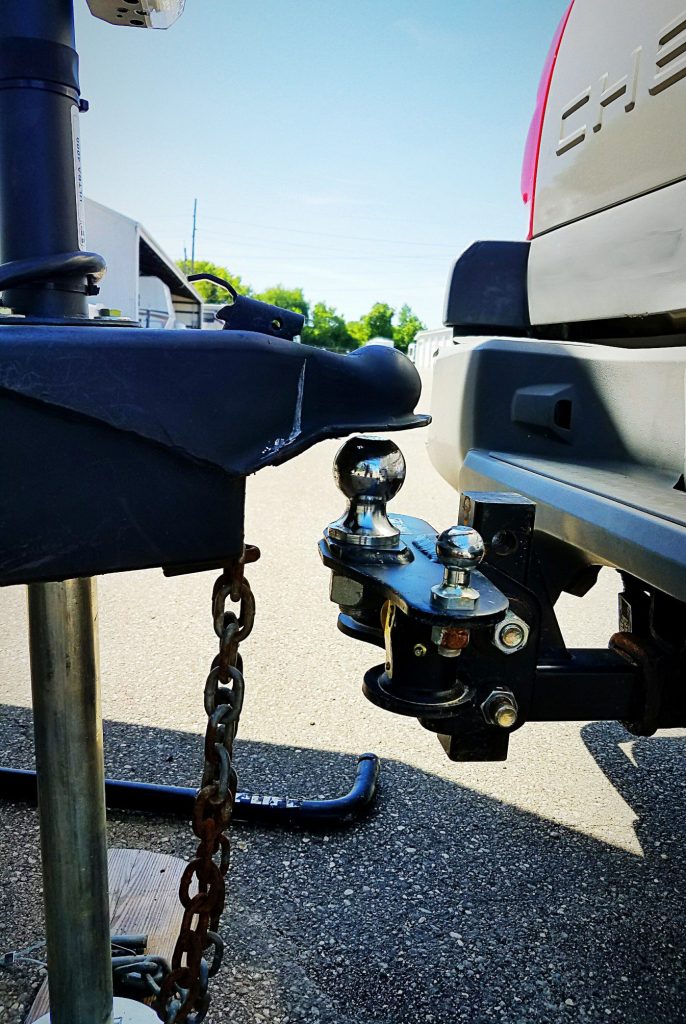
3. Use a Trailer Towing Checklist
A trailer towing checklist is a great way to make sure you never forget a single thing when towing your RV trailer. Towing checklists aren’t only good for beginners. Seasoned RVers should use a checklist, too.
You can find printable checklists online like this one from Getaway Couple . However, if you don’t want to keep track of paper, the Ultimate RV Checklist app is customizable for your RV and tow vehicle. You can find it on Google Play and the Apple App Store.
4. Load Your Trailer Weight Properly
When you load a trailer, place 60% of the cargo weight in the front half of the RV. Also, make sure the weight is even from side to side.
An improperly loaded trailer can be a serious safety concern. Stay within your trailer’s cargo carrying capacity and keep the weight near the front of the trailer to reduce sway and risk of blowouts.
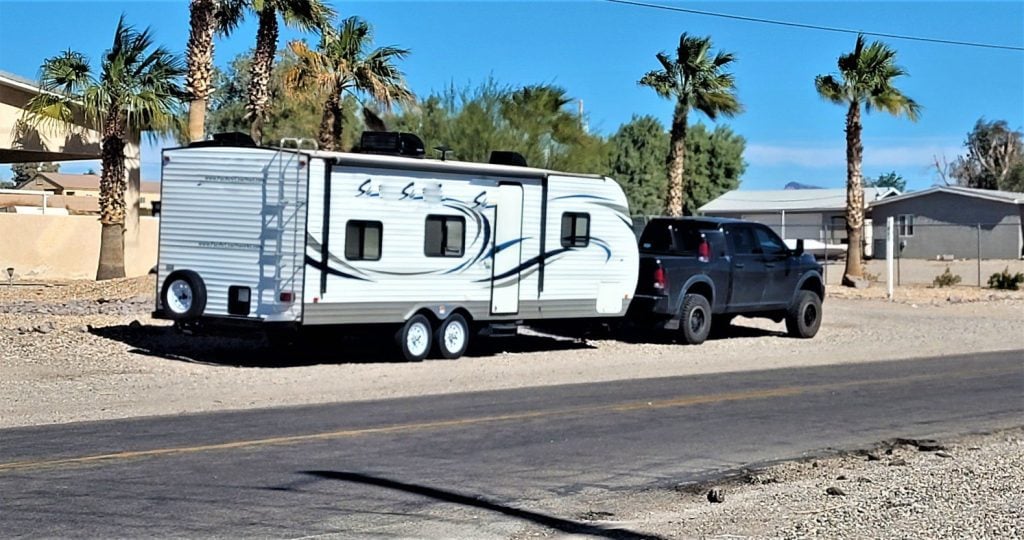
5. Drive Slowly When Towing
One of the best tips for any new RVer is to take it slow. Driving slowly gives you more control over your RV and will ensure you get to your destination safely. Slow driving also helps reduce the chance of trailer sway.
Don’t let other drivers intimidate you. Driving slowly keeps you and them safe.
6. Turn Wide and Slow
If it’s your first time towing an RV trailer, turns might be the most intimidating part. Your mirrors are the most important tool for towing an RV. Make your turns wide and slow, and give yourself plenty of room in the intersection and on both sides.
Use your mirrors to watch for cars, curbs, fire hydrants, and other obstacles. In addition, you can use your mirror and watch your tires as an indicator of when to turn your wheel.
It’s helpful to set up cones or other markers in an empty parking lot and practice making your turns.
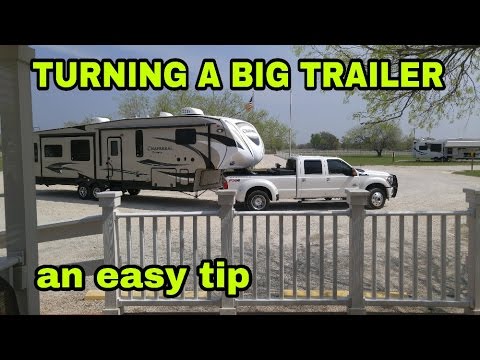
7. Give Yourself Plenty of Braking Room
An RV is heavy and takes a lot longer to come to a complete stop. When you attach an RV to your vehicle, you need a lot more braking room. Leave a lot of distance between yourself and the cars in front of you, and start braking well before you arrive at a stoplight or turn.
8. Use Sway Bar and Weight-Distribution Hitch
Sway is when your trailer sways back and forth behind your tow vehicle. When sway happens on a highway, it can escalate into a dangerous situation. Many things cause sway, including wind, passing cars, and improper weight distribution. A sway bar helps eliminate trailer sway.
Many RVers use sway bars in combination with a weight-distribution hitch. A weight-distribution hitch helps evenly distribute the weight of the RV trailer on the frame of the vehicle.
These hitches distribute weight for a safer and more comfortable towing experience.
Pro Tip : Here are the best RV Sway Bars this year.
9. Avoid RV Towing on Windy Days
Windy days are scary for any RVer, beginner or not. Wind can cause trailer sway, and it’s exhausting to drive in. If you can help it, avoid RV travel altogether on windy days.
Keep in mind: This is an RV guide for knowing when it’s too windy to drive .
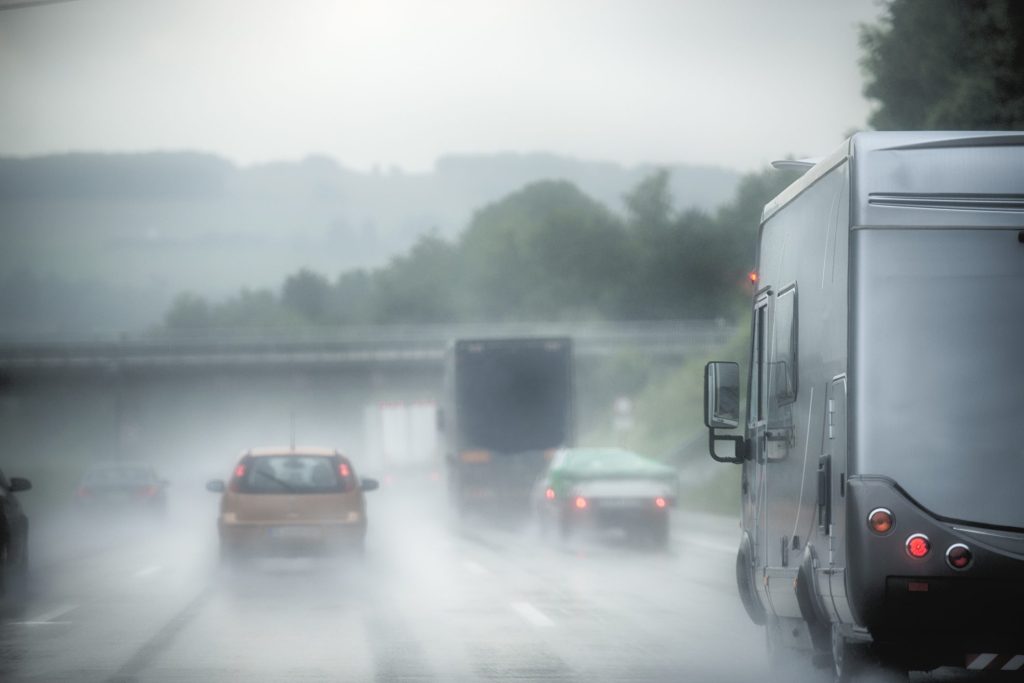
10. Follow the 2/2/2 Rule
The 2/2/2 rule is something RVers use to help prevent exhaustion and burnout on travel days . This rule states that you should drive no more than two hours a day or 200 miles and arrive at your campsite no later than 2 p.m.
When you follow the 2/2/2 rule, you give yourself plenty of time to get settled into your campsite, and you also don’t wear yourself out by driving too much. Some RVers also add that you should stop for at least two days at a time.
Alternatively, some RVers follow a similar 3/3/3 rule.
11. Only Camp in Pull-Through Sites While You’re Getting the Hang of It
Pull-through campsites are a beautiful thing for new and inexperienced RVers. There’s no need to back into these campsites; you simply pull right in! And when you leave, you drive straight out.
You can find pull-through campsites at many RV parks and campgrounds around the US.
Practice Makes Perfect
Towing an RV is intimidating at first, especially if you’ve never pulled a trailer before. But with time and practice, you’ll get the hang of it. There’s no shortage of helpful RVers on the road and in online communities.
What are your top tips for learning to tow an RV?
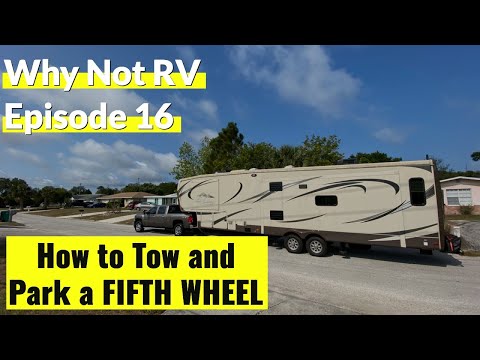
Discover the Best Free Camping Across the USA
To be honest with you, we hate paying for camping . There are so many free campsites in America (with complete privacy).
You should give it a try!
As a matter of fact, these free campsites are yours. Every time you pay federal taxes, you’re contributing to these lands.
Become a FREE CAMPING INSIDER and join the 100,000 campers who love to score the best site!
We’ll send you the 50 Best Free Campsites in the USA (one per state). Access the list by submitting your email below:

This post may contain affiliate links or mention our own products, please check out our disclosure policy .
Travel Trailer: Beginner’s Guide for Your First Trip
Published on December 15th, 2019 by Levi Henley (Full-Time RVer, Content Manager and Media Specialist for RV LIFE)
Okay, so we all begin somewhere and sometime. You’ve got your new travel trailer and are planning a trip into the great outdoors. Congratulations, you’ve made a big step in the right direction.
To ensure your trip is memorable, and for the right reasons, let’s ensure you’ve checked all the boxes.
What to Pack, How to Prepare, and Planning Tips for Your First Trip

I have a son and a daughter. When they first saw our new RV, they were super excited! They began jumping around and telling all of their friends we were going camping! My first camping experience was surreal so I wanted to make theirs just as extraordinary.
DON’T MISS OUT ON CAMPER SMARTS UPDATES
Sign up for the newsletter today.
Please enter a valid email address.
An error occurred. Please try again later.
Thank you for subscribing to the Camper Smarts newsletter, keep your eye on your inbox for updates.
However, once we reached our campsite, I noticed we had forgotten so many essential items. While my family was having fun around the campfire, I was busy with a notepad writing down all of the things I had forgotten.
So my first tip is the most obvious — but also the most overlooked. Plan accordingly and buy what you need, otherwise, you’ll likely have to go without.
There are three water tanks inside. The black tank is used for toilet water and other deposits. The gray is used for sink water. And there is a freshwater tank for the drinkable supply. The black and gray tanks will be empty as you set out and will need to be dumped before you head back home .
Before you head out, determine if you need to fill your fresh-water tank. My campsite had an RV station that provided free drinking water so I was able to forgo the process to save myself the extra weight. If you’re considering the same, call ahead to your campsite and make sure they provide this service.
Another packing tip is to store the heavy items (such as your generator) low to the ground and near the front of the trailer.
What You Should Know About Driving While Towing an RV
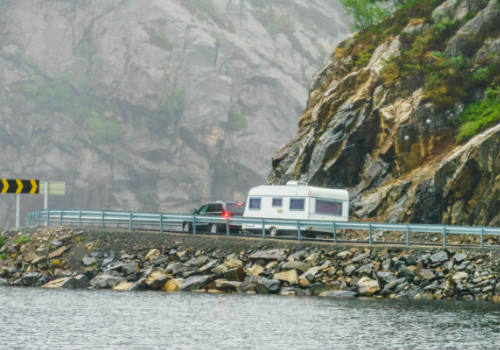
The first thing you should do is check how much weight your towing vehicle can tow. Most trucks and SUVs list this information on the driver door with a sticker. I have a 2012 Ford F-150 that can tow 11,500 pounds. Previously, I owned a 2010 Dodge Durango with a 7,200-pound towing capacity.
Once you check your truck, you need to check your trailer’s weight. There are three weights. The first is dry weight, which means how much the trailer weighs without any supplies or water. The second is the GVWR, or its weight once water and supplies are loaded. The third weight is called tongue weight. This refers to how much weight the trailer pushes onto the vehicle’s hitch. It is important that NONE of these figures is more than your truck’s towing capacity .
More than this, I highly recommend a 1,000-pound window between what you are towing and what your truck claims it can tow. Many truck-manufacturers buff this number up. Nobody wants to take a camping trip and destroy their engine or transmission on the road, especially with excited children in tow.
You should also make sure to note the truck hitch’s ball size. The majority of travel trailers use 5/8 of an inch, which is bigger than other trailers and boats.
When driving, be extra careful around tight turns on mountainous roads. Note the caution signs you see on the highway that display a trailer falling over. Yeah, those signs are for you now. I would be remiss to discount the large number of RVs that I have seen turned over onto their sides because of reckless driving.
Also, be careful of fishtailing, which is highly probable when a truck is towing an RV. I recommend that you install a hitch with weight distribution. A sway bar or suspension airbags will also do the trick. If you do happen to start fishtailing, be careful to avoid turning your wheel or slamming the brakes. Just remove your foot from the gas pedal and continue forward momentum. If your trailer is fitted with brakes, then give them a SLIGHT tap. Nothing too heavy.
When driving, also take special care of low hanging trees. Roads full of tree branches can be a nightmare for a trailer or any size.
Finally, avoid steep declines when driving. They will cause the trailer’s tongue to hit the ground and your stabilizers to bend.
What to Do at the Campsite
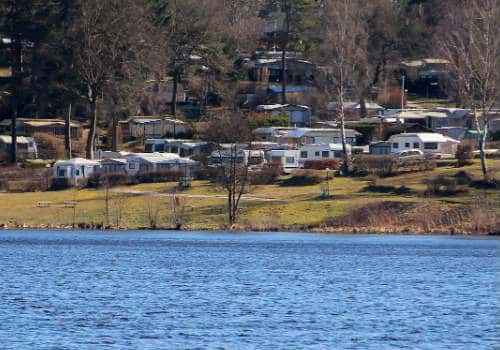
Make sure to park your trailer on the flattest ground possible. If the trailer is not level, you will feel odd when walking around. Beyond you feeling odd, the RV will also bounce a little with each step. More importantly, if you are parked upward or downward, you can damage the fridge inside the trailer.
My next point of advice is to unhook your trailer from the tow vehicle. This is because setting up the trailer is much easier when it’s not connected to the vehicle, as the stabilizers will connect with the ground below. Otherwise, you would have to match their contact with the hitch’s height. Also, with your truck free, you can explore the town or drive the children to the swimming hole.
Then, you must set up the stabilizers. Most travel trailers come with four. They are there to make sure the RV doesn’t bounce around when you walk inside. If you don’t install them, get ready to experience a shaky trailer each time someone uses the bathroom or turns to their side when sleeping.
The final point is to make sure that you have the proper power adapters if your campsite provides power. The common feature of travel trailers is 30 amps, but there are some with 15 or 50 amps. If you forgot the power adapter, or have the wrong one with you, then forget about connecting to the park’s provided power.
RV Power and HVAC
You must know that the travel trailer’s battery isn’t going to provide electricity to your air conditioning unit. For this, you need a generator with at least 3,000 watts of power. Also, it’s not a good idea to do any heavy electrical lifting when running the AC unit. This includes using the television or the microwave.
Of course, if you’re plugged into the park’s power, then you can forget this point entirely. Otherwise, if you plan on running all of the electrical devices in your trailer at once, be prepared to buy a massive generator.
When you’re using your generator, move it as far away from your trailer as possible. Several nice generators provide a quiet service, but most do not. If your generator is loud, check out this article on how to quiet it by up to 50% .
Your fridge can probably run using either electricity or propane. I prefer propane use if I’m driving or in a campground without power. Once I plug into the campground power outlet, though, I switch to electrical power. Some of these fridges, including mine, have an automatic setting that realizes when there’s connected power and shifts the power mode accordingly.
Water, Water, Water
Again, there are three liquid tanks in your RV: fresh, gray, and black. The fresh, as mentioned above, is for your drinking water. The gray will be filled with your shower and sink water. The black is for the toilet.
There’s a difference in water capacity for different trailers. Although I have a fairly big 43-gallon freshwater tank, there are four people in my family. If the campground doesn’t have shower installations, we can’t all take showers daily. This is something to consider ahead of time.
Don’t worry about the strange taste in the drinking water on the first use. It is completely normal (and healthy) and will pass after a few run-throughs.
I think it is a good idea to stock your RV with a hand-sanitizer. This is to prevent using too much water after going to the toilet. Also, be sure to turn off the water as you brush your teeth.
Post-Trip Information
Okay, so you’ve had a great first camping trip in your travel trailer. Now, you need to find an RV dump station. This can be a bit hard at first (especially on your own and during your first trip), but if you ask around, it shouldn’t be too painful of a process.
Upon arrival at the dump station, park before the dump hole so you can make sure that the trailer is on the right side. You’ll want to have purchased an RV dump hose because they don’t come with new trailers.
Once you connect one end of the dump hose to your trailer and place the other one into the hole, pull the black lever that can be found underneath your trailer. All of the accumulated sewage will spill forth, so you’re forewarned. Once the nastiness has washed away, remove the dump hose, wash it thoroughly, and store it.
Share this post:
Related posts:.

How to Create RV Workspaces and Family Entertainment Areas in a Travel Trailer

Airstream Trailers: What Makes Them Different and Who Should Get One

Review: Maximize Your RV Adventures with the Oupes MEGA 2 Portable Power Station
About the author:.

Levi Henley, RV LIFE’s Content Manager and WordPress specialist, is renowned for his expertise in RVing and workamping, having lived on the road since 2015. He’s the author of the popular guide “Seasonal Workamping for a Living: How We Did It” , a testament to his deep knowledge in the RV community. For more insights into Levi’s nomadic lifestyle and expertise, visit Henley’s Happy Trails .
Levi Henley: Content Manager, Media Specialist at RV LIFE
Levi Henley stands at the forefront of RV-centric content, wearing multiple hats as a Content Manager and Media Specialist for the RV LIFE network. With his deep-rooted expertise in RVing, workamping, and the full-time nomadic lifestyle, Levi has been writing about and living the lifestyle since he hit the road in 2015 with his wife Natalie.
Their journey, punctuated by innovative approaches to nomadic income, has culminated in the guide, " Seasonal Workamping for a Living: How We Did It ," a testament to their hands-on experience and knowledge. This resource, available on Amazon and through their personal website, Henley's Happy Trails , offers invaluable insights into the mobile lifestyle. Levi's has written for RV industry media key organizations like Coach-Net, Escapees, and Workamper News.
Beyond his professional prowess, Levi is a man of diverse talents and interests. He's not only an actor and magician but also a certified scuba diving instructor. His adventures across the country in a 2011 Sunstar Itasca, accompanied by Natalie and their two feline companions and rambunctious dog, embody the spirit of exploration and lifelong learning.
1 thought on “Travel Trailer: Beginner’s Guide for Your First Trip”
Great article, some good stuff there
Comments are closed.
Follow Camper Smarts:
- Follow Us On Facebook
- Follow Us On Twitter
- Follow Our Pins

IMAGES
VIDEO
COMMENTS
In this case, towing 10,000 lbs will exceed your truck's GVCW, or gross vehicle combined weight (the total allowable weight of the car, passengers, cargo, payload, and trailers), so it is unsafe ...
"Yes, they're going to need help, but at the same time, it's gonna be their life in their own way." National Geographic has revealed an official trailer for a documentary film titled Blink ...
The towing bill of rights, signed into law at the end of the 2022 session, requires tow companies to release a car to the owner for 15% of the total cost or $60, whichever is greater, with an ...
John & Yoko in NYC! Mercury Studios has revealed a first look teaser trailer for a compelling documentary film titled One To One: John & Yoko, which is premiering now at the 2024 Venice Film Festival.
Smile 2: Directed by Parker Finn. With Kyle Gallner, Naomi Scott, Rosemarie DeWitt, Lukas Gage. About to embark on a world tour, global pop sensation Skye Riley begins experiencing increasingly terrifying and inexplicable events. Overwhelmed by the escalating horrors and the pressures of fame, Skye is forced to face her past.
Babygirl: Directed by Halina Reijn. With Nicole Kidman, Harris Dickinson, Antonio Banderas, Sophie Wilde. A high-powered CEO puts her career and family on the line when she begins a torrid affair with her much younger intern.
Patricia, 87, was a former opera singer and vocal coach of Irish-American descent. In Carey's 2020 memoir, The Meaning of Mariah Carey, the five-time Grammy Award-winning singer detailed her ...
Before you pick up your trailer 1. Buy tow mirrors. Fun fact: Unless you're driving a massive tow vehicle that's wider than your trailer, it's likely that all of the mirrors on it will be largely useless while you're driving with a 16-foot plus box behind you.Thankfully, there are extendable mirrors that clip on to your tow vehicle's existing mirrors, like these ones, which allow ...
This article is a travel trailer towing guide for new Rvers. Lets explore all the in-and-outs about towing a travel trailer or 5th wheel. Towing trailer for the first time. What you need for towing. Towing a travel trailer in itself is a challenge even if you have been doing it for years.
But towing a travel trailer can bring some unexpected drama and safety concerns for millions of first-time RVers. Trailers add weight to the back of the tow vehicle, and that added weight changes the handling dynamics and braking of the tow vehicle. That's why you need to make sure your trailer and tow vehicle are properly matched. This guide ...
Follow these steps to get started. 1. Attach Trailer to Tow Vehicle. Using a tongue jack, raise the trailer so you can align the tow vehicle's hitch ball underneath the trailer tongue. When the hitch lock is aligned with the ball, lower the trailer tongue onto the ball and lock it in.
How to drive while towing. Taking your trailer on that first trip is an exciting but nerve-wracking experience. I still remember my sweaty palms and the butterflies in my tummy the first time I merged into Atlanta's 16-lane highway traffic with my 22-foot trailer. I had an incident-free towing experience, so let's do our best to ensure you ...
Trailer hitch ball sizes should match the size of the trailer. 4. Stop the Sway. You don't want your trailer to sway to the music or otherwise: to avoid trailer sway, place heavier cargo forward, in front of the trailer's axle. Also center the cargo and tie it down, because shifting causes sway too.
Now, for the first time travel trailer tips and tricks: 1. Pack everything in totes. Put food, bedding, and camper parts in separate totes. Once you get to camp you can unpack all that needs to get put away. Then all the totes can go outside and be stored under the travel trailer.
Towing a Travel Trailer. The first thing to know about towing a travel trailer is you can't go as fast as you would otherwise. Most trailer tires are rated for 65 MPH. A higher driving speed significantly reduces your braking speed and stopping distance. That means it is a lot easier for you to rear-end someone if they stop suddenly.
Towing a Travel Trailer for the First Time. If you have never done this before, this section is for you. If you follow these tips, you should not have any trouble. Before you even purchase the travel trailer, you must ensure it is a good fit for the vehicle used in the towing process. If the trailer is too big, it will never work.
Boat Portlights. In this guide, we'll walk through some key steps for how to tow a travel trailer for the first time, including choosing the right towing equipment, prepping your vehicle and trailer for the journey an.
Towing a travel trailer is generally pretty easy if you know what to expect. This article will cover the basics you need to know and help you be ready for your first towing experience. It can be scary at first. But before long, you will feel comfortable and confident behind the wheel. ... Candid look at one first-time RV owner's mistakes RV ...
10 Common-Sense Trailer Towing Tips. Towing 101 is the ultimate trailer towing guide. It is designed to equip you with the knowledge and confidence to successfully tow a trailer with your vehicle. This tow guide is perfect for any first time trailer owner, as well as seasoned veterans looking for a refresher. It offers some of the most helpful ...
Coachmen's Apex Tera 15T is the smallest in its Apex lightweight line, and was designed with adventure travelers and small families in mind. This easy to pull travel trailer measures 18 feet, 7 inches, and weighs 2,862 pounds dry. It can be pulled with half ton trucks, minivans, and SUVs, as long as they have a towing capacity of 4,000 pounds.
A Generator - A generator is an obvious item for this checklist, but you'll want to buy one that's high quality and will last. Check out the Champion Generator. 2 and 5/16″ Trailer Ball - Make sure to have the right size trailer ball installed on your vehicle to tow your trailer. 3/4 Drill Socket and Drill - Drills will allow you to ...
With SumoSprings, your towing vehicle and trailer can operate more harmoniously, creating a safer and more comfortable journey. 10. Take It Slow. Patience is the golden rule when towing a travel trailer for the first time. Slow down, enjoy the scenery, and embrace the journey.
There are a few things to be aware of before hitting the road for the first time. First and foremost, it's recommended that all passengers - including dogs and cats - be in the tow vehicle during travel. It's not only illegal for passengers to ride in the travel trailer in some areas, but it can also be dangerous. Things may fall or shift ...
Reduce your normal speed by 10 to 20 miles per hour when towing a travel trailer. That means doing 60 instead of 70 on major highways and reducing your speed even further on smaller, windier roads. The tires on most travel trailers are rated for 60 to 65 miles per hour.
Admittedly, towing a travel trailer for the first time was the most nerve wracking part of our decision to purchase an RV. If done incorrectly it can be a true safety hazard. But with a little education, and tips from fellow newbies you can confidently hook up your travel trailer and start exploring.
Signal well in advance, check for sufficient gaps in traffic, and accelerate gradually to complete the maneuver safely. Be aware of your trailer's length and account for the additional time needed to pass or merge. Stay Focused and Avoid Distractions: Towing a travel trailer demands your full attention on the road.
Here are 11 of the best tips for RV towing for beginners. 1. First: Practice RV Towing! First thing's first when you're learning to tow an RV trailer: Practice! It's best to practice towing your trailer on roads with little traffic or in empty parking lots. Taking your RV to a large, empty parking lot is a great way to practice backing up ...
"Towable RVs, including travel trailers and pop-ups, serve as the gateway to RV recreation for most people," says Trailer Life Technical Editor Chris Dougherty. "Colloquially described as a 'bumper pull,' the first camping travel trailers were hitched to the tow vehicle's bumper. "We've come a long way since those early days of the 1950s.
The first thing you should do is check how much weight your towing vehicle can tow. Most trucks and SUVs list this information on the driver door with a sticker. I have a 2012 Ford F-150 that can tow 11,500 pounds. Previously, I owned a 2010 Dodge Durango with a 7,200-pound towing capacity.
There are five different classes of conventional hitches most travel trailers use when it comes to towing a trailer: Class 1: Up to 2,000 pounds. Class 2: Up to 3,500 pounds. Class 3: Up to 8,000 pounds. Class 4: Up to 10,000 pounds. Class 5: Up to 12,000 pounds. Most cars and crossovers come with Class 1, 2 or 3 hitches, while larger trucks ...